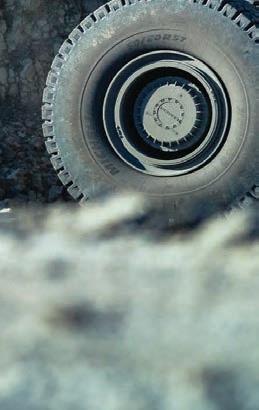VOLUME 117/10 | NOVEMBER 2025



AIMEX 2025 ROUND-UP
COPPER SPOTLIGHT



TECHNOLOGIES TRANSFORMING HOW THE INDUSTRY MANAGES WASTE?








VOLUME 117/10 | NOVEMBER 2025



AIMEX 2025 ROUND-UP
COPPER SPOTLIGHT



TECHNOLOGIES TRANSFORMING HOW THE INDUSTRY MANAGES WASTE?







Across Australia’s resources landscape, the question of how waste is managed has become one of the defining challenges of modern mining. It is no longer a peripheral consideration, nor a matter of simple compliance. Effective waste management sits at the heart of what it means to operate responsibly, efficiently and sustainably in today’s industry.
The evolution has been driven by necessity. As mines grow deeper and processing becomes more complex, the scale of waste increases. Tailings, waste rock and by-products can represent the largest physical footprint of any operation. How these materials are handled – stored, treated, reused or rehabilitated –goes a long way in shaping a company’s environmental legacy and social licence to operate.
In the past, waste management was often viewed through a somewhat narrow technical lens: a cost of production, a by-product to contain. Today, however, it is increasingly recognised as a strategic opportunity.
Advancements in engineering, monitoring and material recovery are reframing waste not simply as a liability but as a potential resource. Tailings reprocessing, for example, can recover valuable minerals while reducing environmental risks. Similarly, improved water recovery and dry-stack tailings systems are helping to reduce operational footprints and conserve vital water resources in arid regions.
The shift also reflects broader expectations around environmental, social and governance (ESG) performance. Investors, regulators and communities now expect mining companies to demonstrate transparency and accountability in how they manage waste. Reporting frameworks, independent audits and global standards are establishing a new baseline for best practice.
Australia’s mining sector has responded with innovation. Modern tailings facilities are designed with long-term closure and rehabilitation in mind, incorporating advanced geotechnical and hydrological modelling.
Operators are investing in real-time monitoring systems to detect and mitigate risks early, while progressive rehabilitation is increasingly being integrated into the mine life cycle rather than left to closure.
CHAIRMAN JOHN MURPHY
CHIEF EXECUTIVE OFFICER CHRISTINE CLANCY
MANAGING EDITOR PAUL HAYES
Email: paul.hayes@primecreative.com.au
ASSISTANT EDITOR
ENGEL SCHMIDL
Email: engelbert.schmidl@primecreative.com.au
COVER IMAGE: Darren - stock.adobe.com
JOURNALISTS
DYLAN BROWN
Email: dylan.brown@primecreative.com.au
PAUL HOWELL
Email: paul.howell@primecreative.com.au
BEN CARTWRIGHT
Email: ben.cartwright@primecreative.com.au
ETHAN BENEDICTO
Email: ethan.benedicto@primecreative.com.au
CLIENT SUCCESS MANAGER
JANINE CLEMENTS
Tel: (02) 9439 7227
Email: janine.clements@primecreative.com.au
SALES MANAGER
JONATHAN DUCKETT
Mob: 0498 091 027
Email: jonathan.duckett@primecreative.com.au
This growing sophistication reflects a broader cultural change within the sector. Waste management is now viewed as an essential part of business resilience rather than as a secondary operational concern. Mines that manage waste effectively tend to operate more efficiently, face fewer regulatory hurdles, and maintain stronger community relationships.
Importantly, the conversation on waste management also speaks to the future of mining itself. As demand rises for the minerals critical to renewable energy and technology – lithium, copper, nickel, rare earths, et al – Australia’s production volumes are expected to increase. With that comes the responsibility to ensure the environmental impact of extraction does not outweigh the benefits of decarbonisation and technological progress.
Sustainable waste management provides the bridge between these two imperatives. It enables continued resource development while minimising long-term environmental footprints and ensuring mined lands can be safely and productively repurposed. It also demonstrates that mining can adapt and innovate in response to global sustainability pressures, rather than resist them.
What is emerging is a more holistic approach to resource development, one where efficiency, safety and stewardship are intertwined. In this context, the management of mine waste becomes a measure of technical development and ethical responsibility. It represents how the industry chooses to define success: not solely by tonnes produced or profits earned, but by the legacy it leaves behind.
Mining has always been an industry of transformation, of landscapes, economies and technologies. Waste management is now part of that transformation, evolving from an operational challenge to a defining characteristic of modern mining excellence in Australia.

Paul Hayes Managing Editor
BUSINESS DEVELOPMENT MANAGERS
JAMES PHIPPS Mob: 0466 005 715
Email: james.phipps@primecreative.com.au
ROB O’BRYAN
Mob: 0411 067 795
Email: robert.obryan@primecreative.com.au
ART DIRECTOR MICHELLE WESTON michelle.weston@primecreative.com.au
SUBSCRIPTION RATES Australia (surface mail) $120.00 (incl GST) Overseas A$149.00
For subscriptions enquiries please contact (03) 9690 8766 subscriptions@primecreative.com.au
Serving the mining industry across Australia. Whether you’re in Western Australia’s iron ore heartland, the coal fields of Queensland, or the mineral-rich regions of New South Wales and South Australia, our regional service centres are ready to support you with expertise, repair and machining services.
FLS’s state-of-the-art Service Centres in Australia are strategically located near major mining regions.
You can be sure our team is ready to meet your needs by providing the most suitable parts and services required to safely and efficiently assist you in keeping your equipment up and running, maximising up time and boosting productivity.
www.fls.com
■ Reduce downtime - mining experts on your doorstep, for planned maintenance or an unplanned outage
■ Local machining facilities - reduce lead time for spare and wear parts, repairs, rebuilds, exchanges
■ One-stop-shop supports performance improvement –training, engineering or onsite support





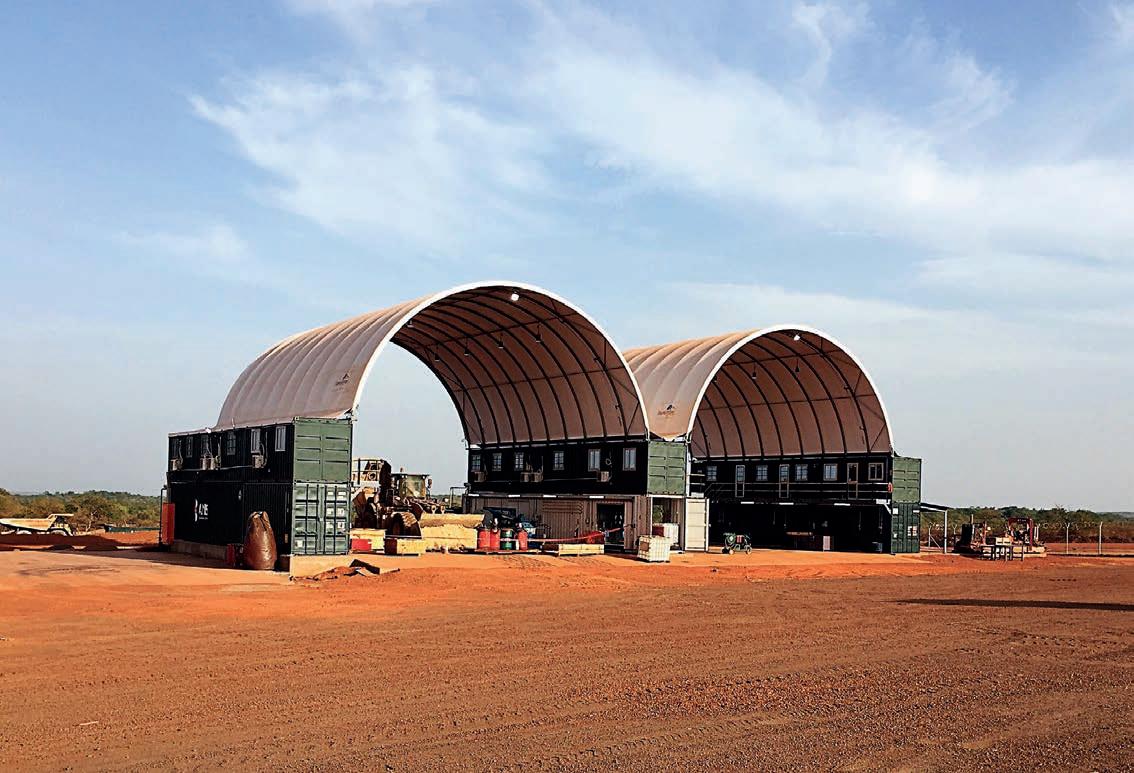
AIMEX 2025 delivered a landmark showcase for Australia’s mining sector, transforming Adelaide into the centre of dialogue, innovation and recognition for three dynamic days.
12 MINE WASTE MANAGEMENT
Australia’s mine waste makeover
With immense volumes, long lifespans and complex environmental legacies, mine waste has always been one of the mining sector’s defining challenges.
16 MINE WASTE MANAGEMENT
Clutch S.H.O.T.
A collaboration between Jenike & Johanson and Crescend Technologies promises a major breakthrough in the ore treatment process.
20 MINE WASTE MANAGEMENT
Smooth operator
The same ultra-smooth material that helps artificial joints move freely is now solving one of mining’s most persistent headaches.
24 MINE WASTE MANAGEMENT
A new era for flotation
Flotation has long been one of the most powerful and adaptable concentration methods in mineral processing, and its importance is only set to grow.
34 SHELTER
The shelter built for extreme conditions
DomeShelter Australia’s engineered fabric structures are providing mining operations with durable and relocatable infrastructure solutions wherever they’re needed.
40 INDUSTRY INSIGHT
A major copper-tunity
With the global energy transition fuelling unprecedented demand for copper, SA’s vast mineral wealth is positioning the state as a cornerstone of a decarbonised future.
58 GREEN IRON
Forging Australia’s green iron future Green iron is on the global mining agenda, with companies like Bedeschi creating the path forward through technical excellence and design versatility
74 MINING MACHINERY
‘Instrumental’ equipment for mining operations
Liebherr continues to lead the way in giving miners the edge with its new hydrostatic dozer.



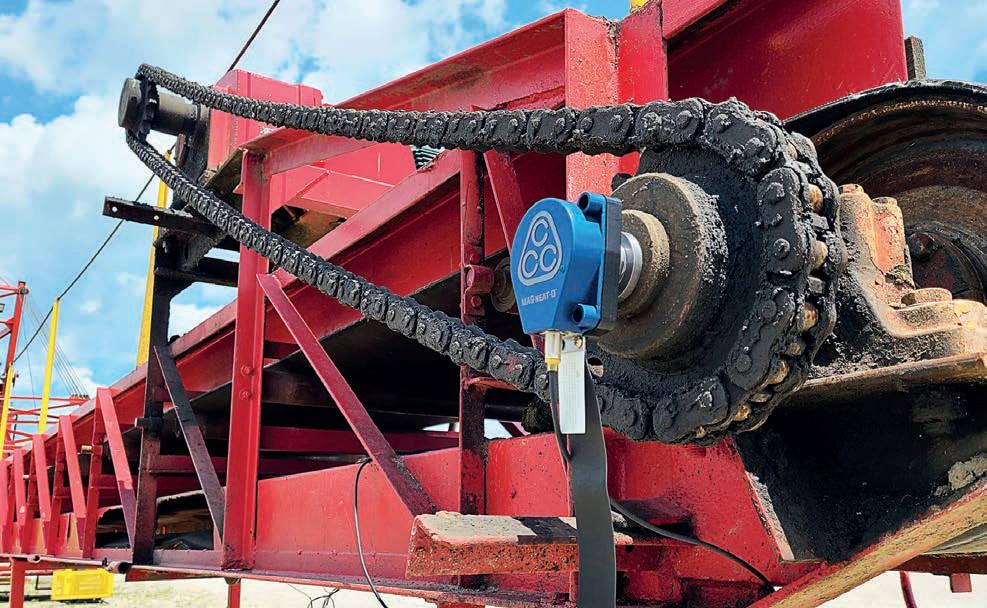






KEEP UP WITH THE LATEST EXECUTIVE MOVEMENTS ACROSS THE MINING SECTOR, FEATURING RIO TINTO, PERENTI, PEMBROKE RESOURCES AND MORE.
Rio Tinto recently appointed a former trainee from its Local Aboriginal Person (LAP) program as manager of its Amrun bauxite mine in far north Queensland.
Shiona Budby, a long-serving member of the team and proud Thanikwithi woman, will lead a team of more than 300 employees after beginning her career more than 10 years ago.
Budby said her aim is to inspire future LAP leaders to feel confident in who they are and where they come from, and to empower them to lead with strength and pride in their culture.
The LAP program has run since 2002, with more than 300 Indigenous participants taking part since it first started.
“Building strong relationships through shared lived experiences is the foundation of productivity and success,” Budby said.
“To me, being a manager means creating strong foundations that enable people to succeed in their roles.”
Budby described her leadership style as one grounded in empathy and collaboration, while having a deep commitment to empowering others.
“Shiona’s appointment marks a
significant step forward in building a more inclusive and representative future for our operations and our communities,” Rio Tinto general manager of Weipa operations Steve Dunstone said.
“This achievement is not only a testament to Shiona’s leadership, dedication, and deep connection to Country, but also a powerful symbol of progress.”
Rio Tinto recently began early works and final engineering studies to increase Amrun’s production capacity, aiming for first output in 2029.
Perenti has started a succession process that will see current managing director and chief executive officer (CEO) Mark Norwell step down from his position by the end of the year.
The Perenti board has initiated a comprehensive internal and external search for a successor to lead the company into its next phase of growth.
The company said the board and Norwell considered it an appropriate time to commence a succession process, following the successful delivery of the company’s 2025 strategy.
Perenti’s growth in recent years has given it significant scale and balance sheet strength, providing a new managing director and CEO with a robust platform to deliver future growth.
Norwell remains fully engaged and will work with the board and his successor (once determined) during a dedicated handover period. The company said he is committed to ensuring a seamless leadership transition and continuity across the business.
The transition process is expected to commence in the first half of 2026.
Pembroke Resources has announced Michael Rosengren as its new CEO following the company’s founder stepping down from executive responsibilities.
Rosengren brings decades of technical and operational mining expertise to the role and will lead the company’s next phase of growth.
The company said it is looking to consolidate production and advance the second-phase expansion of the Olive Downs Complex in the Bowen Basin of Queensland.
As one of Australia’s leading steelmaking coal mines, the Olive Downs Complex is a cornerstone asset for Pembroke with strong reserves and expansion potential to support growth for years to come.
Rosengren has extensive experience managing resource assets, previously holding leadership positions at BHP, Thiess and Mount Isa Mines. He most

recently held the position of managing director at QMetco.
Barry Tudor, who founded Pembroke in 2014, has stepped down from leadership after more than a decade, but will still maintain a board seat to provide “a seamless transition”.
Mineral Resources (MinRes) has appointed a new company secretary as it looks to bolster its governance regime.
MinRes announced the appointment of Sarah Standish as joint company secretary alongside Derek Oelofse.
Standish has 20 years’ experience in leading legal, governance, risk and compliance functions at ASX-listed and international companies involved in the mining and energy sectors.
She has held senior in-house legal and company secretary roles, most recently as general counsel and company secretary at De Grey Mining, which was acquired by Northern Star Resources in May.
Standish has also previously served as general counsel and company secretary at St Barbara, general counsel at Imdex and is a graduate of the Australian Institute of Company Directors.
Standish replaces Mark Wilson, who resigned from the role of joint company secretary. Wilson will continue in his role as the company’s chief financial officer. AM


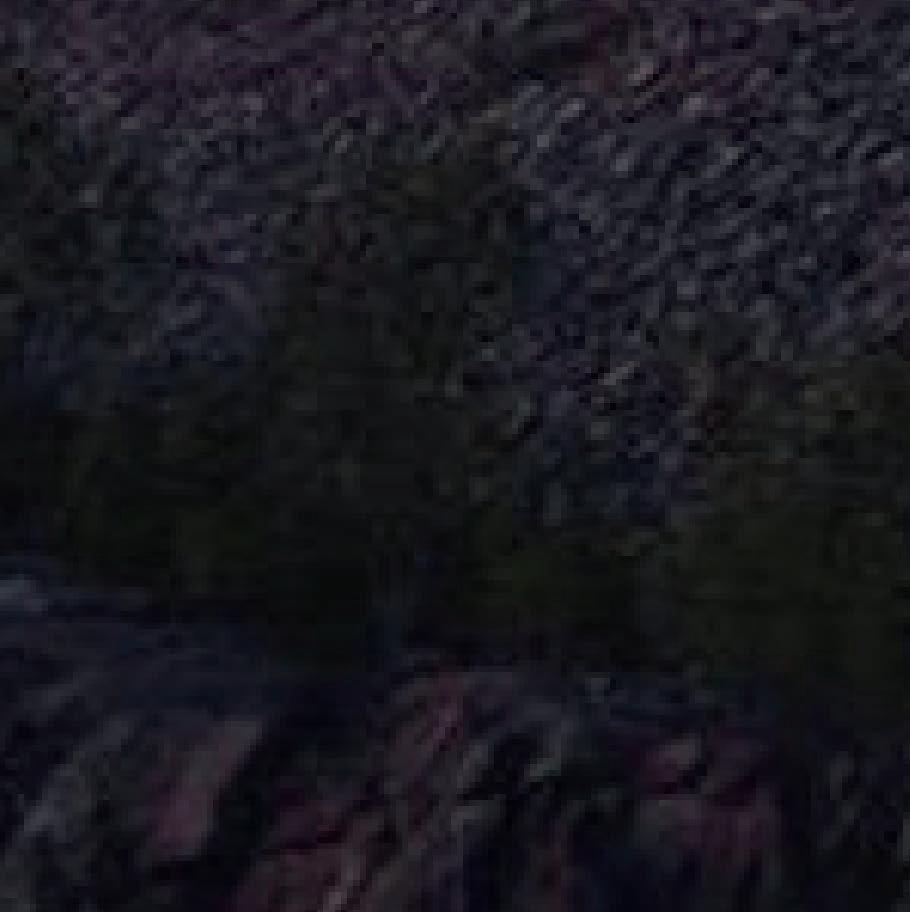


























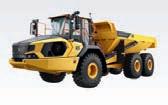













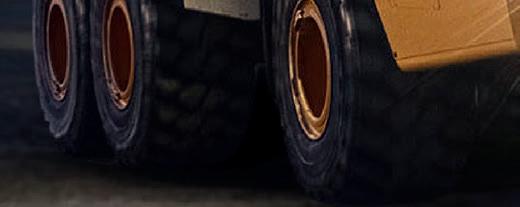































AIMEX 2025 DELIVERED A LANDMARK SHOWCASE FOR AUSTRALIA’S MINING SECTOR, TRANSFORMING ADELAIDE INTO THE CENTRE OF DIALOGUE, INNOVATION AND RECOGNITION FOR THREE DYNAMIC DAYS.
With its move to South Australia, Asia-Pacific’s International Mining Exhibition (AIMEX) entered a new chapter, one defined by collaboration, fresh perspectives and a genuine sense of momentum.
Held at the Adelaide Showground from September 23–25, the event combined technical insight with industry celebration, uniting thought leaders, suppliers and operators around the shared goal of advancing the resources sector.

Setting the tone for progress
South Australian Treasurer and Minister for Energy and Mining
Tom Koutsantonis officially opened the event by championing the state’s growing prominence on the global mining stage. He highlighted copper as an economic powerhouse and a cornerstone of future growth.
“South Australia’s largest exported commodity is copper, both refined and concentrates,” he said during his keynote address. “That was up 17 per cent on the previous year, which reaped for our state a record of $4.3 billion in copper exports.”
Koutsantonis described how the state’s resource base, evolving infrastructure and investment pipeline are positioning South Australia as a magnet for new exploration and development, particularly across copper and critical minerals. His message set an upbeat tone that carried through the rest of AIMEX 2025.
BHP group procurement officer
Rashpal Bhatti captured the audience’s attention on day two with a keynote that helped to further crystallise the central role of copper in the Australian and global energy transition. Bhatti outlined a bold strategy for scaling production
and building smarter, technology-driven supply chains to meet surging demand.
“We are part of that copper revolution,” Bhatti said. “And if you thought that the electrification revolution was only in the early 1900s, you’re mistaken.
“We are in the midst of the second electrification revolution here and now, and the demand for copper in that electrification revolution is paramount.”
Bhatti’s address positioned copper not just as a commodity but as an enabler of a cleaner, electrified future – a theme that echoed across many of the conference’s discussions.

South Australian Chamber of Mines and Energy (SACOME) chief executive officer Nicola McFarlane opened the final day with a reminder that the global push for decarbonisation depends on the success of the mining industry.
Her comments reflected a recurring idea throughout AIMEX 2025: that mining’s future will be built on technological advancement, environmental accountability and strong partnerships across the supply chain.
Technology, safety, collaboration and excellence AIMEX’s diverse conference program went beyond policy and production, exploring the technologies that are helping to reshape mine operations. From artificial intelligence (AI) and automation to data-driven safety systems, the sessions provided practical insights into how digital tools are enhancing decision-making and risk management.
The ‘Tailoring solutions to unique mine site challenges’ panel was among the event’s standouts. It examined
BHP GROUP PROCUREMENT OFFICER RASHPAL BHATTI OUTLINED A BOLD COPPER STRATEGY.

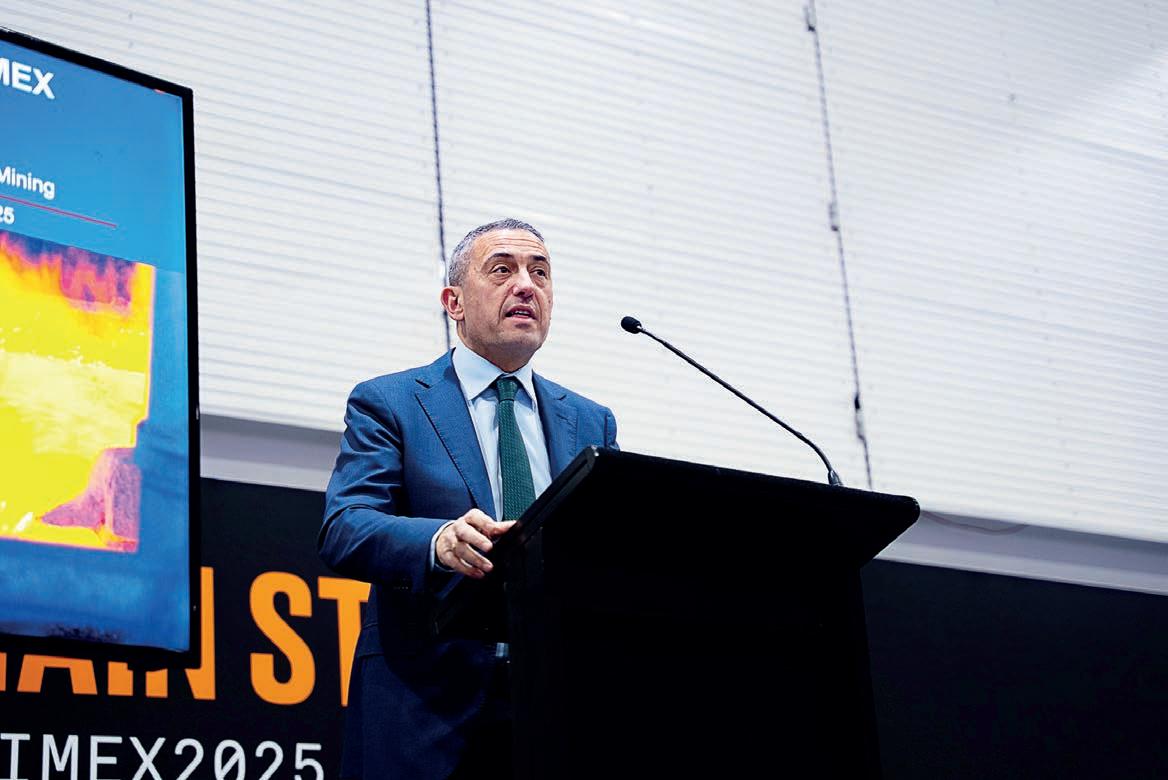

that Adelaide got AIMEX this year,” she told Australian Mining on the exhibition floor.
“We’ve loved AIMEX and really appreciate how good the Prime Creative team has been to work with. We’ve really enjoyed it, and we’ve got a lot out of it.”
That appreciation was not limited to local exhibitors.
THE CONFERENCE PROGRAM DELIVERED INSIGHTFUL PANELS AND PRESENTATIONS.

WE’VE LOVED AIMEX AND REALLY APPRECIATE HOW GOOD THE PRIME CREATIVE TEAM HAS BEEN TO WORK WITH. WE’VE REALLY ENJOYED IT, AND WE’VE GOT A LOT OUT OF IT.”
The exhibition floor, filled with new technology zones and futurefocused displays, showcased the state’s ambition to lead the next generation of mining excellence.
For exhibitor Grace Frayne, marketing coordinator of Adelaidebased RTS Group Australasia, the move to South Australia was a very welcome one
“As a brand, we really wanted to establish our footprint and make sure that people know this is our home turf, so it’s very exciting
“We’re a national business, but we do have a number of Motion branch business segments in Adelaide, so the show was important from a local aspect,” Motion Asia Pacific managing director of national business Darrin Sergeant told Australian Mining.
“We had a good spread of customers and visitors from all over the country – Perth, New South Wales and Queensland – and we had some good leads across the total Motion product range.”
By the close of AIMEX 2025, one message was clear: Australia’s mining sector is not standing still. It is advancing with purpose, supported by visionaries, innovators and communities that see opportunity in transformation.
From Koutsantonis’ optimism and Bhatti’s copper blueprint to McFarlane’s call for growth through sustainability, AIMEX 2025 captured the spirit of a sector in renewal. The event acted as a declaration that Australian mining’s next chapter is one of insight, innovation and shared success. AM


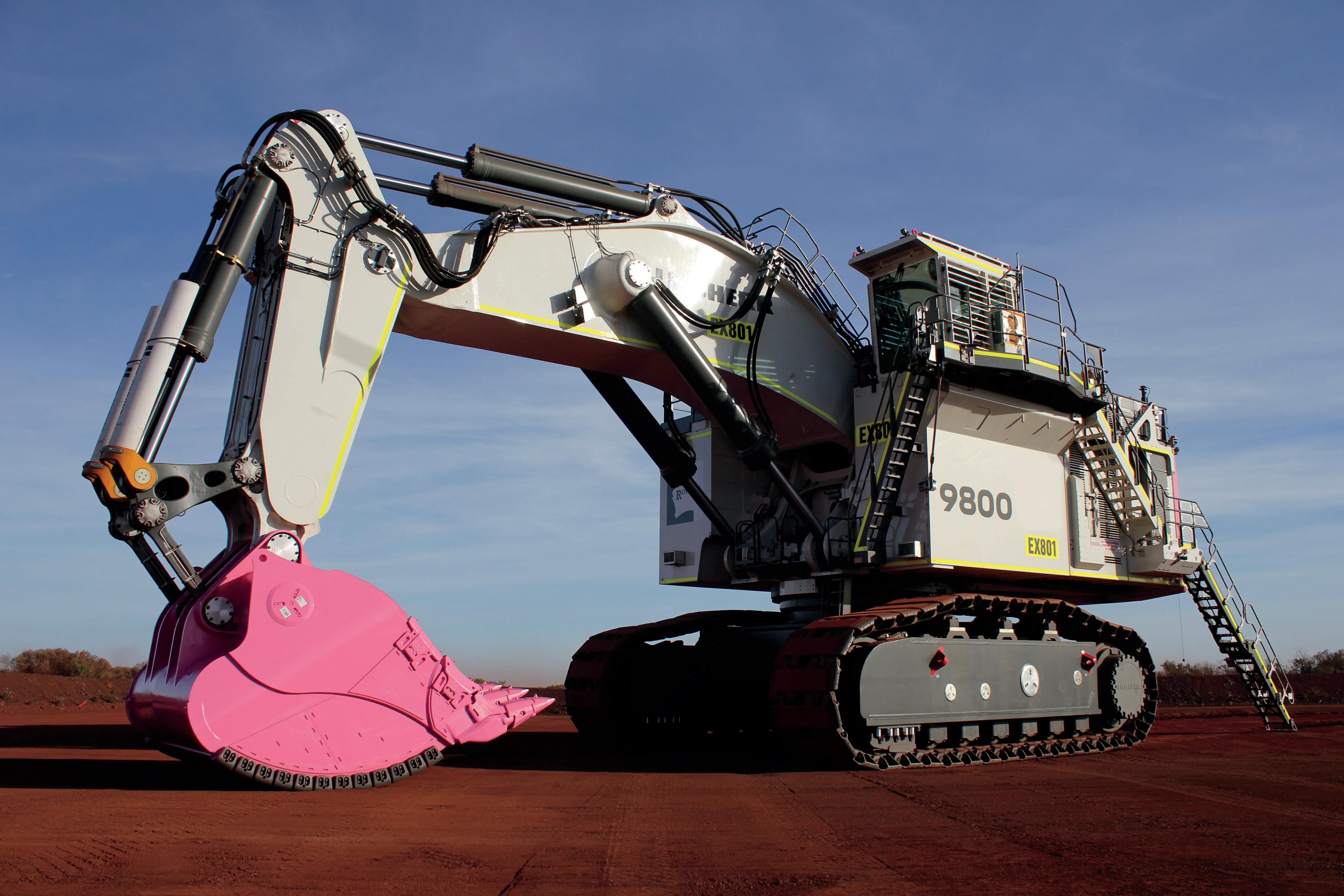




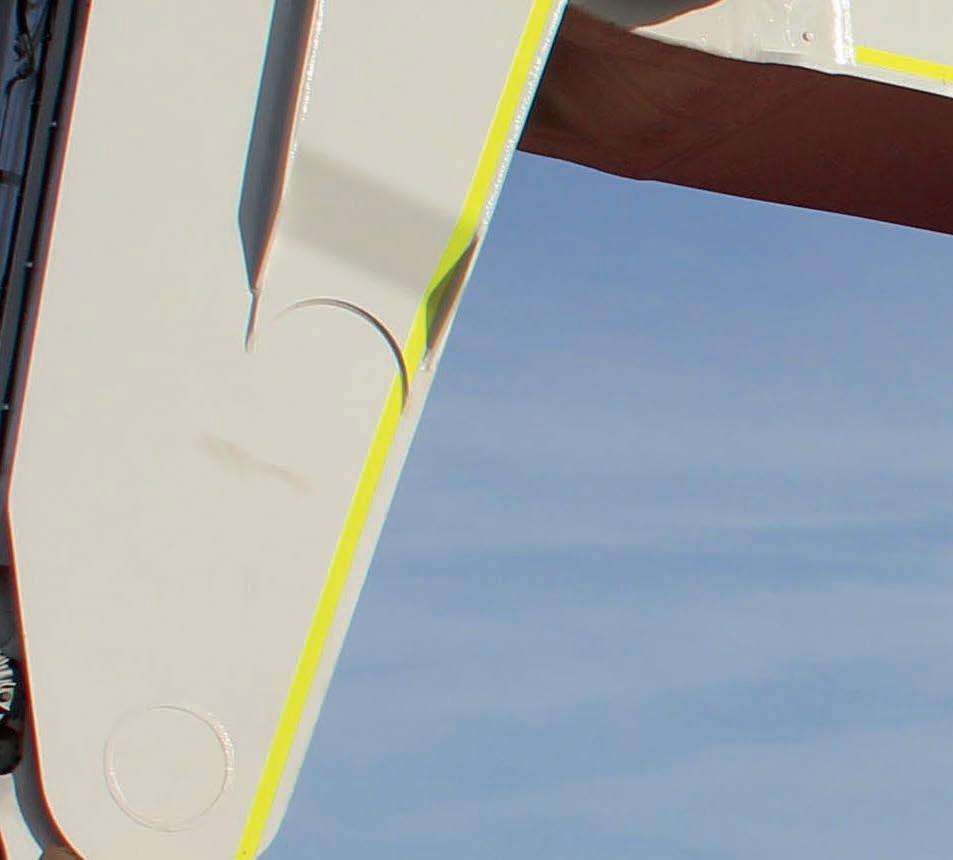





WITH IMMENSE VOLUMES, LONG LIFESPANS AND COMPLEX ENVIRONMENTAL LEGACIES, MINE WASTE HAS LONG BEEN ONE OF THE SECTOR’S DEFINING CHALLENGES.
Australia’s modern mining industry is meeting the challenge of mine waste with a new generation of technologies, practices and partnerships that are reshaping how waste is handled from the moment ore is extracted to decades after a pit is closed.
The story is not one of neat fixes but of pragmatic, measurable progress, and an industry increasingly confident it can meet environmental, social and governance (ESG) expectations while continuing to underpin the national economy.
Designing waste out of the loop
A fundamental shift is happening at the design stage. Modern projects now plan for waste management as an integral part of mine design rather than
as an afterthought. This means smaller footprints for waste storage, higher containment standards, and processes that prioritise water recovery and reuse from day one.
Thickened and filtered tailings are replacing loose slurry in many new developments. These approaches help to reduce the need for large tailings ponds, lower water use and create a more stable material that can be placed in engineered landforms or returned underground. The net effect is a reduction in long-term liability and improved operational flexibility. Design-led thinking is also enabling co-location and multiple-use approaches. Waste rock and processed residue are increasingly viewed as potential inputs for construction materials, road base and other local uses, turning what was waste into value for regional
communities while reducing transport and rehabilitation costs.
Digital technology has moved from pilot stage into routine use across the field. Remote sensing, drones and satellite monitoring now allow operators and regulators to monitor large waste facilities with greater frequency and precision than ever before.
Satellite imagery, aerial surveys and automated drone flights give teams detailed deformation and volumetric data; real-time geotechnical sensors embedded in dams and waste stacks provide early warning of seepage or movement. These feeds are increasingly combined into digital twins, virtual replicas of assets that enable scenario testing, predictive maintenance and faster response planning.
Artificial intelligence (AI) and machine learning are being layered on top of these data streams to flag
anomalies and model stability under extreme weather scenarios. The value is twofold: improved safety and a stronger evidentiary record for environmental compliance and community reporting. One of the most constructive trends is the reappraisal of legacy tailings and waste rock. Advances in mineral processing, hydrometallurgy and sequencing mean old tailings can be reprocessed economically to recover residual metals, including critical minerals in demand for batteries and renewables. Where reprocessing isn’t viable, novel treatments can stabilise contaminants or unlock by-products such as construction aggregates, lime or silica for industrial applications. These circular strategies reduce the environmental footprint of historic operations while creating new revenue pathways and jobs in host regions.

TECHNOLOGICAL ADVANCES MEAN TAILINGS CAN BE REPROCESSED ECONOMICALLY TO RECOVER RESIDUAL METALS.

DATA FROM SATELLITE MONITORING ALLOWS OPERATORS TO VIEW LARGE WASTE FACILITIES WITH GREATER FREQUENCY AND PRECISION.
management. Australian operations have tightened water balances across their assets and are deploying advanced treatment solutions to close water cycles. Mobile and modular treatment plants enable targeted remediation of seepage and process water, while membrane filtration, ion exchange and constructed wetland systems offer options for meeting discharge criteria with lower energy intensity.
Reclaimed process water is increasingly reused in areas such as comminution and dust control, further reducing water demand in a continent where its stewardship is an environmental and social imperative.
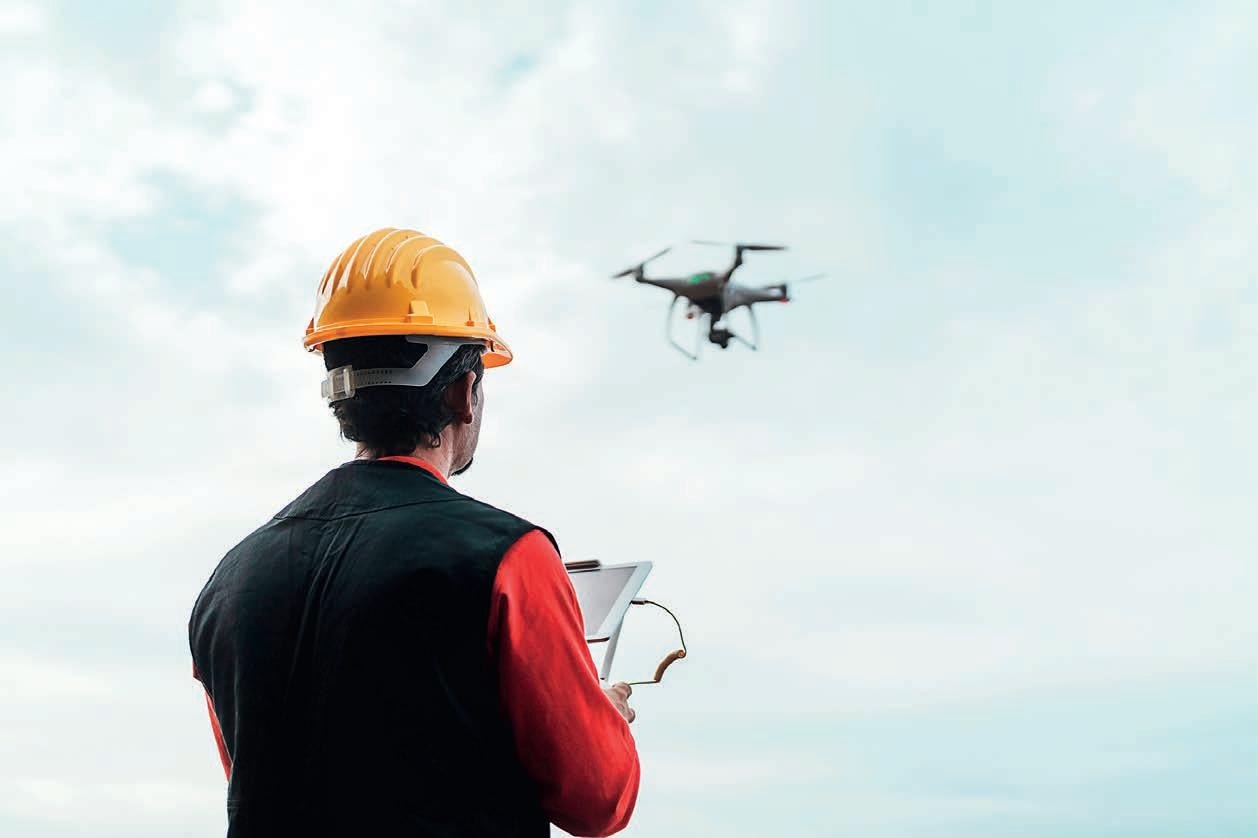
rehabilitation programs are designed with local stakeholders, including Traditional Owner groups, to align outcomes with cultural values and regional economic objectives.
Regulators and communities expect mine-closure planning to start on day one, and many operators now demonstrate this through staged, progressive rehabilitation.
Rather than leaving landform construction until the end of mining, progressive rehabilitation rebuilds landforms, soils and vegetation in parallel with mining activity,
Governance practice around mine waste has also tightened. Companies are embedding tailings and waste management into board-level risk frameworks and reporting on performance with greater granularity.
Industry adoption of global and regional best-practice standards, combined with enhanced regulatory oversight and transparent community reporting, is lifting expectations and performance across the sector.
Universities, research organisations and private providers are collaborating with miners to scale promising innovations from trial to mainstream use. Pilot installations for novel backfill chemistries, phytoremediation trials and new monitoring arrays are increasingly common.
Beyond the technological, these collaborations help to build local capability through training, supplier development and the transfer of skills into regional workforces.
The transformation of mine waste management in Australia is less about a single silver bullet and more about a convergence of better design, smarter
technology, commercial creativity and stronger governance.
The net result is a mining sector that is reducing its environmental footprint, producing new economic value from legacy materials, and building more resilient closure plans, all while maintaining safe, productive operations.
For communities and regulators, the shift translates into more predictable environmental outcomes and clearer pathways for land restoration. For miners, it reduces long-term liabilities and unlocks new sources of value.
Australia is moving from reactive waste management to proactive resource stewardship, a transition that bodes well for the sector’s social license and its role in supplying the metals and minerals the world needs for a cleaner future. AM
Across the globe, miners are re-examining what waste really means.
Tailings, once written off as liabilities, now hold the potential to deliver new revenue streams, critical minerals, and major environmental gains.
For more than 140 years, FLS has provided the technology, knowledge and services that empower customers to meet complex operational challenges. In recent years, many of those challenges have focused on minimising environmental impacts. FLS’s longstanding and proven legacy of innovation has enabled the company to be at the forefront of driving efficiencies while delivering sustainable outcomes.
With governments tightening regulations on tailings storage and the demand for metals accelerating, the pressure is on to extract more value from less material, while ensuring that mine operators achieve their environmental, social and governance (ESG) goals.
“Every mine has hidden value sitting in its tailings,” FLS business development manager for REFLUX technologies Anson Gilbert said.
“The challenge has always been to recover that value efficiently, safely and at a scale that makes economic sense. That’s exactly where our REFLUX technology family steps in.”
Redefining beneficiation
At the heart of FLS’s solution is the REFLUX Classifier (RC), a compact gravity separator combining a fluidised bed with a system of closely spaced inclined lamella plates. The plates accelerate the settling of dense particles
THE FLS AFP2500 COMPLEMENTS THE REFLUX TECHNOLOGIES BY PRODUCING STACKABLE, LOW-MOISTURE TAILINGS.


while desliming and classifying fine material. The result is a sharp densitybased separation with exceptional throughput. Developed in partnership with Laureate Professor Kevin Galvin at the University of Newcastle, the REFLUX Classifier family – including GradePro and the REFLUX Flotation Cell (RFC) – combines gravity separation, classification and flotation principles to recover value from fine and low-grade feeds.

Originally designed for coal, the RC now operates successfully in iron ore, base metals, manganese, chromite, mineral sands and spodumene. The technology is applied in more than 200 installations worldwide.
According to FLS, tests in Canada and Brazil have shown 20 per cent higher recovery and Fe grades exceeding 63 per cent in a single stage, replacing complex multi-stage flotation circuits. In coal and iron ore applications, the RC’s

lamella design has delivered probableerror (Ep) values below 0.06, said to be more than double the precision of traditional spirals.
Building on this foundation, FLS released the REFLUX Classifier Concentrator (RCC) – now marketed as GradePro, an advanced version tailored for low-grade ores and tailings re-treatment. The GradePro integrates secondary fluidisation water and a smaller mixing chamber, cutting bed-

build times by a factor of seven and increasing upgrade ratios more than 30 times for tin and tantalum tailings.
“GradePro takes all the learnings from the RC and adapts them for the world of low-grade feeds and mine waste,” Gilbert said. “It’s robust enough for plant operation, but selective enough to recover fine, high-value minerals that other devices simply miss.”
From tailings to treasure FLS said recent pilot campaigns underscore the step change. At a tin operation treating 0.15 per cent Sn tailings, the GradePro achieved 447× tin upgrade (67 per cent tin product grade) with over 75 per cent recovery.
In Brazil, it was demonstrated that a simplified SAG–RC circuit can replace traditional flotation, reducing operating expenditure by 42 per cent and capital expenditure by five per cent while maintaining of more than 68 per cent Fe concentrate.
Meanwhile, in Canada, the RC has delivered consistent high-grade iron ore concentrates with outstanding recovery and stability.
“Every one of these projects proves that you don’t need more stages; you just need smarter separation,” Gilbert
said. “The REFLUX approach achieves cleaner cuts, smaller footprints and faster payback.”
Recovering value is only half the story. Managing what remains is equally important.
FLS’s AFP2500 automatic filter press complements the REFLUX technologies by producing stackable, low-moisture tailings that can be safely stored or repurposed as backfill. Together, the technologies form a closed-loop system: recover the metals, recycle the water, and drastically reduce tailings dam volumes.
“This integration aligns perfectly with our MissionZero commitment,” Gilbert said.
MissionZero is FLS’s sustainability program that aims to reduce emissions and waste in mining to zero by 2030. In adopting the commitment, FLS has endeavoured to offer its customers the required technological and digital solutions to move towards greener mining processes.
“We’re helping customers move toward dry-stacked, resource-positive operations, where tailings dams become a thing of the past,” Gilbert said.
Of course, the shift to a more sustainable world is further driving
demand for minerals like copper, lithium, and other critical minerals.
These critical minerals are foundational to the global green transition because they enable the technologies driving decarbonisation.
Copper is vital for renewable power and electrification. Its superior conductivity makes it indispensable in wind turbines, solar panels, electric vehicles (EVs) and power grids.
Lithium is central to energy storage, forming the core component of lithiumion batteries that power EVs and balance renewable energy supply through gridscale storage systems.
Beyond these, minerals such as nickel, cobalt, rare earth elements and graphite are equally important.
These minerals underpin the infrastructure of a low-carbon economy – renewable energy systems, electric mobility and advanced storage technologies.
Growing research points to rare earth and critical mineral recovery from coal and historic tailings.
The GradePro’s ability to separate on subtle density differences makes it suitable for extracting fine rare earth elements bearing phases, further
extending its relevance as the energy transition accelerates.
“Critical minerals are the new frontier,” Gilbert said. “The chemistry is complex, but the physics of separation still matters, and that’s where our technology gives miners an edge.”
A circular future for mining
Corporate governance and ESG compliance have become mandatory expectations; however, many companies still grapple with the challenges of how they can reconfigure operations for longterm sustainability.
As mining companies face increasing ESG expectations, technologies that turn waste into resources are reshaping the industry narrative.
By combining scientific innovation with proven field performance, FLS’s REFLUX technologies can offer economic viability, environmental responsibility and operational simplicity in one platform.
“The conversation has shifted,” Gilbert said. “It’s no longer just about compliance or waste management; it’s about value creation, decarbonisation and future-proofing our industry. REFLUX technology allows us to do all three.” AM

ORE BEFORE MECHANICAL BREAKAGE.

A COLLABORATION BETWEEN JENIKE & JOHANSON AND CRESCEND TECHNOLOGIES PROMISES A MAJOR BREAKTHROUGH IN THE ORE TREATMENT PROCESS.
Companies don’t operate for six decades without doing something right. For almost 60 years, Jenike & Johanson has been a global leader in bulk material handling.
The company has established such a strong legacy by constantly seeking to innovate its technology and better support its clients with products and services that understand the demands of the modern mining industry.
That spirit of innovation, collaboration and support is borne out by its recent strategic partnership with Crescend Technologies, a leader in solid-state microwave power systems, to accelerate the development and commercialisation of the innovative Selective Heat Ore Treatment (S.H.O.T.) process.
The collaboration unites two topflight technologies: Jenike & Johanson’s expertise in advanced material handling design and process engineering, and Crescend’s precision solid-state microwave systems.
Together, these capabilities deliver a scalable, energy-efficient solution
for microwave-assisted comminution, offering the mining industry a new approach to ore treatment.
“We’d been exploring microwave treatment of ores for quite some time,”
Jenike & Johanson chief executive officer Herman Purutyan told Australian Mining
“We came across Crescend, who have fantastic expertise in microwave generation and control. A big part of the challenge is being able to deliver that microwave energy to the ore in a controlled and safe way, and Crescend has great technology to do exactly that.”
Purutyan said the partnership represents a significant advance for sustainable ore processing technologies.
“When we met them, it was clear this would be a great partnership,” he said. “Our strength is in handling the material uniformly and reliably as it passes through the microwaves, while Crescend’s strength is in generating and applying those microwaves effectively.
“It’s a perfect match to move this technology forward.”
How S.H.O.T. works
S.H.O.T. applies solid-state microwave energy to ore before mechanical breakage.
By selectively heating minerals within the rock matrix, the process weakens grain boundaries, causing fractures that make the ore significantly easier to crush and grind. This not only reduces the energy required for comminution but also
energy control and integration flexibility. This is designed to ensure that microwave energy is delivered exactly where and how it is needed in S.H.O.T.’s selective heating methodology.
Purutyan said the technology works

S.H.O.T. REPRESENTS A TIMELY INNOVATION AS THE SECTOR CONFRONTS DECLINING ORE GRADES AND RISING SUSTAINABILITY EXPECTATIONS.

JENIKE & JOHANSON’S STRENGTH IS IN HANDLING THE MATERIAL AS IT PASSES THROUGH THE MICROWAVES, WHILE CRESCEND’S STRENGTH IS IN GENERATING AND APPLYING MICROWAVES EFFECTIVELY. IT’S A PERFECT MATCH TO MOVE THIS TECHNOLOGY FORWARD.”
“For the technology to be at its most effective, you need a particular type of mineral in the rock body, typically one surrounded by very hard rock,” Purutyan said. “The way it works is that the microwaves target certain parts of the ore that absorb energy, while the hard rock – being transparent to microwaves – doesn’t heat up. The heating parts expand, creating microcracks, and that’s where the benefits come from. For that to happen, the ore has to have a certain texture.”
Purutyan said the approach is especially valuable because harder rocks usually take much more energy to grind.
Tackling comminution
Among the most significant
S.H.O.T. SIGNIFICANTLY REDUCES THE AMOUNT OF FORCE REQUIRED TO FRACTURE ORE.

According to Purutyan, this process is the single largest consumer of energy in most mining operations. As orebodies age and average grades decline, the energy intensity of comminution only increases, driving up costs and carbon emissions.
S.H.O.T. offers an alternative.
“This technology significantly reduces that energy requirement,” Purutyan said.
“In terms of energy reduction, we’re seeing potential cuts of 20 to 30 per cent in comminution energy for suitable ores. Considering how energy-intensive that process is, that’s a major saving.”
By introducing a non-mechanical, solid-state microwave targeted treatment step prior to grinding, S.H.O.T. significantly reduces the amount of
brute force required to fracture ore. The process uses relatively low microwave energy inputs, typically in the range of 0.3–3 kilowatt-hours (kWh) per tonne yet delivers substantial weakening of the ore.
Differential heating at mineral grain boundaries creates micro-fractures, enabling equivalent liberation at coarser grind sizes and reducing the demand on downstream crushers and mills.
Purutyan said delivering such a process at scale requires a commitment to stringent design methodologies alongside iterative testing that demonstrated real gains for mine operators.
The S.H.O.T. process itself has been demonstrated successfully at a 150-tonne-per-hour pilot scale, showing strong potential to scale to commercial operations.
Alongside the primary gain of a significant reduction in comminution energy requirements, the S.H.O.T. technology provides a compelling set of advantages for mining and mineral processing operations.
These include an increased plant throughput for grinding and beneficiation circuits, equivalent liberation at coarser grind sizes, reducing grinding intensity, and improved leaching recovery, boosting metal yield from ore. By lowering the energy intensity of comminution, S.H.O.T. not only reduces costs but aligns with the mining industry’s commitments to decarbonisation and environmental stewardship.
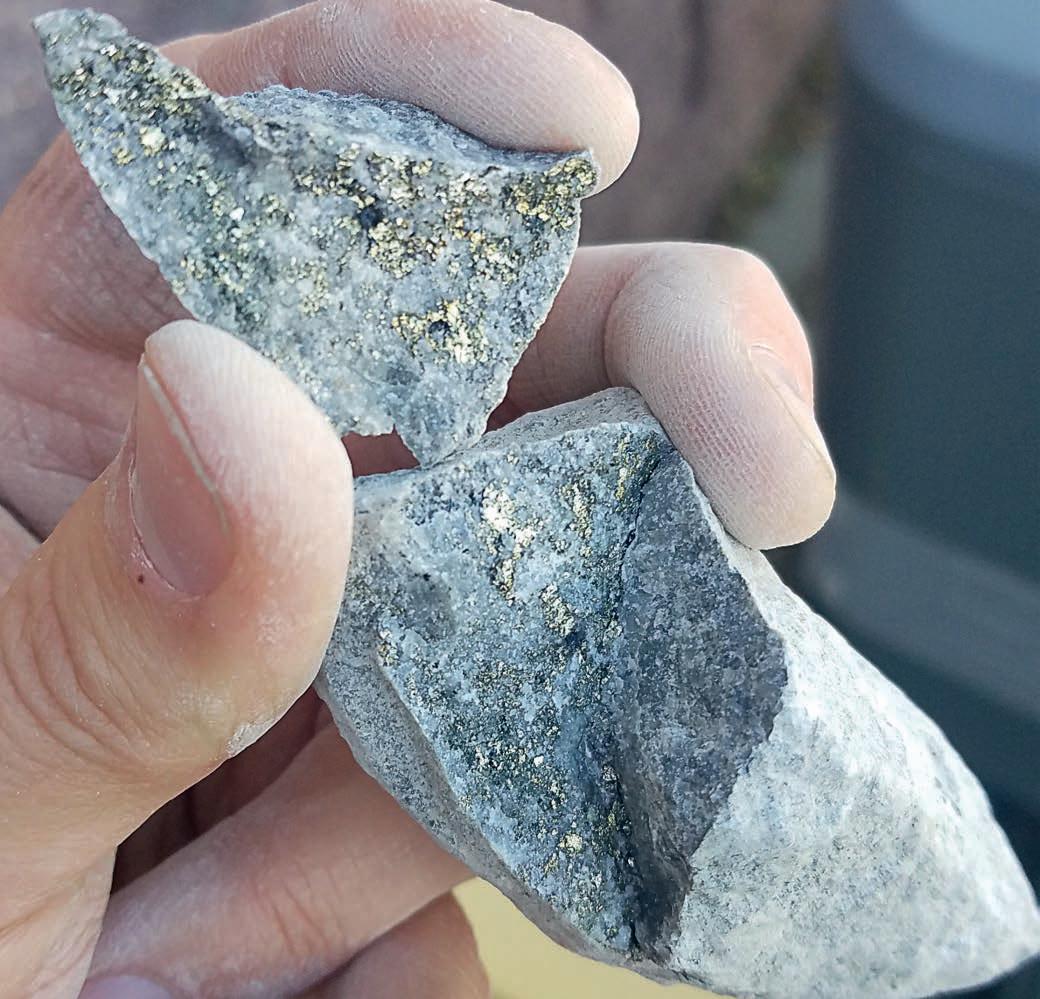
Jenike & Johanson is currently looking to move S.H.O.T. from pilot testing into full commercial deployment. Mining companies seeking to increase throughput, cut operating costs, and unlock value from lower-grade or previously uneconomic ore bodies stand to benefit significantly from this new approach.
As the resources sector confronts the dual challenges of declining ore grades and rising sustainability expectations, S.H.O.T. represents a timely innovation.
By combining Jenike & Johanson’s expertise in bulk material handling with Crescend’s advanced solid-state microwave systems, the partnership is unlocking a pathway to smarter, greener and more profitable ore processing.
In a sector where incremental gains are celebrated, S.H.O.T. stands out as a step change technology with the potential to transform one of mining’s most energy-hungry processes into a model of efficiency and sustainability.
In an industry where any downtime can cost millions of dollars, managing waste in a manner that does not disrupt work isn’t just important to become more sustainable – it’s an operational imperative.
With a greater emphasis on environmental, sustainability and governance initiatives in mining operations, it’s critical to ensure dayto-day performance and efficiency are being balanced.
KOR – exclusive distributor of Cappellotto industrial vacuum products – provides equipment to help ensure operations remain running while waste recovery and asset cleaning are completed in a timely manner.
“KOR was initiated 15 years ago because we identified the market was not truly addressing the need for equipment that allows higher productivity whilst putting safety as a top priority,” KOR head of product and commercial Tim McGregor told Australian Mining
“Our offering is allowing work to be completed with less manpower. This
not only keeps operations efficient, but it also means operators are kept safe, too, which we know is top of mind. By having more capable machines, you typically have a better return on investment for the customer.”
As a specialist in vacuum and water jetting equipment, KOR is committed to delivering solutions and value with its wide range of equipment, parts and accessories, and nation-wide servicing capabilities.
The CAP VAC INDUSTRIAL 3200 10x4 can be used to vacuum up all nonhazardous dry and wet waste material, with other models specifically designed for dangerous goods.
With its long-distance, eight-inch vacuum hose with 270° boom rotation, it offers manoeuvrability and flexibility with greater productivity.

“Instead of needing two or three trucks on a job, you can go back to having one truck only, which decreases the footprint required, decreases the labour required, and decreases the risk of injury,” McGregor said. “We provide people with the ability to keep their
assets online with a conveyor system or pond that would normally have to be shut down when there is a period of cleaning or maintenance; they can work remotely without ever needing to send a person to that area because of using robotics.
KOR also offers Gerotto and Falch robotics that, when coupled to the vacuum and ultra-high pressure water equipment, enables a no-person entry approach to cleaning and waste removal that is safe and productive.
The equipment comes with several other advantages – providing mine sites with safer waste management strategies while also providing more environmentally-friendly waste disposal.
“Reliability is always an issue when we look at large industrial vacuum trucks,” McGregor said.
“What sets us apart is that we have the world’s most reliable equipment with a supply chain that really helps people make notable change to the way waste is managed. You don’t want to shut down equipment for cleaning and with us; you don’t have to.
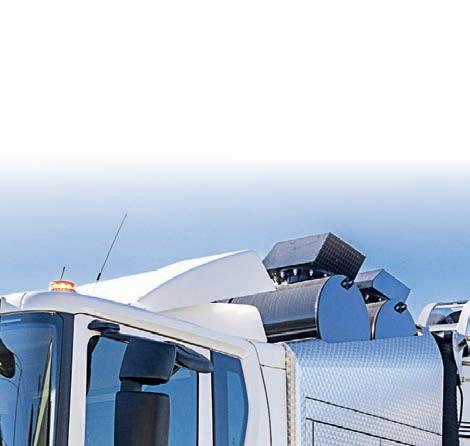


“On top of that, you’ve also got selfcleaning automated filter systems, which reduces the downtime of the equipment itself. Gone are the days when you need to clean the filter box manually by putting sludge into a wheelbarrow or bin.”
With innovations that help keep sites at the fore of operational safety, KOR also offers accredited competency-based training programs that increase the skill level of those using vacuum and highpressure water equipment in the mining industry. The company provides tailored and general training to designed to ensure sites are adding the right skills.
“It’s all about working safely on site and this accredited training, along with delivering higher performing safer equipment, has really helped improve the industry practices of working safely, but yet, still being productive,” McGregor said.
With equipment that is compatible with KOR’s Gerotto remotely operated vehicles for greater efficiency and safety, it’s clear to see why it’s a premier destination for industrial service equipment across New Zealand and Australia. AM





CUSTOM-FIT ARTERRA UHMWPE PIPELINES
ALLOW PRECISE INTERNAL DIMENSIONS, OPTIMISING FLOW AND REDUCING WEAR.

THE SAME ULTRA-SMOOTH MATERIAL THAT HELPS ARTIFICIAL JOINTS MOVE FREELY IS NOW SOLVING ONE OF MINING’S MOST PERSISTENT HEADACHES.
Weir’s advanced pipeline solution
Arterra is an ultrahigh molecular weight polyethylene (UHMWPE), material proven in medical implants and marine applications that dramatically extends pipeline life in some of Australia’s harshest environments.
With more than 15 operational installations across the country and around the globe, some stretching up to 20km, the technology is demonstrating that materials engineered for barnacleresistant fenders and friction-free knee replacements can deliver results when pumping abrasive mine tailings.
Weir’s pipeline solutions manager in Australia Tatum Hall said the technology delivers significantly lower operating costs.
“The surface smoothness of this material offers friction benefits that translate directly to reduced power requirements and extended service life,” she said. “We’re seeing significant yearly savings at sites that make the switch.”
The reality of pipeline failure hit home at an iron ore operation in South Australia a few years ago. The site was using conventional high-density polyethylene (HDPE) pipelines, which were wearing through in 3–4 weeks. The culprit wasn’t corrosion – it was physics.
“They had some slack flow portions of the pipeline. Because of the steep slope, the material was moving faster than it was being pumped; we’re talking up to 12m per second, which is incredibly fast for pipeline operations,” Hall said.
“When you’re pushing particles at that velocity through a pipe filled with highdensity solids, the wear is relentless.”
The site’s initial response – replacing failed sections every 4–6 weeks – was costly and operationally disruptive. After switching to Arterra UHMWPE pipeline, the same sections now last 16–18 months, a 16-fold improvement in service life.
Beyond wear from abrasion, chemical scaling presents another challenge. In operations with heavy chemical processing, such as uranium transport and mining, minerals crystallise on pipe walls, progressively narrowing the internal diameter and choking flow capacity.
“It’s a constant maintenance headache,” Hall said. “The scaling builds up into hard crystals, layer upon layer, until you’re losing significant capacity.”
The secret to the performance of Arterra UHMWPE pipelines lies in the molecular structure of UHMWPE itself. Arterra pipes have a molecular weight of 3.5x106 grams per mole (g/ mol), compared to HDPE with a molecular weight of 0.5x106g/mol. With a surface roughness of just 0.2 microns, the material is exceptionally smooth, almost hydrophobic in its resistance to adhesion.
“It’s this smoothness that gives it the edge,” Hall said. “We’re talking about a material roughness that’s incredibly low compared to other pipeline materials. Nothing really sticks to it.”
That property made UHMWPE a natural choice for marine applications, where its slipperiness prevents barnacle growth and bio-fouling. In medical applications, the same characteristics
allow hip and knee replacements to move freely without friction or adverse tissue reactions, thanks to the material’s chemical inertness.
But translating those properties into mining pipelines required solving a significant engineering challenge. The very smoothness that makes UHMWPE so effective also makes it impossible to weld.
“Around 2014, we developed a way of flanging the ends and creating connections that seal reliably at the pressures required for
mining,” Hall said. “That was the breakthrough that opened up this material for pipeline applications.” Another key advantage is customisation. Where conventional pipelines come in standardised diameters, Arterra UHMWPE pipelines can be specified to exact internal dimensions based on an operation’s specific design requirements. The wall thickness is then calculated from three components: pressure rating, temperature de-rating, and wear allowance.

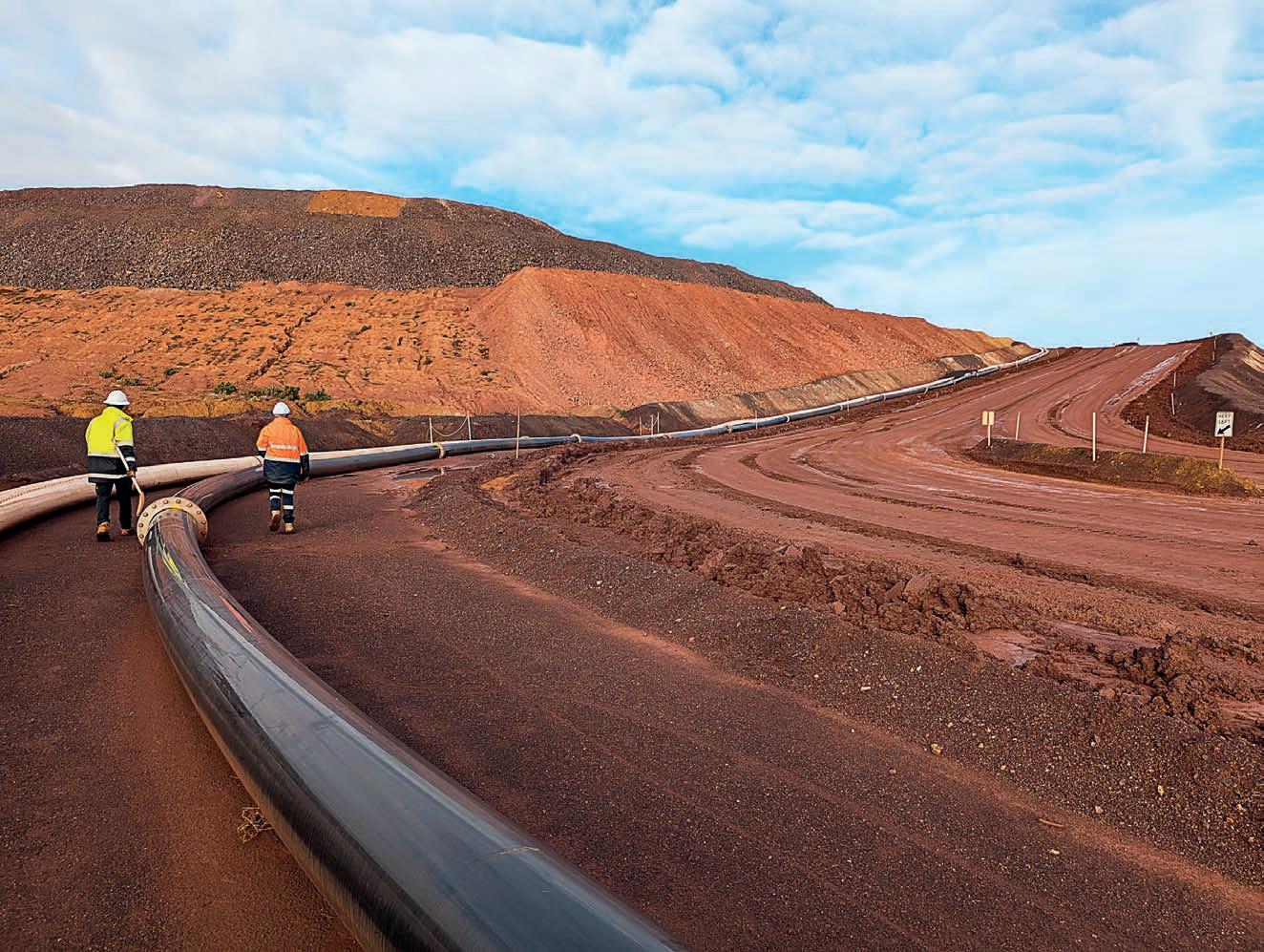
Arterra UHMWPE pipelines at an operation dealing with heavy chemical processing helped the site dramatically reduce its maintenance burden.
“They were pressure washing their pipes monthly at 3000 kilopascals [kPa], which introduces significant safety risks for workers,” Hall said. “After switching to Arterra pipelines, they went to quarterly cleaning at just 1000kPa.
“That’s a much safer operation and far easier to schedule.”
The reduced friction also means lower pumping power requirements, with savings becoming increasingly
•Mask down feature as standard delivering strong results in mining.
significant on longer pipeline runs.
On installations exceeding 5km, the optimised internal diameter and smooth surface combine to significantly reduce energy consumption.
Arterra UHMWPE pipelines are available in two configurations, depending on application requirements.
The bare plastic pipe offers maximum flexibility for tailings applications where extreme pressures aren’t a factor. For higher-pressure environments, a lined steel option uses Arterra UHMWPE pipes as an internal lining within steel pipe, capable of handling pressures

• Up to 5,278m2 Light Coverage
• 420Wp solar panel
secure your stock today with our exclusive
• Compact design
• Robust HardHat® canopy
exceeding 10,000kPa, whereas a bare pipe can handle pressures up to 4000kPa, depending on size.
The technology has found its natural home in tailings transport, typically the longest pipeline runs on a mine site, where abrasive slurries must travel from processing plants to disposal areas.
With installations now proven across Australian operations, Arterra UHMWPE pipelines represent a case where borrowing innovation from other industries has delivered tangible improvements in durability, safety and operational efficiency for mining. AM



IN MINING, DOWNTIME
IS COSTLY. WASTE INITIATIVES DELIVERS PROVEN WASTE MANAGEMENT SOLUTIONS THAT KEEP OPERATIONS RELIABLE, EFFICIENT AND COMPLIANT.
Reliable equipment isn’t just nice to have on a mine site; it’s pivotal in providing lower operating costs and ensuring long-term business success. Waste management is no different.
When waste compactors, balers, shredders or sorting systems break down, the ripple effects include increased labour costs, missed collection deadlines and a damage to reputation.
Waste equipment specialist Waste Initiatives believes it’s not about throwing a single solution at each problem, but rather working with sites to find solutions that best suit the challenge at hand.
“There are multiple ways to skin the cat – it’s about looking at each site as an individual and working with them, their waste contractor, and staff to find the best solution to fit the problem,” Waste Initiatives managing director Dwayne Smith told Australian Mining. “We work with top international partners from Germany, Ireland and America to bring in quality and reliable equipment that gives customers in Australia complete solutions. We then back that with local spare parts and local service to ensure they’re getting all they need and more.”
tyre shredders, over-the-road (OTR) tyre debeaders and cutters, roll packers, compactors, balers and conveyors, all available with custom layouts, mobile options, and diesel or electric drives.
Services extend beyond simp supply, supported further with project management, installation, commissioning and servicing. With a national service team and a locally stocked parts network, Waste Initiatives delivers long-term reliability and responsive support.
With considerable scrutiny from environmental authorities, correct disposal of waste generated from site is essential in ensuring compliance and hitting key environmental, social and governance (ESG) metrics.
Now more than ever, consideration of ESG issues is becoming more important to the mining industry, with exploration pinned as a key opportunity.
Guides from industry bodies such as the Association of Mining and Exploration Companies encourage ways mine sites can better understand and implement ESG related activities, something in which Waste Initiatives also engages through its sales after-care, including training.
Having worked with several highprofile clients in the past, Waste Initiatives solutions partner Brenton Sargeant said challenges are easy to overcome with the right know-how.

“We offer waste management solutions to mine sites that can really help with their operational output and how waste is disposed. We can help with reducing the amount of waste going to landfill.”
One key challenge for mines is handling end-of-life OTR tyres.
Waste Initiatives provides the Eagle International OTR tyre debeader, capable of removing bead bundles from tyres up to 4m in diameter and 63-inch rims.
When combined with the Eagle International OTR tyre cutter, large tyres can be prepared on site for easy transport and further processing.
With approximately 330,000 tonnes of tyre waste being recovered in Australia every year, new technology is being used to better recycle the material. This kind
of volume and durability can be seen as a challenge for many sites.
Waste Initiatives provides a range of equipment designed for tyre waste recycling. By investing in these solutions, businesses and communities can effectively manage tyre waste, reduce environmental impact and contribute to a more sustainable future.
“If you need to lift recycling rates, process OTR tyres, or simply reduce the cost of moving and storing waste, we can help,” Sargeant said.
With more than 40 years of experience in waste solutions design and supply, Waste Initiatives offers mine sites a true one-stop shop for shredding, compacting and recycling, all backed by a national service network and locally stocked spare parts. AM


























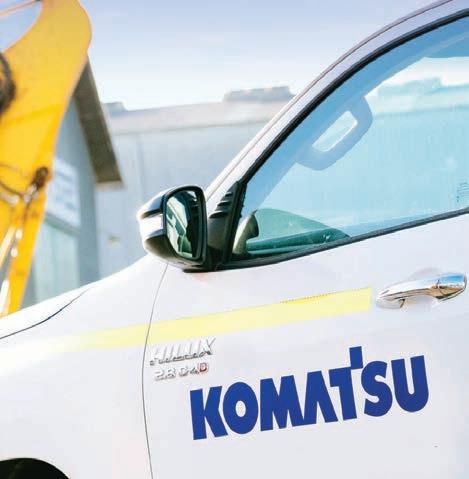


FOR DECADES, FLOTATION HAS BEEN A CORNERSTONE OF MINERAL PROCESSING – AN ADAPTABLE AND EFFICIENT METHOD WHOSE IMPORTANCE IS ONLY EXPECTED TO GROW.
As ore grades decline and environmental expectations rise, miners are under increasing pressure to recover more metal using less energy, less water, and less space.
Eriez, a global leader in separation technologies, has been at the forefront of this transformation.
With more than 80 years of expertise in magnetic, flotation, and materialhandling systems, the company has built a reputation for helping customers achieve the delicate balance between metallurgical performance and environmental responsibility.
The company’s latest breakthrough – the StackCell flotation system – represents a decisive step in that direction. Designed to recover fine and ultrafine particles while reducing energy consumption and plant footprint, StackCell has rapidly emerged as one of the mining industry’s most versatile and sustainable flotation solutions.
According to Eriez senior global product manager Homie Thanasekaran, the technology was born directly from customer feedback.
“At elevations approaching 4000m – as seen across many South American mine sites, or in remote operations across Western Australia’s red-sand deserts – building and installing larger
flotation tanks is a constant challenge,” Thanasekaran said.
“What customers really wanted was a compact, energy-efficient system capable of achieving top-tier metallurgical performance, especially in the recovery of fine particles, rather than simply adding more and bigger flotation cells. With many of these remote sites constrained by limited access to energy and water, efficiency had to be engineered into every aspect of the design.”
Originally developed from Eriez’s proven column flotation technology, the StackCell was designed to deliver selective recovery of fine particles within a far more compact and energy-efficient platform, specifically engineered to replace conventional cells in rougher, scavenger, cleaner, and cleaner-scavenger circuits.
Thanasekaran explained that the innovation was shaped by customer demand for flotation systems that are smaller, enclosed and easier to install and maintain, particularly in operations challenged by space constraints, extreme climates or high elevations.

energy use. StackCell evolved through that continuous collaboration with our customers over the past decade.”
“We took that feedback to heart,” he said. “In regions like North America, where sub-zero temperatures mean most equipment must be housed and heated indoors, there was a clear need for a system that minimised both size and
The result is a flotation cell that, according to Eriez, consumes roughly one-third of the energy of comparable conventional systems, with a footprint 50 per cent smaller and foundation loads reduced by up to 70 per cent.
With its focus on energy efficiency, fine particle recovery and reduced environmental impact, StackCell

exemplifies how technology and innovation can work hand-in-hand to make mineral processing more sustainable, while simultaneously delivering higher recovery of fine and ultrafine particles.
At the heart of StackCell’s success is a deceptively simple idea: separating the particle-collection and phase-separation stages of flotation.
Traditional cells perform both functions in one tank, forcing engineers to compromise between turbulence (required for particle–bubble attachment) and stability, essential for separation.
By decoupling these zones, StackCell focuses energy precisely where it’s needed. The turbulent dissipation rate in its collection chamber can reach 120 watts per kilogram (W/kg), which Eriez said is up to five times higher than in conventional mechanical cells. The result is faster bubble–particle collisions, superior fine particle recovery and higher grade concentrates at minimal residence time.
“Fine particle recovery has taken on new urgency as ore grades drop,” Thanasekaran said. “Where processing one tonne of ore once produced between 0.8 and 1kg of copper, it now yields only about half that. To sustain production levels, miners must process nearly twice as much material, making efficiency and selectivity more important than ever.”

This makes energy-smart flotation essential for miners chasing productivity and environmental, social and governance (ESG) goals simultaneously. Thanasekaran said StackCell delivers that balance.
“We’re seeing sites that need to increase throughput by 15 to 20 per cent just to meet production targets, but they don’t have the real estate or the power capacity to add that within their existing operations,” he said. “StackCell allows them to add capacity at the back end of the circuit with minimal footprint, a key advantage in brownfield operations.
StackCell’s modular, compact design means it can be easily retrofitted into existing circuits as a scavenger or cleaner scavenger unit, enhancing recovery from tailings stream and improving overall circuit performance.
Thanasekaran said many customers are now deploying StackCell in tailings recovery applications, where its ability to capture ultra-fine particles delivers immediate and measurable value.
“When particles get very fine –around 20 microns or even as small as five microns – they tend to escape conventional flotation due to the lack of sufficient turbulent dissipation rate and report straight to tailings,” he said. “StackCell can recover those fine, valuable minerals and return that lost revenue back to the operation.”
The technology also complements Eriez’s HydroFloat coarse-particle flotation system, with the two working in tandem at opposite ends of the particle-size spectrum. HydroFloat handles the coarse material – “the sand on the beach” as Thanasekaran puts it – while StackCell captures the ultra-fine “dust”. Together, they deliver complete recovery coverage across the circuit, maximising overall metallurgical performance
StackCell’s environmental credentials are equally compelling. Lower energy consumption, reduced reagent use, and a smaller installation footprint all contribute to improved sustainability performance. Eriez reports that the design aligns directly with mining companies’ decarbonisation and ESG commitments, including long-term netzero targets.
Eriez’s long-standing culture of innovation is deeply embedded in its DNA. Founded in 1942 and headquartered in Erie, in the US state of Pennsylvania, the company now operates in 12 countries, including Australia, where it maintains offices in Victoria and Western Australia and supplies equipment to the nation’s largest mining regions.
Thanasekaran said that culture stems from the vision of Eriez’s leadership team and founder.
“Our CEO Jaisen Kohmuench and VP of technology Mike Mankosa both did their PhDs in flotation at Virginia Tech about 30 years ago,” he said.
“They started the research that became StackCell and HydroFloat in a small laboratory. Today, that same innovation is operating at full industrial scale worldwide.”
Thanasekaran also credits Eriez’s owner Richard Merwin for fostering a research-driven mindset that continues to shape the company’s technological breakthroughs.
“Richard believes in developing technologies that stand out,” he said. “He doesn’t want to buy ideas – he wants us to build them That’s why Eriez has
such a strong in-house R&D [research and development] capability.”
This philosophy has paid off, with StackCell installations now spreading rapidly through key global markets. In Australia, the technology is being used across coal operations in Queensland, as well as copper, gold and rare-earth sites in Western Australia.
“In Queensland alone, we have more than 15 StackCell units operating,” he noted. “In Western Australia, we’re seeing strong adoption in copper, gold and rare-earth processing, too.”
Interest is rising fastest in copper and gold projects around the world, where soaring demand meets increasingly complex ore bodies. Thanasekaran expects the next decade to bring continued expansion.
“The demand for copper is projected to remain very strong for at least the next 10 years,” he said. “As ore grades fall, technologies like StackCell that can process higher volumes efficiently will only become more important.”
For Eriez, that combination of market demand, technical innovation and sustainability focus is what defines the company’s purpose. StackCell isn’t just a smaller, faster flotation cell; it represents a shift in how the industry thinks about mineral recovery.
By marrying high-intensity particle collection with low-impact design, the technology shows that superior metallurgical performance and environmental stewardship can truly go hand-in-hand.
“Our goal is to help customers recover more metal with less energy, less water and less waste,” Thanasekaran said. “That’s what StackCell is all about.” AM
WITH ITS FOCUS ON ENERGY EFFICIENCY, FINE PARTICLE RECOVERY, AND REDUCED ENVIRONMENTAL IMPACT, STACKCELL EXEMPLIFIES HOW TECHNOLOGY AND INNOVATION CAN WORK HAND-IN-HAND.
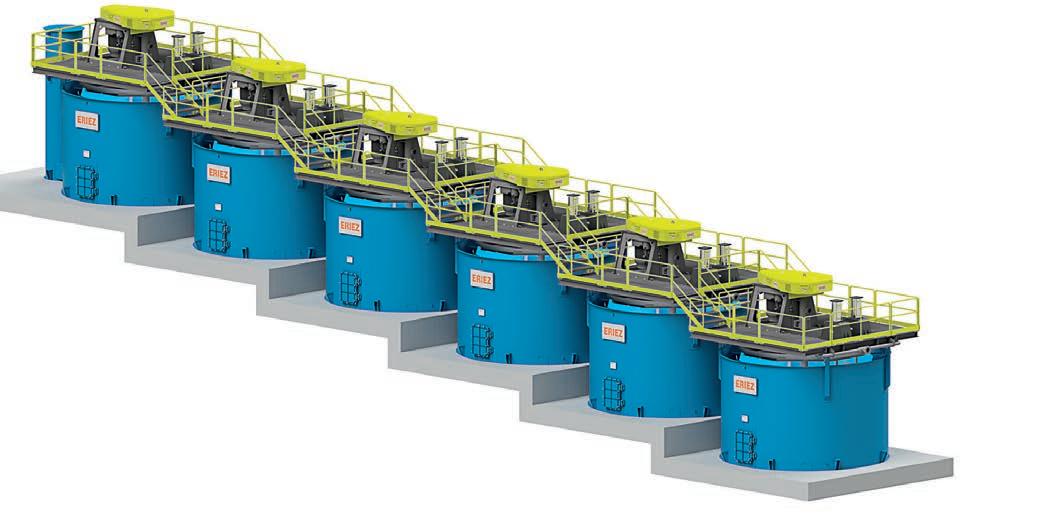
ERIEZ FLOTATION SYSTEMS ARE DESIGNED TO WORK WELL IN A RANGE OF LOCATIONS AND SITES.

SMARTER WASTE MANAGEMENT FOR MODERN MINING.

TAILINGS
As mineral operations target higher recovery rates from increasingly
This shift is resulting in a growing proportion of ultra-fine tailings –particularly those under 45 micrometre
particles, these tailings exhibit poor packing densities. This limits their ability to develop sufficient material
due to fine particle sizes, and the need to stabilise leachable constituents.

reliance on traditional tailings storage facilities, in-pit disposal or low-strength demands of dewatering large volumes.
• Brine management challenges – tailings and brine disposal are closely linked, particularly during mine closure. Effective management requires an integrated strategy that begins early in the mine’s life and continues through closure and monitoring.
Beca’s expertise
Modern mining operations are being met with rising expectations to reduce the environmental and community impacts of tailings. Key priorities include minimising surface tailings storage, improving long-term stability, and expanding opportunities for repurposing.
responsibly. Several critical risks must be addressed to help ensure safe, sustainable
Escalating liabilities – large tailings
constrained by factors such as distance achieving sufficient material strength
Beca brings leading expertise across the full tailings lifecycle, from identifying suitable geological and geotechnical conditions for storage facilities to mine closure and postclosure monitoring. The team designs optimal slurry characteristics tailored to the intended storage method, whether traditional slurry, paste, or filter cakes. It also develops backfill formulations, manages tailings dams and leads innovative repurposing strategies.
“What sets Beca apart is our pioneering work in tailings reuse,” Beca chief metallurgist Paul Language said. “We focus on enhancing mineral

recovery and enabling the beneficial reuse of tailings both on-site and off-site, contributing to more sustainable and economically viable mining operations.”
Geotechnical, geochemistry and hydrogeology
The long-term stability of any tailings storage facility depends on selecting landforms with robust geotechnical characteristics. Given the extended operational life of these facilities, confidence in early-stage data is critical.
Beca offers deep expertise through a team of more than 160 geotechnical engineers, engineering geologists, and hydrogeologists across Australia, Southeast Asia and New Zealand.
“We deliver comprehensive studies to identify and assess suitable landforms for safe, sustainable tailings storage,” Beca minerals and metals segment director Tristan Musgrave said.
Optimising slurry for efficient handling
Slurry thickening and handling are central to effective tailings management, whether for traditional storage lowstrength backfill or dewatering. With over 40 years of scientific and engineering experience, Beca understands the importance of slurry rheology in transport and dewatering systems.
“Our approach includes fundamental slurry testing to inform pump system design and dewatering to ensure project success,” Language said. “We design systems that accommodate variability in tailings feed, optimise water recovery, and reduce energy consumption, all key challenges for operators today.”
Filter cake dewatering, handling and storage
As demand grows for higher tonnages and drier filter cakes, equipment suppliers are scaling up and automating dewatering technologies. While pressure filtration is often the default technology, centrifugal and vacuum filtration can offer viable more cost-effective and higher-capacity alternatives.
to poor water recovery and inefficient use of storage capacity. This can create significant challenges during closure and long-term maintenance.
And that’s why Beca takes a proactive approach.
“Our hands-on approach to leveraging technical knowledge of rheology together with practical constraints of safety and operability of deposition systems is a key strength,” Beca market director resources and sustainable fuels Matt Kebbell said.
Unlocking value from tailings
Regulatory and environmental pressures are driving the need to minimise surface tailings storage and explore repurposing opportunities. Beca is at the forefront of developing high-strength applications for tailings, including concrete, building materials, and engineered backfill.
“Our innovation includes modifying particle size distribution through agglomeration and sizing, and separating particles in slurry form for use in high-consolidation applications,” Language said.
“These processes also enable the recovery of trace minerals, adding further value.”
Closure and environmental compliance
Mine closures are becoming more complex and costly, often exceeding planned budgets and timelines. With increasing commodity volatility and climate-related risks, early integration of closure planning is essential.
“Our multidisciplinary team of engineers, scientists and metallurgists embed closure strategies from the earliest design stages.” Musgrave said. “We provide ongoing operational advice and deliver closure solutions
that address a wide range of technical scenarios, enabling compliance and long-term sustainability.”
Project management and delivery
Delivering technically challenging tailings projects requires deep insight and a balanced focus on immediate needs and long-term outcomes. Beca excels in managing complex brownfield projects, earning trust from regulators, communities and operators.
“Our project leads bring passion and experience, ensuring practical solutions that meet today’s challenges while preparing for future closure and compliance,” Musgrave said.
“With over 4500 engineers, planners, environmental scientists, project managers and commercial specialists, we’re ready to form the core of your tailings team, working alongside your in-house experts and other specialists.” AM

Beca’s equipment selection process is grounded in strong relationships with vendors and test laboratories.
“We explore options such as modified drainage characteristics, staged filtering and slurry additives,” Language said. “Ultimately, the solution developed by Beca is a seamless system integration of dewatering, storage and conveying.
“Our differentiator in producing drier filter cake is the understanding of creating a durable drystack in tropical and wet climates, adding to the stability of landforms over time.”
Smarter tailings deposition for long-term stability
Tailings deposition can often be treated as an operational afterthought, leading
This project formed part of the requirement to secure permitting for a new mine and mineral processing plant, with a key condition: surface tailings storage to be minimised and no additional surface storage permitted beyond the first five years of operation.
The project was delivered in two stages:
• Stage 1: A desktop study identified large-volume re-use options to reduce surface tailings storage.
• Stage 2: Selected concepts were developed to pre-feasibility level, supported by laboratory testing.
The adopted solution included a portion of the tailings to be agglomerated and sized to achieve a coarse particle fraction which would result in an ideal packing density and hence high compacted strength.
The concept was tested by producing a “synthetic aggregate” from tailings that utilised a low-carbon, high-strength cement alternative (geopolymer). This was blended with the bulk of tails resulting in backfill mixes with high comprehensive strengths (greater than 4MPa). Geopolymer binders – made from industrial by-products – were activated with a basic solution. This matrix resulted in the total “non-tailings” material addition (binder) to the backfill of less than 15 per cent, a reduction of 40 per cent over traditional backfill tailings approaches.
The net benefit for the project was threefold: 70 per cent reduction in surface tailings storage; 90 per cent lower CO2 emissions from binder use; mine life extended by almost 50 per cent.
The project is now in final design and expected to move into execution in the near future.


THE FUTURE OF MINING DEPENDS ON EXTRACTING MINERALS EFFICIENTLY AND MANAGING THE BY-PRODUCTS AND RESIDUES THAT COME WITH THE PROCESS.
Waste streams such as tailings, fines, dust and sludges are an inevitable consequence of mineral processing. But in an era of heightened environmental scrutiny, rising costs and the push for sustainable practices, they have become one of mining’s biggest challenges – and, increasingly, one of its greatest opportunities.
That opportunity lies at the heart of Picko Global’s philosophy.
As a specialist in agglomeration and waste transformation, the company helps clients convert waste materials into usable, transportable and even saleable products.
By combining proven engineering with a circular-economy mindset, Picko is working to redefine what mine waste management can achieve.
Vast quantities of fine and residual material are produced every year across mining and metallurgical operations, from smelter dusts and tailings to ultrafine ore particles that are difficult to process or store.
Traditional waste-handling methods such as tailings dams and large-scale containment facilities can carry high maintenance costs and long-term environmental liabilities. They can also represent lost value, since many waste
streams still contain recoverable minerals or potential by-products.
Managing these materials is technically and economically complex. Fine particles typically have poor flowability and low cohesion, making them hard to transport, stockpile or reuse. Their variability and high moisture content add further challenges for handling and storage systems, while binder selection can be costly or unreliable. The abrasive nature of mineral fines also leads to significant wear on equipment.
Instead of treating waste as an issue to contain, Picko treats it as a feedstock that can be engineered into stability, value and usability through agglomeration – the process of binding fine particles into larger, more stable and manageable forms.
At its simplest, agglomeration transforms waste into consolidated products such as briquettes, pellets or extrusions that are easier to handle, transport and store. These agglomerates can be reintroduced into production streams or sold, turning waste into revenue.
Picko has built its reputation on this approach, offering end-to-end wasteto-value solutions that help miners convert fines and sludges into durable, reusable materials. The company’s integrated service model includes pilot
testing, modular plant construction and operational contracts, allowing clients to adopt these technologies without heavy capital investment.
Founded in 2008 by Piet van Schalkwyk, Picko began with a contract to manage a pelletising plant for BHP at Meyerton in South Africa. Tasked with transforming smelter waste into reusable products, the project proved so successful that it became the foundation of Picko’s business model and global expansion.
The company has grown into a recognised leader in waste valorisation, with an ongoing commitment to research and development in binder chemistry, process optimisation and scalable plant design.
Because no two waste streams are alike, Picko offers three main agglomeration technologies –briquetting, pelletising and extrusion – each suited to specific material types and operational needs
Briquetting uses mechanical pressure to compress fines into dense, shaped briquettes. It is particularly effective for feeds that include fine and coarse fractions, typically up to 6mm in size. This method requires minimal binder and produces a robust, transportable product that maintains its integrity through handling.
Pelletising, by contrast, forms small, spherical pellets that are cured using
heat or chemical hardening. The process is suited to finer or more uniform materials and produces a product that can be precisely dosed or blended into downstream processes. However, because pellets are more fragile than briquettes, they require careful handling during transport and storage.
Extrusion is suited to clay-rich or sludgy materials below 2mm in size. Wet feed is forced through a die to create a continuous or semi-continuous profile. Though sensitive to moisture and abrasion, this method provides excellent control over product shape and density.
To help ensure the best solution for each application, Picko operates containerised pilot plants and modular production units that allow clients to trial multiple methods under real-world conditions before committing to a full-scale installation. This ability to fine-tune process parameters – from particle size to moisture content – is designed to arrive at a precise match between technology and material.
As global demand grows for cleaner, smarter and more responsible mineral production, the future of mine waste management will rely on companies that can engineer value back into the materials once left behind.
For Picko Global and its partners, that future is already here. AM







QUEENSLAND MINE REHABILITATION COMMISSIONER JAMES PURTILL RECENTLY SET OUT HIS VISION FOR TURNING MINE CLOSURE INTO INDUSTRY OPPORTUNITY.
When speaking at AusIMM’s Life of Mine Conference in Brisbane in July, James Purtill shared his vision for how mine closure can evolve from a regulatory challenge into a driver of innovation and opportunity.
Since assuming the role of Queensland’s inaugural Mine Rehabilitation Commissioner in 2021, Purtill has focused on improving how the state approaches mine closure and rehabilitation.
The role was established following reforms between 2017 and 2019 that strengthened life-of-mine planning, introduced the financial provisioning fund, and emphasised progressive rehabilitation.
Purtill spoke to AusIMM chief executive officer Stephen Durkin
as part of a new interview series Leading Conversations that explores the careers and impact of work from experts in the mining and minerals sector. He discussed how his position is intended to guide government and industry in adopting leading practices for transitioning mines to land uses following mining.
“My role was established as an advisory role to government in leading practice in progressive rehabilitation and mine closure planning or, as I prefer to call it, transitions to post-mining futures,” Purtill said.
The commissioner’s office prioritises collaboration over enforcement, enabling open discussion with mining operators about what works and what does not. This approach allows systemic challenges to be identified across the sector without the threat of compliance action.
This independence, Purtill said, has been critical in fostering candid dialogue and practical solutions.
One of the most significant challenges in mine rehabilitation is achieving the successful surrender of mining leases. Complex geology and geochemistry, long operational histories and legacy practices can make closure difficult.
Queensland, for example, has only seen one small coal mine successfully surrendered under contemporary environmental regulations.
Purtill said these challenges are not unique to Queensland but reflect broader global experience, highlighting the need for more proactive planning and innovative approaches.
He said his office works as a “twospeed advisory service”. For new greenfield operations, the team provides guidance on embedding best practices from the start. For existing, long-running
mines, the focus is on retrofitting leading practices where possible.
This dual approach is designed to ensure that even legacy issues can be addressed constructively while supporting industry growth.
The commissioner is also driving a vision for Queensland to become a global leader in mine rehabilitation.
By integrating lessons learned internationally and collaborating with stakeholders, the state aims to maintain a healthy, economically viable industry while managing environmental responsibilities.
This vision is reflected in innovative projects such as New Century’s reprocessing of tailings at the Century zinc mine, which has allowed the site to become one of the world’s largest zinc producers through re-mining.
Likewise, EQ Resources’ Mount Carbine tungsten project demonstrates circular economy principles by extracting value from low-grade stockpiles and reusing benign materials for construction.
Part of Purtill’s role is to find what barriers exist that are stopping these innovative post-mining land uses or reprocessing projects.
Financial provisioning remains a central consideration in effective mine closure. Auditor-general reports across Australian jurisdictions consistently show shortfalls in provision levels, and Purtill highlighted the importance of balancing affordability with adequate coverage of potential liabilities.
Progressive rehabilitation is a key strategy to manage costs and reduce future risks, helping to ensure funds are spent efficiently and responsibly.
Tailings management is another area where opportunity and responsibility intersect. Purtill said tailings, while challenging to manage, contain significant potential for resource recovery in the future.


Advances in technology and market demand mean materials previously considered waste can be reprocessed for valuable metals, making tailings an asset rather than solely a liability.
By combining environmental stewardship with innovation, planning and collaboration, Queensland is positioning itself as a world leader in mine closure, turning complex challenges into long-term benefits for industry and the community. AM

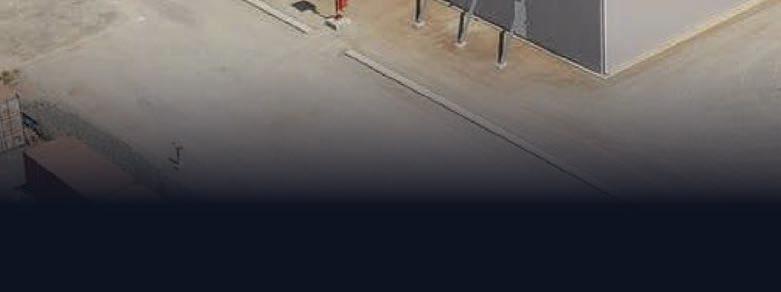


• Australian made, superior quality
• Cyclone rated and extreme weather resistant
• Industry-leading customer experience
• Engineered for mining operations, incl. waste management Get in touch



Aof mine sites, pipes are under constant stress from high-pressure flows, abrasive materials and frequent operational change. This means they require constant monitoring and maintenance to make sure they’re always running at their best.
Constantly monitoring pipes’ quality and condition can reduce the risk of small weaknesses turning into significant risks that impact safety and operations.
Effective management not only helps operators avoid those risks but extends the life of equipment, helping to ensure assets deliver the maximum return on investment while minimising potential downtime when repairs are needed.
That’s where Pipe Tek can help, offering some of the most thorough pipeline integrity testing available anywhere in Australia, ranging from intelligent pigging, leak detection, hydrostatic testing and flange management.
“We offer a fully certified turnkey pipeline integrity service, which means we take care of everything from cleaning and non-destructive testing through to hydrostatic and pneumatic testing, dewatering, drying, nitrogen purging, inline inspection, as well as repairs like welding and coating,” Pipe Tek chief
operating officer Taddam Farrant told Australian Mining Pipe Tek, which services pipes from 2–70 inches, has served Australian operations for more than 70 years and has a proven track record of the highest quality of pipeline maintenance. Its exclusive global partnership with Enduro Pipeline Services provides Pipe Tek customers with access to some of the most durable tools on the market.
“Coupling this with fully trained local experts located from Western Australia all the way up to Queensland and the
“What sets us apart is we use advanced technology for live remote monitoring of pipeline pressure and temperature, even in the most remote parts of the country. This level of visibility gives operators complete confidence in their assets.”
Having worked on more than 850 pipelines across Australia and the Pacific, Pipe Tek is no stranger to extending asset life, covering everything from highdensity polyethylene (HDPE) tailings lines to steel and fibreglass systems.
“In a recent project we completed for

proactively address the integrity issues during a planned shutdown rather than dealing with an emergency failure,” Farrant said.
This approach saved the mining company significant costs in downtime and avoided what could have been a major on-site incident.
In another case, the use of advanced technology and inspection methods restored a slurry line that had been operating at low capacity, which Farrant said improved throughput and reduced the load on pumping systems.
“These examples illustrate why integrity management isn’t just about compliance; it’s about performance, safety and sustainability,” Farrant said.
It’s not just asset performance that keeps Pipe Tek at the forefront of maintenance activities. Focus on sustainability, such as ensuring waste is reduced and equipment runs efficiently, also helps benefit mine sites.
“Nobody wants to be using more resources for less output,” Farrant said. “By staying on top of pipeline health, operators can maintain full flow capacity, reduce their environmental footprint and significantly prolong the life of both the pipeline and the associated plant equipment.
“It’s an area that can easily be overlooked, but the long-term financial and operational benefits of proactive management are enormous.” AM

for speed, scale
security Network solutions for better connected mining sites.


Vocus powers the connections that drive progress. From the bustling heart of cities to remote regions, we deliver ultra-reliable, low-latency connectivity that powers automation, AI, and remote operations. Helping you boost productivity, minimise downtime, and keep your sites running e ciently.
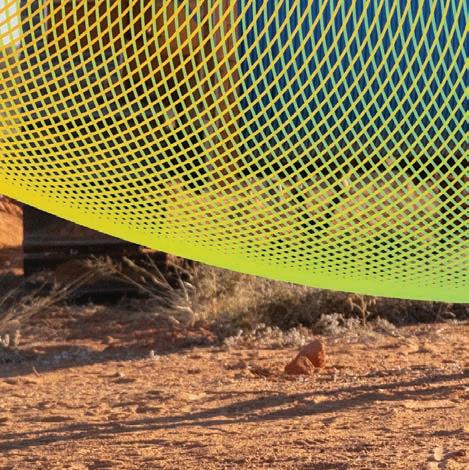
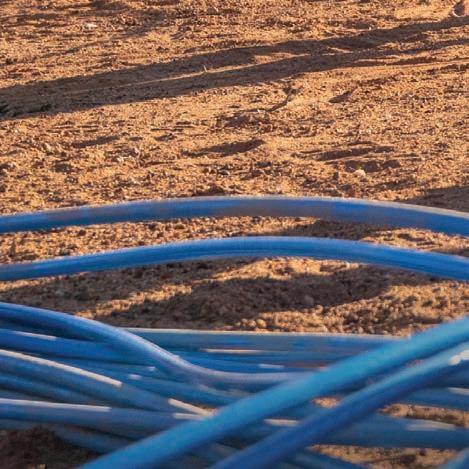


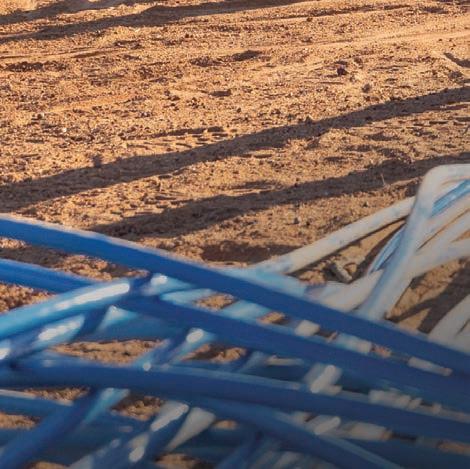




DOMESHELTER AUSTRALIA’S ENGINEERED FABRIC STRUCTURES ARE PROVIDING MINING OPERATIONS WITH DURABLE AND RELOCATABLE INFRASTRUCTURE SOLUTIONS WHEREVER THEY’RE NEEDED.
In the heart of the Pilbara, a 240m2 facility is helping to transform one of mining’s most challenging waste streams into sustainable resources.
The purpose-built tyre recycling plant processes more than 30,000 tonnes of end-of-life mining tyres per year, giving new life to massive offhighway tyres that once represented a significant disposal problem. And behind this operation’s infrastructure stands DomeShelter Australia, whose engineered fabric structures are proving their worth in one of the country’s most inhospitable industrial environments.
While DomeShelter Australia has built its reputation delivering workshops, maintenance facilities and bulk storage solutions to mine sites across the country,
beyond traditional applications. From helicopter hangars to waste management facilities, these semi-permanent structures are solving infrastructure challenges wherever mining operations need reliable, relocatable protection from extreme conditions.
It’s a flexibility that’s becoming increasingly valuable as operations adapt to changing commodity prices, expanding footprints, and evolving environmental requirements.
Benefits for every operation
According to DomeShelter Australia technical solutions principal Bobby Fawkes, the dynamic nature of the mining industry creates unique infrastructure demands that traditional permanent buildings usually cannot
“Mine sites are constantly evolving environments,” he said.
“Fabric shelters offer solutions that can adapt as quickly as the operations themselves without the commitment or cost of conventional construction.”
The semi-permanent nature of DomeShelter Australia’s structures makes them particularly suited to mining’s contract-based operations. Whether it’s a waste management contractor with a three-year agreement or a maintenance operation supporting a mine expansion, these facilities can be installed in weeks rather than months and dismantled at the end of the project just as easily.
“Instead of building full-scale permanent facilities that may outlive their usefulness, operators can deploy engineered shelters that meet Australian
Fawkes said. “When a contract ends or operations shift, the entire structure can be dismantled and relocated to another site or even resold.”
That flexibility extends beyond just relocation. The structures can be expanded as needs grow, allowing operations to scale their infrastructure in line with production demands without major capital investment or lengthy approval processes.
While workshops and storage facilities represent common applications, DomeShelter structures serve a range of diverse purposes for mining sites.
The company has supplied helicopter hangars for fly-in, flyout (FIFO) operations, ambulance shelters for emergency response teams, and paint blast facilities for

Heavy-vehicle workshops, lightvehicle service bays, tyre-change facilities and refuelling stations all benefit from the weather protection and operational efficiency these structures provide. Some operations use them simply as covered areas between accommodation blocks and offices, providing vital shade protection for staff.
“We’ve even supplied bus shelters and temporary warehousing,” Fawkes said. “Essentially, anywhere a mine site needs covered space for people, equipment or materials, there’s likely a DomeShelter solution that fits the purpose.”
And those sites in need of cover are often in some of the most far-flung places in the country.
Remote mining locations present some of Australia’s most punishing environmental conditions, demanding infrastructure engineered to withstand cyclonic winds, extreme heat and coastal corrosion. DomeShelter structures are designed and certified to meet these challenges, with each project fully engineered to Australian standards for its specific location.
“We use high-tensile hot-dip galvanised steel for the framework, and our Armourtex 400 fabric can handle temperatures up to 70°C while providing ultraviolet resistance for up to 20 years,” Fawkes said. “We pre-drill all fixing points before galvanising to ensure complete weather-proofing against coastal corrosion.”

The fabric itself offers a burst strength of 5300 kilopascals and maintains complete waterproofing even under torrential rain, while tear-stop technology limits damage propagation if the material is impacted.
Beyond operational flexibility, DomeShelter said its structures offer significant environmental advantages over conventional buildings. The reduced need for concrete foundations reduces carbon footprint, while the compact transport requirements mean lower fuel consumption when delivering to remote sites.
“Our polyethylene fabric is 100 per cent recyclable, unlike PVC alternatives that contain toxic chemicals,” Fawkes said. “At the end of its life, the entire structure can be dismantled with minimal site impact. There’s no concrete pad or deep footings left behind.”
Pilbara proving ground
The recycling facility in the Pilbara, run by Tyrecycle, offers a perfect demonstration of how these capabilities combine in practice. The 30x80m structure houses industrial-scale tyre recycling equipment in one of Australia’s toughest operational environments, where cyclonic winds, extreme heat, and saltladen coastal air pose constant challenges.
Engineered for Cyclone Wind Region D (severe cyclones), the facility features
DOMESHELTER’S

three 6m sliding metal doors for heavy machinery access, integrated climate control through high-performance fans and air louvers, and custom guttering systems for water runoff management. LED lighting provides energy-efficient illumination throughout the facility.
“The structure needed to protect both equipment and workers from extreme conditions while supporting heavy-duty industrial operations,” Fawkes said. “It’s performing exactly as designed, even in temperatures that regularly exceed 40°C.”
The facility has processed thousands of tonnes of mining tyres, converting them into crumb rubber and tyrederived fuel. The project represents a 10-year commitment backed by DomeShelter Australia’s warranty, with the company providing ongoing support to ensure the structure continues to meet the facility’s strict requirements.
“The new facility has been a gamechanger,” Tyrecycle said. “It has made working conditions safe and comfortable, and we’ve seen a significant increase in staff satisfaction and productivity.”
With more than 8500 shelters installed across 50 countries during three decades of operation, DomeShelter Australia continues to refine its approach to mining infrastructure challenges. Whether supporting waste management operations, providing maintenance facilities or protecting equipment and staff members from extreme conditions, the company’s fabric structures offer a proven alternative to conventional construction, where flexibility, speed and impact matter most. AM


AFTER TWO DECADES OF DORMANCY, TENNANT CREEK’S HISTORIC GOLDFIELDS ARE BEING BROUGHT BACK TO LIFE IN A NEW ERA OF INVESTMENT, PRODUCTION AND OPPORTUNITY IN THE NT’S BARKLY REGION.
The Northern Territory’s famous and historic goldfields at Tennant Creek are being revived following a $94 million investment under the Nobles Project and the acquisition of Tennant Mines by Pan African Resources.
Obtained by Pan African Resources (PAR) in 2024, the Nobles Project has been further bolstered with Mineral Mining Services (MMS) securing a key mining services contract in September.
With PAR’s acquisition signalling strong investor confidence in the NT’s resources sector, the move also marks the region’s mining revival after a twodecade hiatus, as MMS aims to support the relocation of Tennant Mining’s processing mill to the project site.
NT Mining and Energy Minister Gerard Maley called the development a “huge milestone for the Territory and an even bigger one for our Barkly region”.
“This highlights a significant boost for regional economic development as our government rebuilds our economy,” he said.
Historically speaking, Tennant Creek was once the third largest producer of gold in Australia, and in the 1930s was recognised as the site of the country’s last gold rush; however, the largest open-cut
gold mine in Australia, Nobles Nob, was closed in 1985. Until now.
Detailed in Tennant Mining’s website, recent drone magnetic surveying has granted the company a comprehensive geological survey of the Tennant Creek region, discovering further significant signatures that would improve the success rate of future drilling programs.
The Nobles Project is expected to produce an average of 60,000 ounces (oz) of gold per year and create more than 160 ongoing jobs over the next two years as production continues to grow.
MMS will provide comprehensive mining services across three pits to a maximum depth of 90m. This will involve cutting back the historic Nobles Nob pit, as well as commencing two new pits on the Weebers and Rising Sun deposits.
Tennant Mining’s Nobles Nob Gold Project document, written in 2023, detailed that the thenproposed expansion of the pit would be undertaken by re-establishing open-cut mining to access the remaining Nobles Nob gold deposit.
“This project will deliver long-term benefits for local communities and the Territory economy, and is the result of strong investment, good planning and a
clear vision for the future of mining in the Territory,” Maley said.
Tennant Mines managing director, Peter Main said this economic boost also means the creation of “meaningful job opportunities for Traditional Owners and Indigenous workers, with one in six of our roles filled by Aboriginal Territorians, almost all from Barkly”.
“We’ve spent more than $12 million with 212 Territory businesses, including over $7.3 million with 102 Barkly suppliers and $1.4 million with 23 Indigenous enterprises, six of which are owned by Traditional Owners right here in Tennant Creek,” Main said.
The scope of the work undertaken by MMS includes moving 2.7 million tonnes of material, with the project to employ roughly 70 people, primarily from the Northern Territory.
As of mid-September, MMS had begun mobilising its mining fleet to the site.
MMS’s operations manager Chris Mardon said revitalising the Tennant Creek goldfields after 20 years represents a landmark undertaking.
“Our rapid mobilisation demonstrates our commitment, and we are fully focused on delivering a safe and productive restart at the Nobles project,” Mardon said.
The first phase of Nobles includes processing existing stockpiles before expanding to a series of open-cut and underground mines, with further plans to increase production to 100,000oz a year over the medium term.
PAR executive director and chief executive officer Cobus Loots said the company had been searching globally for the right opportunity to deliver long-term value and shared community benefits.
“We had assessed many projects across Africa and beyond for our next generation of growth, and found value and opportunity in Tennant Mines,” Loots said.
“We fully support Tenant Mines’ commitment to delivering enduring environmental, social, economic and community benefits for Tennant Creek, the Barkly and the Northern Territory.” There are 18 developing projects in the Territory with a combined potential capital expenditure of $6 billion; these projects could deliver more than 3400 direct jobs and thousands more indirect opportunities across the region, according to the NT Government.
“[The year] 2025 is our year of action, certainty and security and Tennant Creek’s new gold mine in proof that the Territory is open for business,” Maley said. AM



When Powertech Energy first began developing its Foodie composting technology, chief executive officer Anup Raghavan knew success would depend on finding the right partner.
That partner turned out to be Bravus Mining and Resources, whose Carmichael mine in central Queensland became the first mining operation in the world to deploy Foodie.
The results have been so successful that the project has was named as a finalist in the Excellence in Environmental Management and Sustainability category at the 2025 Australian Mining Prospect Awards.
Raghavan told Australian Mining the project took years of testing, collaboration, and perseverance.
“We inherited this technology from overseas, but it wasn’t fit for commercial conditions,” he said.
“We invested years of research in South Australia, working with microbiologists and soil labs to adapt it.
The challenge was breaking down mixed food waste (bones, bakery goods, vegetables), into a usable material within 24 hours. Traditional composting takes months, which just isn’t feasible for mining or other commercial uses.
The payoff has been clear. Since its installation, Foodie has diverted about 100kg of food waste per day from landfill, producing nutrient-rich compost for mine rehabilitation.
The system has also eliminated the need to truck organic waste hundreds of kilometres from Carmichael’s remote location, cutting costs and emissions.
Raghavan said those operational realities were central to why Carmichael was chosen for the debut.
“The mine’s remoteness makes food waste logistics expensive and emissions-heavy,” he said. “By managing it on-site, you avoid transport emissions, landfill impacts, and health risks like pests or infestations.
“Carmichael has proven that the environmental, economic, and biodiversity benefits can all be achieved together.”
While technology was crucial, Raghavan said it credit goes to the people on the ground.
“What was special about Carmichael is the people. The chefs and staff championed this from day one,” he said.
“No one was watching them and they didn’t get paid extra, but they took pride in doing the right thing.
“That positivity spread through the camp. It created a sense of shared purpose, and even lifted morale.”
The project has also had unexpected knock-on effects. By tracking exactly how much waste goes into the
system, kitchen teams have become more efficient in how they order and prepare food.
“For the first time, staff could see what was being wasted,” Raghavan said. “That feedback loop has changed behaviour. They buy smarter, serve smarter, and the waste reduction compounds all the way through.”
Raghavan said the relationship with Bravus took nearly two years to evolve from initial discussions into a trial.
Weather and compliance requirements slowed progress, but persistence from both sides eventually paid off.
“Any technology is only as good as the people behind it,” he said. “At Bravus we found people who were passionate, especially Alexandra from their team, who really believed in the value of this project. That commitment was critical.”
The success at Carmichael has already caught the attention of other operators, with another Tier 1 miner trialling Foodie technology at its camps.
But Raghavan believes Carmichael will remain the flagship case study.
“It’s not just about waste. It’s about emissions, biodiversity, health and safety, even morale,” he said.
“Carmichael has shown how all of that can be addressed by what seems like a small initiative.”
For Bravus, the Foodie program is just one part of a broader commitment to responsible operations.

The company was also a finalist in the First Nations Engagement category of the Prospect Awards for its partnership with Indigenousowned Biodiversity Australia, which delivers ecology and land management services across the Carmichael mine and rail network.
Bravus chief operating officer Mick Crowe said the dual recognition reflected the depth of work happening on-site.






Considering your daily constraints in tailings treatment, ANDRITZ has developed the overhead filter press MiningMaster ME4.
IS IT JUST ANOTHER FILTER PRESS?
No! The MiningMaster redefines filtration e ciency, with optimum performance and minimum downtime. It delivers
“Awards like these are really a celebration of our people who do the work, and they should be incredibly proud of what they’ve achieved here,” Crowe said.
For Raghavan, such recognition is a chance to highlight that sustainability in mining doesn’t always require massive infrastructure or billion-dollar investments. Sometimes it starts with the simplest of resources –like food scraps.




“We live in one of the most pristine environments in the world and that comes with a responsibility to lead by example,” he said. “Foodie shows that small, smart changes can deliver big outcomes when people commit to making them work.”
At Carmichael, waste is no afterthought. With a mix of persistence, technology and teamwork, it has become a symbol of how mining can evolve to meet 21st century challenges. AM




higher productivity, greater flexibility, and enhanced safety - all with a maintenancefriendly design that minimizes downtime.




Get ready for even more:
• Productivity: Up to 240 chambers for a total volume of up to 60.000 liters
• Flexibility: Modular design for easy capacity adjustment

• Safety and maintenance friendliness
• Intelligence: Smart automation features
Get ready for the future of filtration

WITH THE GLOBAL ENERGY TRANSITION FUELLING UNPRECEDENTED DEMAND FOR COPPER, SA’S VAST MINERAL WEALTH IS POSITIONING THE STATE AS A CORNERSTONE OF THE DECARBONISED FUTURE.
If copper is driving an electrified future, South Australia has taken some major steps to fortify its position as the country’s copper powerhouse.
As a case in point, BHP’s recent $840 million investment in Olympic Dam has positioned the state to become a primary provider on the global stage.
Copper and other critical minerals such as lithium, nickel and cobalt are becoming more pivotal as the shift to clean energy systems continues to drive demand, ultimately painting a picture in which the sector is emerging as a major force in mineral markets.
Copper plays a critical role in electrification because of its electrical and thermal conductivity, ductility and corrosion resistance. It is often called the “metal of electrification” since almost every technology involved in generating,
Exhibition (AIMEX) in Adelaide, BHP group procurement officer Rashpal Bhatti said the industry is “part of that copper revolution”.

“If you thought that the electrification revolution was only in the early-1900s, you’re mistaken; we are in the midst of the second electrification revolution here and now, and the demand for copper in that electrification revolution is paramount,” he said during his keynote presentation. “We, all of us, find ourselves in a very privileged place to be right in the middle of its heart.”
Driving the next phase of growth
BHP’s Olympic Dam investment is evidence of that revolution.
The Big Australian is preparing to make a final investment decision (FID) by mid-2027 for a two-phase smelter
potentially take it to roughly 650,000 tonnes per year by the mid-2030s.
Olympic Dam has consistently produced more than 300,000 tonnes of copper annually for the last three years, with BHP chief operating officer (CEO) Edgar Basto saying that the miner’s portfolio will help grow the precinct’s annual copper base from 1.7–2.5 million tonnes.
“We are progressing a series of strategic projects that will strengthen our base business and help lay the foundations for future growth,” he said.
Copper has long been a key goal for SA when it comes to economic growth and contribution, with the state hosting 68 per cent of Australia’s economic demonstrated resources of the mineral, according to Geoscience Australia.
When South Australian Chamber of Mines and Energy (SACOME) CEO

She said the copper sector contributes 6.4 per cent of SA’s gross state product and has seen direct employment surge by 86 per cent in the past five years.
Today, she said, one in 23 full-time jobs in the state is supported by mining and resources activity.
More mining, not less Decarbonisation, relevant to copper mining, has also been a hot topic, but it is something McFarlane said will not diminish the importance of the mining process but rather increase demand for SA’s commodities.
“Decarbonisation doesn’t mean less mining, it means more mining,” she said.

On the same note, clean energy can be more mineral-intensive as compared to its fossil fuel counterparts. According to the IEA’s assessment of energy
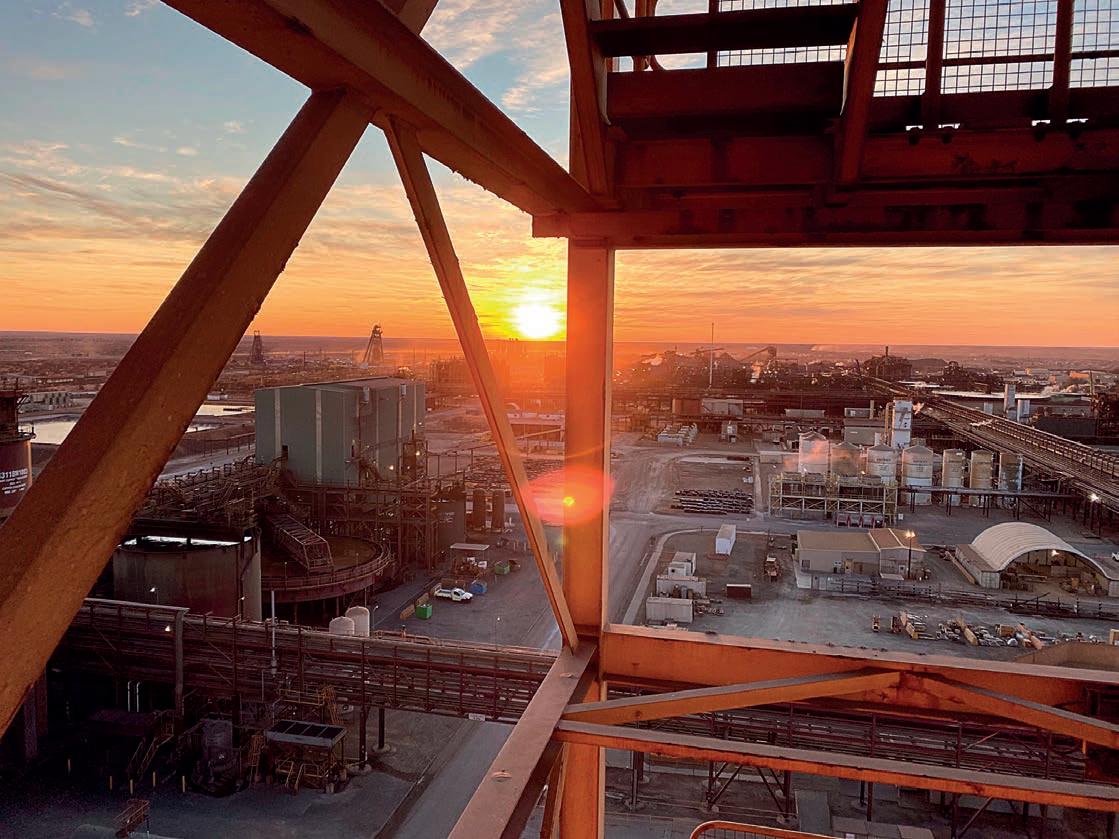
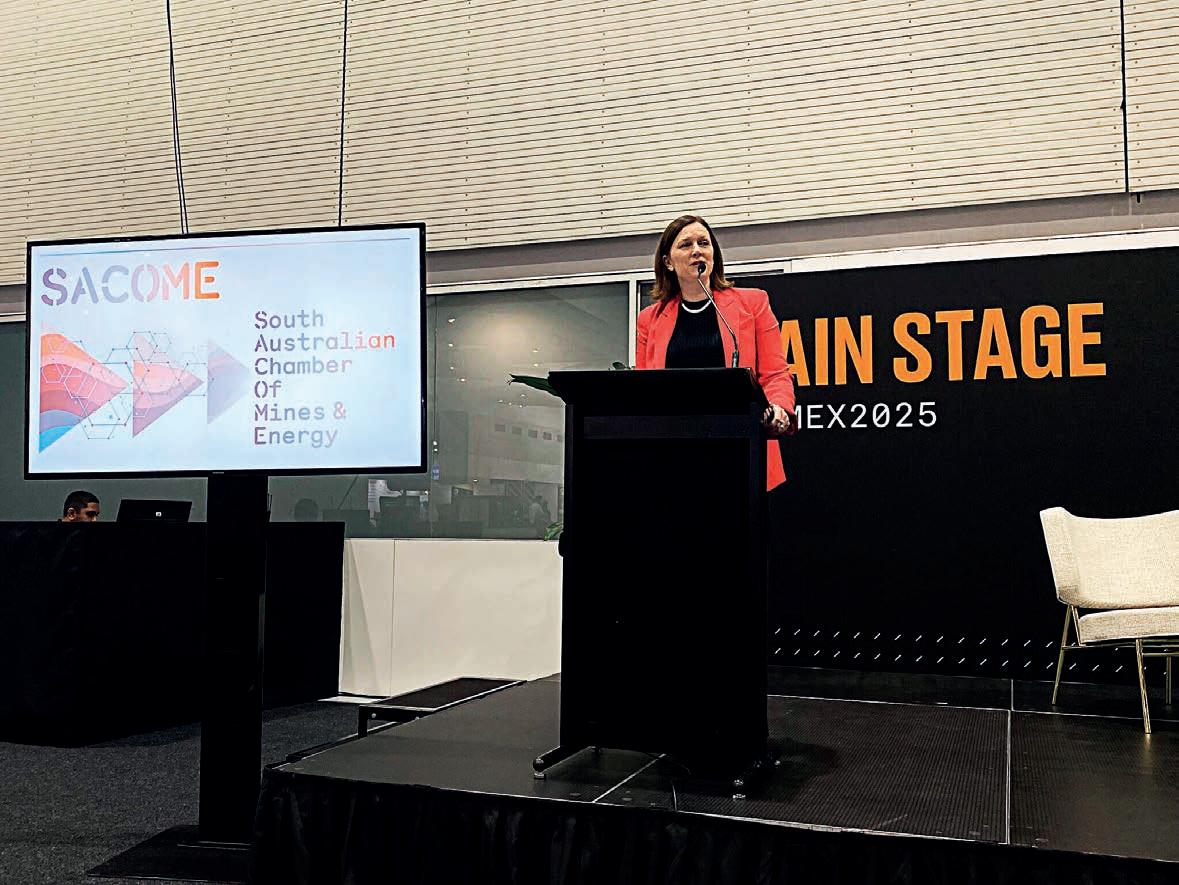
policies currently in place or announced, countries around the world are on track to double overall mineral requirements for clean energy technologies by 2040.
While decarbonisation signals a decline of fossil fuel extraction, it accelerates the need for minerals like copper as a step away from emitting greenhouse gasses. But the balance must

be considered, with the IEA citing that a typical electric vehicle (EV) requires roughly six times more mineral inputs than a petrol car and an onshore wind plant needs around nine time more minerals than a gas plant.
By the same token, meeting the goal of limiting global temperature rise to below 2°C will require a fourfold increase in mineral demand for clean energy technologies by 2040.
For SA, a step to tackling these requirements could prove to be more within reach According to Bhatti, despite the significant organic copper growth that BHP has seen in the state, there are equal, if not greater, strides being made in drawing down the
company’s emissions and “ensuring that we displace diesel as quickly as possible”.
“We’re very fortunate that in this part of the world we have access to the copper province in South Australia, and the growth that we have planned in all three of those assets [Olympic Dam, Prominent Hill, Carrapateena] are immense,” he said.
“Not just from exploration, concentrator or a smelter point of view but also working hand-in-hand with the government and looking at Northern Water to bring desalinated water from the south to the north where we would absolutely need it.”
Also speaking at AIMEX, SA’s Department for Energy and Mining
chief executive Paul Martyn told the audience that the state’s world-class mineral and energy reserves make it an attractive place for mining companies to do business.
Likewise, he said the integration of mining and energy industries is creating significant opportunities while also contributing to global decarbonisation efforts.
“We have a unique combination of resources and renewable energy capability, which positions SA to be at the forefront of the global energy transition,” he said.
Taking a similar stance during his own AIMEX keynote, SA Treasurer Minister for Energy and Mining Tom Koutsantonis said the state is one “on the move” and that mining is “now a pillar of the South Australian economy”.
“[AIMEX] delegates will see what is possible here in South Australia, whether it’s innovation and data, automation and technology, where it means pioneering working productivity, safety and sustainability,” Koutsantonis said.
The minister believes the mining industry’s investment in leadership and growing the supply chain is helping in growing Australia’s prosperity.
“Our state comprises about six to seven per cent of the country’s economic output, but mining is becoming one of the largest sectors within South Australia, and hopefully over the next decade, we’ll see that dramatically increase,” he said.

Koutsantonis as clear in echoing McFarlane’s thoughts on the ongoing importance of the industry.
“The world is changing dramatically, and we’re seeing the shift towards decarbonisation,” he said. “And that decarbonisation does not require less mining, it requires more mining.” AM
When Gold Fields set out to expand its Agnew gold mine in Western Australia, it faced a familiar – if formidable – challenge: how to increase throughput from an ageing plant without compromising safety or reliability.
The site’s 21-year-old tertiary crushing circuit had served faithfully, but it was no longer capable of meeting the demands of a third underground source.
Rather than simply replacing worn-out assets, Gold Fields saw an opportunity to rethink how crushing and screening could drive efficiency and energy savings across the operation.
The result, developed in partnership with Sandvik Rock Processing, was a state-of-the-art circuit that has transformed performance, reduced energy consumption, and earned Agnew recognition at the 2025 Australian Mining Prospect Awards, taking out the Mine Performance of the Year category, as well as the coveted and Australian Mine of the Year Award.
Finer, smarter, faster
Speaking on a panel at the recent 2025 Asia-Pacific’s International Mining Exhibition (AIMEX), Gold Fields manager – processing Tristan Freemantle said the upgrade delivered an immediate and measurable improvement in performance.
“The old circuit produced eight to 10mm feed; the new circuit consistently delivers around 6.5mm,” Freemantle said.
“That seemingly small reduction has had a big impact on production. We’ve lifted plant throughput from roughly 120 to 150 tonnes an hour to around 170 tonnes.
“A finer product also reduces energy use in grinding – about an 18 per cent saving – because the grinding circuit does less work and uses less media. Ultimately, finer and more consistent feed stabilises the circuit, which is critical in gold processing.”
Achieving that finer, more consistent product came down to intelligent control systems and precise engineering.
Sandvik Rock Processing product line sales manager of crushing solutions Shannon McNab explained that automation was key.
“We read real-time data on crusher position and load, then adjust on the fly to drive optimal power and pressure, essentially putting in as much controlled energy as needed to get the desired output,” McNab said on the panel.
“Automated metal-to-metal calibration removes opportunities for human error. Chamber design also matters; we aim for more rock-onrock crushing where beneficial. Those elements together keep the product fine and consistent.”
The redesigned circuit also brought a major simplification to screening.
Sandvik Rock Processing global product manager – SM screens and feeders –Nic Millett said the new configuration consolidated two screening stations into a single multi-slope vibrating screen, reducing maintenance while improving efficiency.
“If one screen can do the job, you reduce maintenance, parts and confinedspace entries,” Millett said on the panel. “Early design iterations considered two screens, but we moved to a single-screen operation. It does require thoughtful conveyor layout to split products to
secondary and tertiary crushing as needed, but you’re ultimately caring for one asset.
“With a 30mm top deck and appropriate media, it achieves the required throughput, up to around 250 to 300 tonnes an hour, for the circuit.”
The screen’s multi-slope design provided a clever way to achieve high capacity within Agnew’s existing footprint.
“The multi-slope design provides a larger screening area in the same footprint versus a conventional horizontal screen,” Millett said. “The steeper feed section transports material quickly early on, improving natural stratification so fines see the apertures sooner. That combination optimises efficiency within tight layout constraints.”
For Gold Fields Metallurgy Manager, Reg Radford, the project’s impact on energy efficiency has been one of its biggest achievements.

“Power is one of the biggest costs in processing,” Radford said on the


panel. “Grinding circuits are inherently inefficient, so putting more energy into crushing up front pays off. Agnew sees variable ore hardness – older areas are pretty hard – and previously when treating harder ore, throughput could drop to about 140 tonnes an hour
“By crushing to roughly 6.5mm instead of 10mm, we remove top size and reduce the grinding bottleneck, improving liberation and efficiency in the mill. Every kilowatt saved in comminution saves dollars.”
Agnew operates a hybrid power station combining wind, solar and gas, which means every increment of energy efficiency strengthens the mine’s broader sustainability credentials.
“You’re effectively doing the same tonnes with less energy per tonne, improving unit costs,” Radford said. “The freed-up power can support other demands, like underground ventilation.”
A central objective for Gold Fields was to modernise its operations and reduce manual intervention. Freemantle said integration of the Sandvik technology into the site’s existing control systems delivered that outcome seamlessly.
“During selection we were clear: the equipment had to integrate with our existing process control, not a separate black box,” he said. “The Sandvik units sit on our site control system; we have full visibility and can adjust setpoints as needed. Critically, the crushers selfadjust and maintain the gap, sustaining product consistency.
“The old crusher was originally a one-year stopgap that lasted 21 years and required a lot of manual intervention. Now our operators run the plant from a central control room; they’re not out in the field manually adjusting crushers and gaps. It’s automated and alarm-driven, improving both safety and efficiency.”
The new system, Freemantle said, fits neatly within Gold Fields’ wider technology roadmap, which includes Agnew’s pioneering hybrid renewable power project.
Building through collaboration
From design to commissioning, the partnership between Gold Fields and Sandvik proved essential to the project’s success, particularly as the build coincided with the height of COVID disruptions.
“We engaged multiple vendors initially, then collaborated closely to build a circuit on a constrained footprint without impacting production,” Radford said. “The old circuit sat near grinding and leach; the new one was built up on a hill, with ‘skyway’ conveyors tying it in. So creativity was essential.”
Global shutdowns forced both partners to adapt quickly.
“COVID hit as we were fabricating,” Freemantle said. “We de-risked by splitting supply, some structures in Spain, other components elsewhere in Europe. When one factory shut for six weeks, we progressed other work and staged construction.
“Some suppliers thought our chosen location was ambitious, but we did the assessments and designed suitable foundations. Continuous collaboration kept the schedule moving during a very challenging period; without it, we’d have been stalled for 12 months.”
From Sandvik’s side, Millett said the partnership worked because both teams committed to open communication and technical alignment.
“Collaboration began at application sizing and ran through detailed mechanical design, structural interfaces and commissioning,” he said.
“Machine mass and dynamic loads must match structural design,



and installation has to deliver the performance we modelled, so ongoing dialogue with site teams was critical.”
McNab agreed that cooperation was key not just to delivery but to longterm performance.
“The collaboration has been exemplary, transparent communication and openness to design choices,” he said.
“Even though the plant is delivered, the partnership continues through spares, service, optimisation and product support. It’s a long-term commitment.”
As the circuit settles into steadystate operation, the focus has now shifted to optimisation and continuous improvement.
“You quickly move from project to operations,” Millett said.
“Reliability and stability are everything; once stable, you can drive continuous improvement.
“Ongoing relationships with OEMs [original equipment manufacturers], including Sandvik’s service teams, keep the plant optimised.
For Radford, the relationship between Gold Fields and Sandvik extends well beyond the new plant.
“Gold Fields relies heavily on Sandvik for underground equipment, and we value that support,” he said.
“We’re a significant customer, but we also have the option to go elsewhere. We’ve stayed with Sandvik because the partnership works across fixed plant and underground.”
The Agnew crushing and screening upgrade is a model for how collaboration, technology and project management can unlock efficiency and sustainability in modern mining.
By integrating intelligent controls, simplified design and energy-efficient equipment, Gold Fields and Sandvik have created a “set-and-forget” plant that not only boosts throughput but also aligns with the mine’s long-term decarbonisation goals.
For a mine that “just keeps on giving,” the partnership has ensured Agnew will continue delivering – smarter, safer and more sustainably than ever. AM
HOW REMOTE SITES COLLECT AND SHARE DATA.
Remote Australian mines face a persistent challenge: transmitting real-time data in rugged environments that punish network infrastructure. Irregular pit walls and shifting terrain often block or scatter Wi-Fi radio signals, making coverage patchy and unreliable.
Traditional approaches – towers, fixed cabling or moveable trailers – can be costly and maintenance-heavy as IT staff struggle to constantly adjust coverage where it’s needed.
Work on a remote gold mine, Iron Mine Contracting (IMC) tested an interesting alternative.
IMC deployed a fleet management system, supplied by mining technology provider Haultrax, using ruggedised satellite terminals supplied by Vocus and mounted directly on excavators. Each excavator-mounted sat-pod broadcasts Wi-Fi around itself, creating a coverage zone wherever it works.
“Instead of building infrastructure around equipment, the connectivity simply moves with it,” Vocus head of space and wireless operations Ashley Neale said.
The system takes advantage of the few minutes haul trucks take sitting idle while being loaded by an excavator. During this time, they automatically upload the operational data they’ve collected while moving around the site through the excavator’s Wi-Fi hotspot, connected back to a Starlink satellite.
On the mine site, located in the Murchison region of Western Australia, two excavators were fitted with customised mounting kits developed with Kali-tech Aboriginal Corporation.
Each carries a Vocus Satellite –Starlink terminal, router, Wi-Fi and power supply. The configuration allows operational data to flow without manual intervention, even in the absence of mobile coverage.
“The impressive speeds of Starlink mean a lot of data can be transmitted in a short window,” Neale said. “Short Interval Control reporting data can easily be transmitted during the few minutes of loading,”
“The true value of mining data is in its ability to guide real-time operational decisions – not just retrospective office analysis. Haultrax technology, matched with satellite connectivity on excavators means data can be captured and shared in realtime,” Haultrax digital operational lead Lorenzo Scalabrini said.
“That means operations have the ability to make fast, informed decisions to keep productivity, safety and performance on track.”
“That means mining operations can make fast and safe decisions in response to what’s actually happening in the mine to optimise operations, whether they’re in early exploration or managing a fullscale operation.”
For exploration sites and trial mines, a system like this is attractive – with permanent networks hard to justify. These operations often run on uncertain timelines, making permanent fibre and private mobile network builds impractical.
Satellite systems mounted on equipment avoid high initial installation costs. Instead of up-front capital expenditure, projects pay a monthly subscription, with exploration teams able to begin capturing data from day one – rather than waiting months for a network to be built.
Figures from the Australian Bureau of Statistics show mineral exploration expenditure reached more than $1 billion in the June 2024 quarter. Analysts note much of this investment is in early-stage exploration, where short timeframes make flexible digital infrastructure particularly attractive.
Mining’s cautious approach to new technology stems in part from painful history. In the mid-2010s, several highprofile mine digitisation programs were
SATELLITE TERMINALS ARE MOUNTED DIRECTLY ONTO EXCAVATORS.
technology struggled to keep pace with mine development.
Fixed Wi-Fi towers and mobile WiFi trailers proved troublesome in some instances as pits expanded, and tech staff found themselves constantly chasing coverage blackspots.
The mine site trial suggests a more modern alternative. By allowing connectivity to move with the machinery, blackspots become a non-issue provided there’s clear line of sight to the sky.
“Fibre coupled with a private mobile network remains the benchmark for security and broad coverage across large operations,” Neale said.
“However, mobile satellite solutions
coverage and low up-front costs for exploration, early development or simply to maintain visibility if a primary network fails.”
The deployment highlights that connectivity no longer needs to be a binary choice between costly permanent infrastructure and inadequate Wi-Fi solutions.
The proof is in the pudding – with IMC seeing solutions as a major win.
“This is how we commit: never walk past a problem – always take actions,” IMC general manager of mining James Chomley said. “By working with industry partners, we’re delivering practical tech that solves real operational challenge.” AM


enike as commerciali e electi e eat re reatment . . . . ec nolo in artners i wit rescen ec nolo ies rin in soli -state microwa e ener from t e la to t e mine. omminution consumes of t e worl s ener an . . . . re uces t is eman re eatin an weakenin ore. e result is lower mec anical ener nee s im ro e mineral li eration an stron er erformance in rin in flotation an leac in . it s stems esi ne er site re uirements . . . . offers a clear at wa to lower costs lower car on an i er efficienc in mineral rocessin . To read







WITH SUCH A WIDE RANGE OF HOUSED
TIMKEN HAS AN ANSWER TO KEEP PRODUCTION ROLLING.
Bearings are a fundamental aspect of everyday life on a mine site. They are critical to the success of operations but can often be overlooked and underappreciated. When a single bearing fails, operations can come to a drastic halt – potentially costing tens of thousands of dollars per hour of lost production.
Timken, a global technology leader in engineered bearing and industrial motion, can provide a simple solution to such a problem.
“We’ve had experience that many mine sites just accept that some bearings have a relatively short life because of where they’re placed or the load they’re under; we want to look at the root cause and have a solution to solve that specific issue, whether it be an issue around sealing, installation or maintenance,” Timken national mining manager Mark Davies told Australian Mining
“This puts us in a better position to best serve our customers, as it’ll certainly ensure equipment’s going to work in the long-run and will reduce the total cost of ownership.”
With one of the broadest ranges of housed bearing units on the market, Timken can offer a solution to ensure equipment can continue to operate. Timken can offer ball, spherical roller, tapered roller, and split cylindrical roller bearings mounted in a range of housing designs and materials.
By combining cutting-edge engineering with 125 years of experience, Timken collaborates with its clients to solve complex challenges and advance industries worldwide. With a global reach along with local know-how, technology and expertise can be deployed when and where it matters most.
“We focus on helping our customers choose what’s the right solution for them,” Davies said.
“It’s very rare that bearings fail because of fatigue life; they normally fail from contamination or lubrication issues. In many cases, you’ve got a relatively young bearing that can show signs of wear and because of water getting in, effecting the lubricates efficiency. A more robust sealing system gives you better protection and keeps lubrication as clean as possible.”
With different housed units for mine site applications, such as the spherical roller bearing SNT HUs common on conveyor pulleys, or solid-block (cast steel) housed units for impact crushers or conveyors and split cylindrical roller bearing units for drive shaft (trapped) applications, solutions can be tailored to specific sites and applications.
“Anywhere there’s a lot of vibration or impact, our solid block house units can handle that kind of pressure,” Davies said.
In addition, solid block housed units can run efficiently on misaligned shafts up to 1.5° without a reduction in life expectancy or sealing efficiency, as the primary seals run on the extended inner ring of the spherical roller bearing.
Other applications for the housed units include high-speed fans or in crusher applications
Timken’s split CRB housed units are specifically designed to fit in hard-toreach trapped applications
solution, which can be built around the shaft of a machine to make in-situ installation a time efficient option.
“It means you’re not needing to totally disassemble a piece of machinery to fix or replace bearings,” Davies said.
“A split cylindrical housed unit can quite comfortably fit in a confined space and can rotate at high speeds, making it a perfect solution for fan and drive shaft applications.”
This, according to Timken, means maximum uptime can be achieved, with installation times cut by up to 90 per cent by reducing the time needed to disassemble drive motors and/or gearboxes to fit a bearing housed unit.
“The range of housed unit designs we provide are easy to fit, and with the correct mounting procedures the bearing is set correctly to achieve a long operating life. This minimises downtime and maximises uptime,” Davies said.
With constant research and

experts known for their rigorous thinking and exceptional accessibility, Timken continues to make new housed units designs for customer applications worldwide. AM

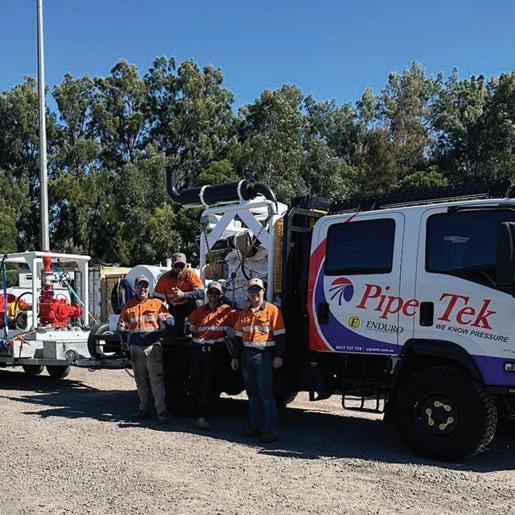


WHEN CRITICAL POWER SOLUTIONS ARE NEEDED FAST, AUSTRALIAN POWER EQUIPMENT DELIVERS WITH SPEED, SUSTAINABILITY AND TECHNICAL PROWESS.
In today’s mining and resources sector, reliable power is not just an operational necessity, it is a critical enabler of safety, productivity and business continuity.
For Australian Power Equipment (APE), meeting those needs goes hand-in-hand with a commitment to sustainability and innovation.
Founded with a mission to provide new and refurbished high-voltage equipment to Australia’s mining, tunnelling, renewables agribusiness and defence sectors, APE has quickly become a trusted partner for clients requiring technical expertise and fast response times. The company’s circulareconomy approach reduces waste and delivers cost-effective solutions, while its partnerships with wildlife organisations help to ensure sustainability extends beyond equipment and into broader environmental stewardship.
to respond rapidly when clients face critical challenges.
A recent project for one of its key customers illustrates this difference.
APE was approached by a longstanding client requiring an emergency back-up power supply to keep operations running. The requirement was significant – five mega volt-amperes (MVA) of step-up transformers, configured as 2x2.5MVA mobile transformers, to deliver 11-kilovolt (kV) power over a six-week period.
The challenge was compounded by the timeline. Delivery was required within just two weeks, including design adjustments, approvals, equipment preparation and commissioning. Meeting this schedule would be demanding under any circumstances, but APE’s team was determined to deliver.
APE leveraged its available stock
The solution included two 2.5MVA 11/415 transformers – mobile, bunded designs for flexibility and environmental safety, a mobile earthing transformer, which was also bunded, a 10-Amp neutral earthing resistor (NER) with integrated NER monitoring for earth system monitoring, an 11kV ring main unit (RMU) with inter-tripping for reliable protection. All of the equipment was pre-commissioned prior to shipping to ensure seamless installation
Mobility was a critical factor and all equipment was therefore delivered in mobile form, allowing easy installation and rapid demobilisation at the project’s conclusion.
Owing to the close coordination between APE’s engineering, operations and logistics teams, the entire project was delivered within the two-week timeframe. Equipment arrived precommissioned, enabling swift on-site installation alongside APE’s delivery and installation partners.
“The speed of delivery in this case was critical,” APE director Andrew Cockbain said. “In the mining sector, even short delays in power supply can lead to costly shutdowns.
“By acting quickly and drawing on both our technical expertise and our stockholding capability, we ensured our client avoided significant downtime and financial impact.”
The system was commissioned without issue and performed reliably throughout the six-week operational period, ensuring the client’s power needs were fully supported.
While speed and on-budget delivery was the defining feature of this project, it did not come at the expense of sustainability – a principle embedded in every APE initiative.

By drawing on refurbished and readily available stock equipment, APE minimised the environmental footprint of manufacturing new assets. Mobile bunded designs ensured the highest standards of environmental

“As we look across the mining and infrastructure sectors, we are seeing more and more of our Tier 1 and Tier 2 clients focus on the sustainability of their supply chain,” APE director Abby Crawford said.

procurement choices align with their ESG [environmental, social and governance] commitments.”
The APE team understands that the mining and resources sector faces ever-increasing challenges
in balancing reliability, cost and sustainability. Its role is to provide solutions that keep critical operations powered, whether through rapid response to emergencies or through long-term partnerships focused on innovation and environmental responsibility.

its capability to combine technical excellence with sustainability, agility and collaboration.
The successful delivery of this urgent back-up power solution highlights
As APE continues to expand its offerings, it remains committed to supporting clients with solutions that not only solve immediate challenges but contribute to a more sustainable future for Australia’s power and resources industries. AM
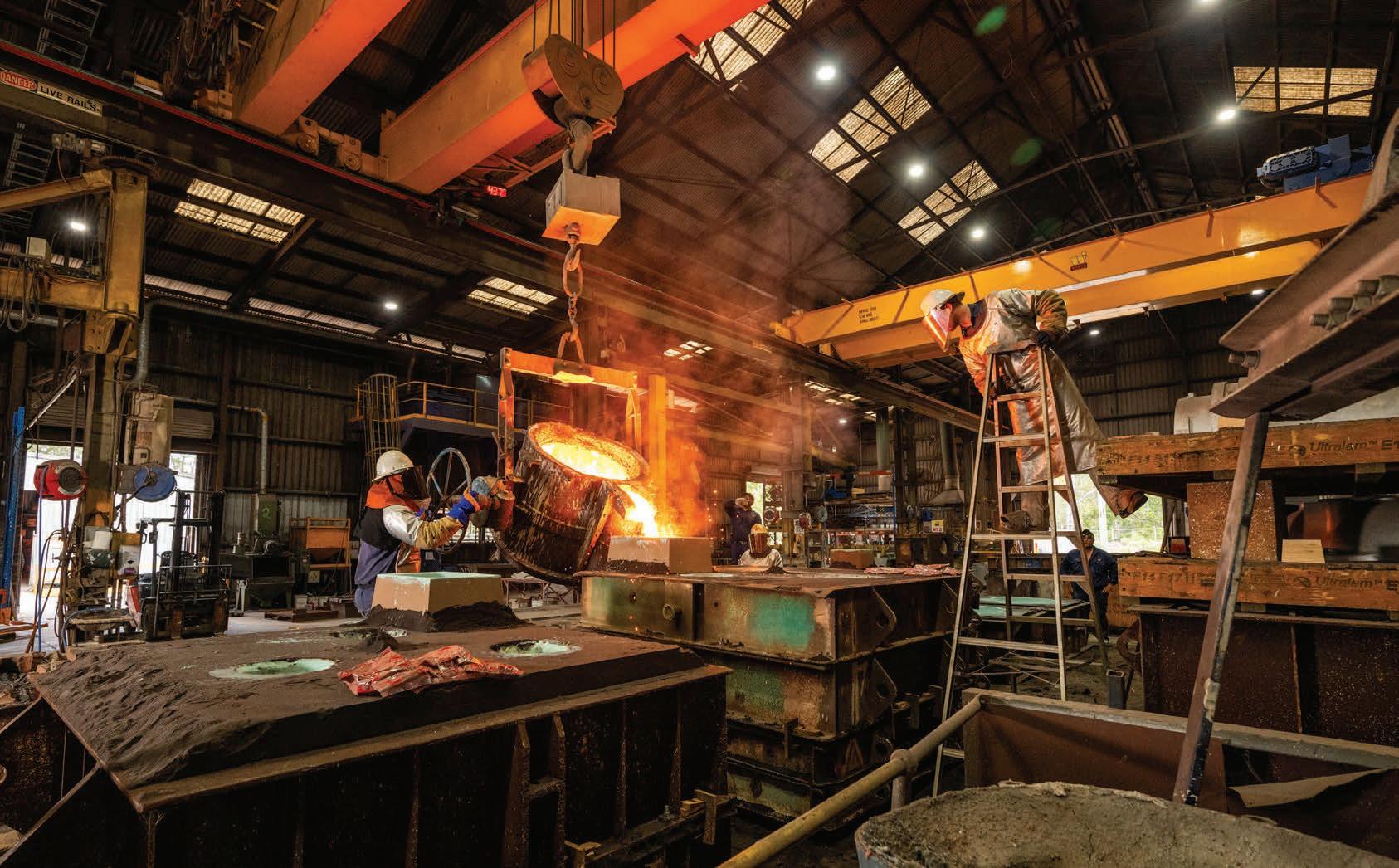
PROCESSING EQUIPMENT TENDS TO WEAR QUICKLY, BUT NOT WITH THE RIGHT WEARING COMPOUND AND PRODUCT KNOWLEDGE.
Mineral processing equipment operates in some of the most demanding conditions of any industry across Australia. However, even in these conditions, unplanned downtime is not an option.
Unexpected maintenance for larger miners could be as high as $US500,000 every hour.
Henkel, a global supplier of adhesives, sealants,and coatings, is working with mine sites to improve plant efficiency, strengthen plant safety, reduce costs and, most importantly, increase the reliability of equipment.
“Urgent repair – otherwise known as breakdown maintenance – is costly in terms of labour materials and production loss, and bad for production planning,” Henkel Australia Pacific application engineering lead Zhonghua Zhang said.
“Money piles up every second, minute and hour of unplanned shutdown. That’s when a fast-curing product becomes critical.”
Different site, different problems
Mine sites each encounter unique problems, so there’s no ‘one-size-fitsall’ approach. This is why many mining engineers rely on Henkel to take the guesswork out of machinery protection.
With products for a range of problems and applications, such as dealing with particle abrasion in wet and dry conditions, Henkel acts as a strategic partner to mine sites, guiding decisionmakers through maintenance processes.
But why are issues coming up in the first place? It’s not always because of poor product selection, but rather improper application and limited knowledge.
“Many of today’s engineers may not have a good understanding of what’s in the product. The challenge is to educate them on the chemistry and application,” Henkel APAC regional business development manager Kalyan Roychowdhury said. “A better knowledge of the product and how it works will reduce the likelihood of corners being cut.”

The company offers robust training programs to help ensure everyone on-site is on the same page about the correct application techniques and product characteristics.
Particle abrasion in dry conditions, for example, needs a ceramic-based compound containing aluminium oxide. This information is pivotal in reducing potential downtime and ensure operations can run smoothly.
of improper practice
Many sites are often in a rush to keep things operating smoothly but that can lead to bigger issues down the line, with common mistakes like lack of surface preparation, confusion over mixing instructions, or improper thickness of application becoming increasingly frequent. While seemingly small, these issues can grow into a much bigger burden.
“Taking a little extra time to ensure proper application leads to significant long-term gains, saving both time and money,” Zhang said.
This was emphasised by Zhang, who outlined the different properties of products.
“The curing time for one product may be eight hours, but that’s at room temperature. In winter, lower temperatures will alter the curing


time, but the people doing the application don’t always take this into account,” he said.
When application is rushed, the potential for costly mistakes increases, with inadequate covering leading to accelerated wear and frequent breakdowns, creating repair costs that could have easily been avoided.
Henkel is no stranger to problems such as this. The company recently supported a major mining facility with bends of metal in a slurry pump house. Due to extreme abrasion the bend typically wore out within
20–25 days, but with the LOCTITE PC 7332 silicon carbide wearing compound, a layer of protection was applied designed to shield metal from direct slurry impact and wear and provided an extra 60-day lifespan of the pipe.
The outcome? Increased downtime, greater operational efficiency and cost savings of $US24,000.
With innovative products backed with deep industry experience and support, it’s no surprise Henkel is at the forefront of promoting best practice for mine maintenance. AM

At Beca, we’re proud to stand alongside clients who are transforming industries and communities. As one of Asia Pacific’s largest independent advisory, design and engineering consultancies, we bring over a century of experience and a team of more than 4,750 professionals across 21 offices worldwide. Our purpose is simple: to make everyday better.
In Australia’s mining and minerals sector, we combine deep local knowledge with global expertise to deliver smart, sustainable solutions that help our clients optimise operations, reduce risk, and achieve long-term success. With offices across the eastern seaboard - including Adelaide, Sydney, Melbourne, Brisbane, and regional centres - we’re well positioned to support projects wherever our clients need us.
ꞏ Business Case Development to Closure: Concept studies, FEED, detailed design, shutdown support, maintenance management, and closure planning and implementation
ꞏ Sustainability & Decarbonisation: Tailored roadmaps for emissions reduction and energy efficiency
ꞏ Specialist Engineering: Crushing, screening, materials handling, pyrometallurgy, water treatment, and more
ꞏ Plant & Process: Flowsheet Development, Test Work Management, Plant Design
ꞏ Infrastructure: Earthworks, Geotech, Power, Water, Roads, Rail, Airports, Ports
ꞏ Asset Services: Evaluation, Remediation, Closure
ꞏ Shutdowns: Planning, Management, Reviews
ꞏ Advisory: Business Transformation, Performance Reviews, De-bottlenecking
ꞏ Long-term partnerships with BlueScope Steel, Rio Tinto, Nyrstar, OneSteel and other key Australian resource operations
ꞏ Delivery of major expansion projects, process optimisation, and infrastructure upgrades
ꞏ Strategic support for carbon neutrality goals and energy transition programs
ꞏ Integrated teams of engineers, project managers, and sustainability experts
ꞏ On-the-ground support across Australia, backed by global technical networks
For more information please contact: Tristan Musgrave Business Director - Mineral & Metals Tristan.Musgrave@beca.com
THE RIO TINTO–VIVA ENERGY TRIAL DEMONSTRATES THAT SCALABLE SOLUTIONS FOR REDUCING EMISSIONS EXIST.

Rdiesel at the major miner’s Pilbara operations.
For Rio Tinto, the trial is part of the company’s sustainability targets, which include a 50 per cent reduction in Scope 1 and 2 emissions by 2030 and reaching net-zero by 2050.
“Diesel makes up about 70 per cent of the total carbon emissions from our Pilbara iron ore operations,” Rio Tinto managing director rail, port and core services Richard Cohen told Australian Mining
“While electrification is the ultimate longer-term solution for repowering the majority of our fleet, we’re also exploring biofuels as a complementary and nearer-term solution.”
Also known as hydrotreated vegetable oil, renewable diesel is made by hydrotreating waste vegetable oils and animal fats with hydrogen and catalysts. It reduces carbon emissions without modifications to existing diesel machinery and can be used across mining, transport, construction and agriculture.
The trial builds on previous successes at Boron and Kennecott operations in the US, where 11 per cent of global fossil diesel consumption has already been replaced with renewable diesel.
“This trial effectively demonstrated the critical role renewable diesel is going to play in reducing the carbon footprint of Australia’s heavy industry,” Rio Tinto sales manager at Viva Energy Gavin Syminton said.
“Viva Energy is proud to be working alongside key partners like Rio Tinto to help them to identify the right lowcarbon solution to meet their specific business needs.”
integration and supply chain logistics. The results were substantial. Rio Tinto reduced Scope 1 emissions by approximately 27,000 tonnes, equivalent to removing the annual tailpipe emissions of 6302 cars per year.
Beyond emissions reduction, the trial provided a deeper understanding of bulk supply, blending processes, and potential scalability across Rio Tinto’s Australian operations.
Viva Energy will continue supporting the supply and storage of renewable diesel, helping scale its use across
VIVA ENERGY IS PROUD TO BE WORKING ALONGSIDE KEY PARTNERS LIKE RIO TINTO TO HELP THEM TO IDENTIFY THE RIGHT LOW-CARBON SOLUTION TO MEET THEIR SPECIFIC BUSINESS NEEDS.”
The collaboration between the two companies has spanned more than 45 years, primarily focused on fuel and lubricant supply.
This long-standing partnership made the move to renewable diesel a natural progression, with both companies aligned in their operational and sustainability goals.
A 20 per cent blend of renewable diesel was used during the trial, offering important insights into operational
operations and further reduce emissions.
Rio Tinto is developing a pongamia seed farm in North Queensland as part of a biofuels pilot, exploring the potential of pongamia seed oil as a feedstock for renewable diesel.
Renewable diesel offers multiple advantages for the mining sector. The fact it is a drop-in fuel means it requires no modifications to machinery or storage, making it a practical solution for immediate carbon reduction.
It can also serve as a bridge where electrification or hydrogen technologies may not yet be feasible, particularly in remote or heavy-duty operations.
Wider adoption of renewable diesel requires several steps. Local infrastructure must be adapted to handle higher volumes of biofuels, domestic production capacity must grow, and government incentives could support the development of a robust Australian alternative fuels sector.
Reliable supply chains are also critical to ensuring consistent production and delivery to heavy industries.
Leadership from mining companies and fuel suppliers is key to driving adoption. By setting a precedent, companies like Rio Tinto encourage collaboration, innovation and investment, helping accelerate the transition to sustainable energy sources.
Looking ahead, renewable diesel provides a practical solution while the industry develops longer-term technologies such as electrification and hydrogen.
The Rio Tinto–Viva Energy trial demonstrates that scalable solutions for reducing emissions already exist.
With continued leadership, strategic partnerships and supportive policy, renewable diesel could become a cornerstone of Australia’s heavy industry decarbonisation journey. AM


Optimize Planned vs. Unplanned Maintenance for peak efficiency
Reduce unplanned maintenance hours and disruptions
Lower total maintenance expenses
Enhance annual plant output and operational performance
Save significantly on repair and maintenance costs
Extend the equipment lifespan with smarter, AI-driven maintenance strategies
Join the revolution in AI-driven predictive maintenan Get in touch today.



Scan the QR code to contact us




































































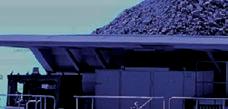












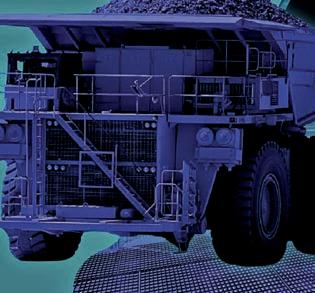
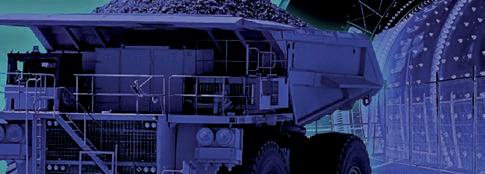



























































WITH GOLD PRICES HITTING RECORD HIGHS, JUNIOR EXPLORERS ARE ATTRACTING INVESTMENT. AUSTRALIAN MINING LOOKS AT TWO ADVANCING PROJECTS IN PROVEN PROVINCES.
When asked in September for the best time to be in gold exploration, Falcon Metals managing director Tim Markwell didn’t skip a beat.
“The 1850s,” he said, referencing Victoria’s legendary gold rush. “But right now is a very close second.”
With gold prices surging past $US4000 per ounce in October, Markwell’s optimism is shared across Australia’s junior exploration sector.
On the other side of the country, David Richardson has watched this moment approach for years. The Magmatic Resources managing director points to a pattern that has played out since the global financial crisis. When gold rallies, major producers recover first, then months pass before investors look further down the value chain.
“Juniors take three to six months to follow the majors after a recovery,” he said. “At some stage, investors have to come down the value chain.”
That shift appears to be underway. With consolidation at the producer level making new acquisitions harder to find, and years of under-investment in greenfields exploration, institutional and retail investors are turning attention to junior explorers with projects in proven Australian gold provinces.
Falcon’s Blue Moon prospect in Victoria and Magmatic’s Weebo project in Western Australia fit that bill perfectly, and each company is gaining a lot of attention as a result.
Window of opportunity
Investor reluctance to back junior explorers has deep roots. Since the global financial crisis of the last decade, consolidation among major producers
has dominated the gold sector, often leaving exploration budgets stretched.
The current gold rally also differs from previous cycles. Richardson said gold is responding to risk and geopolitical uncertainty, with central banks increasing their gold reserves.
“Gold is the alternative to the US dollar now,” he said. “For junior explorers, the challenge is capitalising on the window. Our challenge is to find gold that can come out of the ground while we’re up [at high gold price levels].”
Falcon Metals entered the market at an opportune moment. The industry’s attention was centred on a spectacular new discovery at Fosterville in Victoria, giving the company the chance to quietly secure a section of a historic mine just 25km away.
“While everyone was so focused on Fosterville, no one was paying any attention to Bendigo,” Markwell said.
The company pegged an exploration licence in late-2021 that had drawn minimal interest, despite sitting along strike from a goldfield that is known to have produced 22 million ounces between 1851 and the First World War.
More importantly, the northern extension had never been drilled.
Falcon had studied the existing records extensively, even hiring a historian to comb through library archives of the old Bendigo mines. The company targeted the Garden Gully Line, which had produced 5.2 million ounces on its own and extended right to the tenement boundary.
That first hole on the northern extension and subsequent wedge holes intersected multiple mineralised structures from surface to 800m depth, with high-grade zones returning 543 grams per tonne (g/t) gold, 185g/t gold, and 48.7g/t gold.
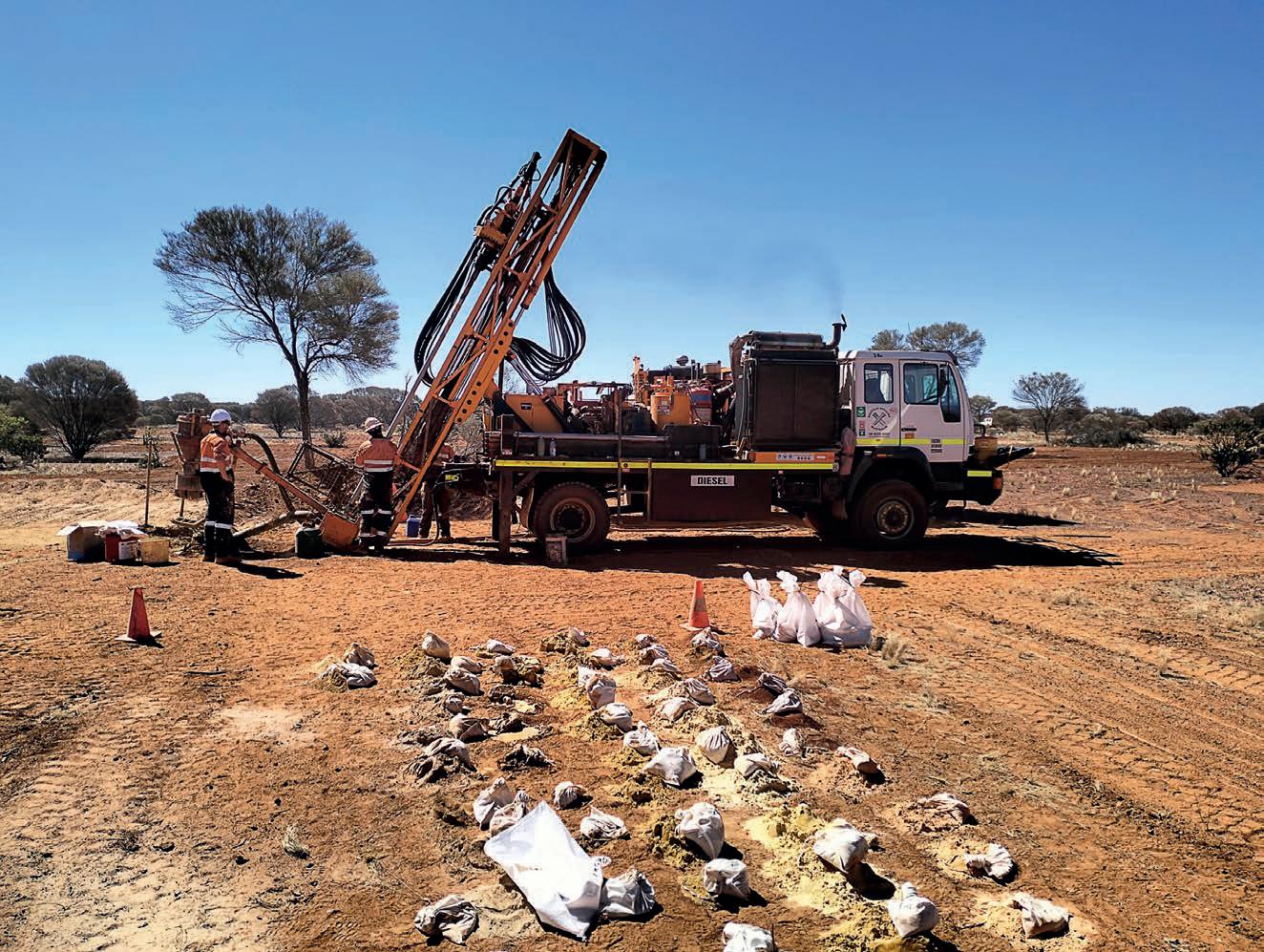
The company has since completed several more wedge holes across the fold structure and has recently raised $20 million to accelerate the program. A second drill was due to mobilise in October, with plans to step out at 200m spacings along an initial 2km strike.
“We have all these lines of reef already laid out for us,” Markwell said. “It really is just a matter of drilling these holes and seeing what’s there.”
Magmatic Resources is taking a different approach to the same opportunity. While the company has a joint venture with Fortescue Metals Group targeting tier-one coppergold potential in New South Wales, Richardson sees Weebo as an immediate chance to generate near-term results in the current gold price environment.
The project sits within 30km of five operating gold mines in Western Australia, all with resources exceeding two million ounces. Three of those mines sit on the same greenstone belt as Weebo, with historical drilling at the project returning high-grade results.
Richardson said the initial results of Magmatic’s maiden drilling program completed at Weebo in September had delivered further high-grade intersections, providing momentum for the company with its next drill program expected to commence in November.
“We’re on the right rocks,” he said.
At the Ockerburry prospect, air-core drilling confirmed extensive shallow gold mineralisation associated with a 5km structure. Meanwhile, a single line of slim-line reverse circulation drilling at the Scone Stone prospect confirmed high-grade mineralised structures.
Beyond Magmatic’s upcoming drilling programs at Weebo, the next major inflection point will be delivering a maiden mineral resource estimate.
“If you release a resource that highlights how many ounces are in the ground, the grade, and there’s confidence it can be mined economically, that’s when you have something to sell,” Richardson said.
The Weebo project’s historical highgrade results combined with the positive returns of Magmatic’s maiden drill program give the company confidence as it moves towards resource drilling.
With $3.5 million committed to exploration at the Myall Project JV with Fortescue over the coming months providing regular newsflow, and a focused drilling program underway at the Weebo Gold Project, Magmatic is working towards that objective.
Richardson and Markwell are drilling in proven provinces with strong technical teams and funded programs. Whether the high gold price window stays open depends on factors beyond their control, but both are moving quickly to make the most of it.



Treotham is no stranger to the moving parts that keep Australia’s biggest operations running. Its igus energy chains and selflubricating bearings help to provide the answers to some of the industry’s challenges.
Treotham, the long-time exclusive distributor of igus products in Australia and New Zealand, understands that its offerings must be able to withstand the heat, dust, vibration and heavy loads associated with so many of Australia’s major industries, especially in the area of cable management.
“Traditional cable management and lubrication systems often fall short, resulting in increased downtime and maintenance costs,” a Treotham spokesperson said.
“igus energy chains provide a rugged, low-maintenance solution to keep power and data safely moving through machinery.
“Manufactured from highperformance polymers, they resist wear, corrosion and impact, making them ideal for mining environments where traditional systems quickly degrade.”
Energy chains are mechanical systems of links designed to safely guide and protect flexible cables and hoses that carry energy, data, fluids or air in moving machinery. Treotham said the modular design of the igus units allows easy installation, customisation and expansion, which it said is essential in fast-changing operations.


Keep it smooth
An added boon when it comes to less maintenance and greater reliability are igus’ iglidur bearings, a lubricated solution to the issues steel bearings
can face with heavy load impact, contamination and oiling failures.
According to Treotham, issues with these conventional bearings usually “consume grease and time”.

“Missed lubrication schedules often mean breakdowns and lost availability,” the Treotham spokesperson said. “The iglidur bearings eliminate that problem.
“These self-lubricating plain bearings extend wear life, reduce environmental impact and remove the need for relubrication or oil changes.”
Treotham’s Western Australia branch manager Danne Hallgren said igus iglidur bearings consistently exceed customer expectations on mine sites.
“The new igutex TX2 and TX3 ranges are engineered for extreme loads,” he said. “Their high-strength filament fabric and built-in slid lubricants deliver maintenance-free performance in the most demanding conditions, outlasting traditional greased metallic bearings.”
The iglidur bearings are used in crushers, conveyors and a wide range of other mining machinery where material stress is common.
Because of this niche focus, igus and its products have become standard for
Treotham and its modern automation systems, not only for lubrication properties but also overall endurance.
With more than three decades of partnership between the companies, Treotham’s igus product manager John Sharp previously told Australia Mining that collaboration and expertise are key to their success.
“We understand our product applications on a deeper level, and we can identify potential problems at the design stage,” Sharp said. “Our whole product range is customisable depending on the customer application. No two systems will be exactly the same, so we’re not just offering something off the shelf.”
Treotham believes it local support and immediate supply are key to its success working with clients.
“Backed by fully stocked warehouses and technical support across Australia, Treotham combines global innovation from igus with responsive local service,” the Treotham spokesperson said.
“The result is smarter, more durable solutions that reduce maintenance requirements, cut downtime and deliver measurable cost savings for the mining and bulk handling industries.”

When your mining operation processes waste on-site or through a provider, Waste Initiatives has solutions for common challenges at Australian mines.
Our WastePac systems provide a reliable entry point with safe, affordable shredding and compacting equipment, while our premium range tackles tyre waste. Barclay Shredders deliver unmatched durability, and when paired with Eagle International equipment, OTR tyre processing becomes efficient and reliable.
Backed by a national service team and locally stocked parts, Waste Initiatives is the smart choice for mine site waste challenges.


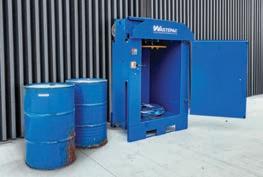
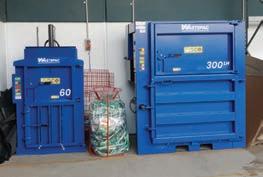
GREEN IRON IS ON THE GLOBAL MINING AGENDA, WITH COMPANIES LIKE BEDESCHI CREATING THE PATH FORWARD THROUGH TECHNICAL EXCELLENCE AND DESIGN VERSATILITY.
September this year saw the Australian Government announce an initiative aimed at attracting investment in the burgeoning green iron sector and complement the nation’s emerging and established mining projects, as well as its wind and solar energy infrastructure.
With an initial $500 million in funding available, the National Development Stream of the Green Iron Investment Fund is positioned to incentivise private investment and put Australia in pole position to lead the global shift to green energy and steel.
“Green iron is a major opportunity to grow Australia’s iron ore industry and build a new industrial sector,” Federal Minister for Industry and Innovation Tim Ayres said.
There’s little doubt Australia is among the pacesetters in the race to adopt more sustainable and environmentally friendly methods for iron ore processing and steelmaking. Yet achieving those ambitions will take more than funding.
Delivering the full benefits of a green steel transition depends on engineering excellence, innovation and problem-solving across every step of the production chain, from ore handling to direct reduction and final steelmaking.
That’s where companies like Bedeschi come in.
Technical excellence, forward-thinking
Bedeschi stands at the forefront of bulk material handling and transport, pioneering advanced solutions with Italian engineering excellence since 1908. Headquartered in Limena (Padua), Italy, the company merges tradition with innovation to serve a global clientele across the mining, cement, port and grain industries.
The family-owned outfit operates internationally with subsidiaries in Australia, the US, Germany and Hong Kong, specialising in delivering turnkey solutions and cutting-edge equipment designed for performance, reliability and sustainability.
As part of its global strategy, the company has expanded its presence through local subsidiary Bedeschi Australia, with a focus on the growing iron ore and green steel markets.
“Bedeschi has made significant contributions to the global green steel and energy transition in recent years,” Bedeschi Australia chief executive officer (CEO) Uwe Zulehner said.
“We’ve developed and delivered specialised machinery for the efficient handling of sensitive materials such as hot briquetted iron [HBI] and iron ore pellets. These aren’t standard solutions; they require a high degree
of customisation to meet strict quality standards and reduce environmental impact, especially when handling fines.”
With more than a century of experience, Bedeschi is recognised worldwide for its versatility and expertise
BEDESCHI SHIPLOADER DESIGNED FOR EFFICIENT, LOW-EMISSION HANDLING OF IRON ORE PELLETS AND HBI.


bulk materials. Its solutions are designed to enable the efficient movement and processing of a wide range of materials, including iron ore, cement, base metals and fertilisers.
This multi-faceted expertise is complemented by in-house capabilities. The company proudly operates its own manufacturing workshop in Italy, where it designs and produces key mechanical components to the highest standards of quality and precision.
This combination of technical mastery and direct production control allows Bedeschi to offer tailor-made solutions that consistently meet the evolving needs of its clients worldwide.
HBI is a densified briquette form of direct reduced iron (DRI), produced at temperatures exceeding 650°C. Known for its high density and purity, HBI is widely used in steelmaking either alongside scrap metal or as a standalone feedstock.
However, the handling of HBI poses specific challenges due to its physical properties and sensitivity to environmental conditions. Bedeschi addresses these issues with customised engineering solutions designed to ensure the safe, efficient and reliable movement of HBI throughout every stage of the handling process.
One of the most critical issues in HBI handling is minimising mechanical damage during transport. Since
to excessive impact or uncontrolled freefall, Bedeschi has designed systems that significantly reduce drop heights. This approach helps preserve the mechanical integrity of the briquettes and maintain the overall quality of the material.
Storage is another key aspect that requires careful consideration. If not properly managed, HBI can experience self-heating and oxidation, leading to safety risks and material degradation.
To mitigate this issue, Bedeschi provides optimised storage solutions engineered for controlled aeration, temperature regulation and material flow continuity.
In terms of conveying, advanced systems are deployed that include variable-speed belt conveyors, precisely engineered transfer points, and chutes optimised using discrete element method simulations. These features work together to help ensure smooth, controlled material movement, reducing wear on equipment and preventing product degradation and dust emissions.
In addition, Bedeschi implements first-in, first-out stockpile management strategies to help ensure consistent material turnover, minimise residence time in storage, and deliver a uniform charge to the furnace.
One of Bedeschi’s most significant recent achievements was the full engineering, procurement and construction (EPC) contract awarded by Voestalpine, a leading international steelmaker, for the upgrade of its direct reduced iron plant in Portland, Texas.
mechanical, electrical and civil works; fabrication, erection and commissioning of an iron ore pellet handling and screening system; 1.5km of conveyor systems with a capacity of up to 1550 tonnes per hour (t/h); two screening towers with the same capacity, including fines separation; and a rail-mounted ship loader with a boom length of 50m and a loading rate of 2400t/h.
This system handles the full logistics of iron ore pellets and HBI, ensuring efficient material flow while prioritising product integrity. The shiploader features a purpose-designed loading chute that minimises impact, preserving the structural integrity of the HBI briquettes during vessel loading while minimising the risk of dust emissions.
Bedeschi again demonstrated its expertise in 2024, when it secured a new order for the supply of a complete material handling system for a DRI production plant in Europe.
This system includes train unloading and loading, a stockyard system with reclaiming operations, and all necessary conveyor belts. It will play a crucial role in a highly advanced plant dedicated to producing DRI for modern electric arc furnace (EAF) steelmaking, eliminating the need for traditional blast furnaces.
The company’s train-loading systems are designed to handle materials gently, minimising transfer points and vertical drops. This careful handling not only preserves the quality of the DRI but reduces dust generation and material degradation, further enhancing the
environmental sustainability of the entire process.
This innovative process is more energy-efficient and environmentally friendly, as it replaces coal with greener energy sources, allowing the production of low-emission steel. Bedeschi is proud to support this recent and forwardthinking development through its engineering expertise.
With several green iron and HBI-related projects under development in Australia, Bedeschi is positioning itself as a key partner in delivering turnkey solutions tailored to local requirements.
Its record of engineering excellence coupled with its multi-faceted expertise places the company in good stead to provide Australian mining operations with a trusted partner in advancing towards a green steel future.
“Australia is becoming a major hub for green iron initiatives,” Zulehner said.
“The experience we’ve gained from global EPC project deliveries enables us to support Australian customers by shortening the learning curve when it comes to handling sensitive fine materials. We’re focused on ensuring efficient project execution and delivering positive operational outcomes – fast.”
By combining more than a century of design heritage with cuttingedge innovation, Bedeschi is helping bridge the gap between aspiration and execution, turning the vision of green iron into a working industrial reality. AM
AS THE AUTHORISED PROVIDER OF MWM AND CAT CG GAS GENERATOR SERVICING AND PARTS IN AUSTRALIA, EPSA HELPS MINERS REDUCE EMISSIONS, IMPROVE ENERGY EFFICIENCY, AND EXTEND THE LIFE OF CRITICAL POWER INFRASTRUCTURE.
Power is critical to all mine operations. Without it, the gears of the operation stop turning and production stalls to a halt.
From searing heat to the biting cold, Australian mining operations need to keep running regardless of the job or geographic location, and generators play a pivotal role in that equation.
As the authorised MWM and Cat CG gas generator service and parts provider in the country, Energy Power Systems Australia (EPSA) delivers factory-trained expertise and modelspecific technical support that keeps generators running at peak performance. Its national service team helps reduce downtime, lower maintenance costs, and extend equipment life, giving mining operators confidence in every operating hour.
EPSA’s expert teams deliver genuine MWM and Cat CG parts and maintenance solutions that help mining operators reduce emissions, improve energy efficiency, and meet evolving compliance standards, lowering total ownership costs and improving operational reliability.
“Nobody knows your generator better than our qualified team of parts and service experts,” EPSA product support manager parts and service Olliver Riedel told Australian Mining
“Our factory-trained technicians and genuine parts ensure the reliability, performance and longevity that mining operations demand.”
EPSA’s commitment goes beyond basic servicing. Customers gain access to direct factory support, long maintenance intervals, and modelspecific expertise that solves problems the first time. This approach delivers higher uptime and predictable maintenance costs, enabling mine sites to plan ahead and operate responsibly.
“Our after-market services are more than a safety net; they’re a strategic enabler of lasting value and operational excellence,” Riedel said.
“EPSA’s unwavering commitment to comprehensive support, technical expertise and personalised service ensures clients have the tools, knowledge and confidence they need to thrive in a competitive marketplace.”
With such a large inventory at its Victorian warehouse, EPSA offers access to genuine parts and nationwide support.
THE COMPANY SAID ITS PRODUCTS OFFER HIGHER RELIABILITY, LOW-ENERGY FUEL OPERATION, AND LOWER MAINTENANCE COSTS.

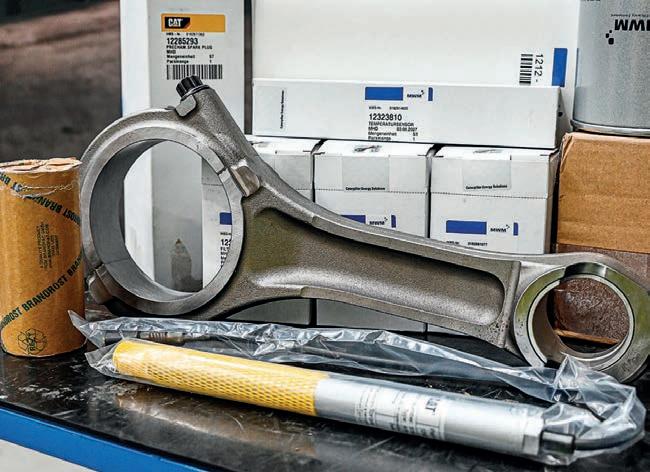
“In a world where reliability, agility and innovation are paramount, EPSA stands alone as the after-market service provider of choice for MWM and Cat CG generators,” Riedel said.
“By investing in EPSA’s services, customers gain not only superior support but a partner dedicated to their longterm success.
“By lowering emissions, improving energy efficiency, supporting workforce and community wellbeing, and ensuring compliance with evolving standards, these generators empower mines to operate responsibly and competitively in a rapidly changing world.”
EPSA’s national service network, combined with its in-house technical expertise and $1.5 million in genuine MWM and Cat CG parts inventory, mean customers can access timely, reliable support wherever they operate.
“Our customers rely on us to protect their investment in MWM and Cat CG technology,” Riedel said.
“That’s why we focus so heavily on model-specific knowledge, genuine parts, and factory-certified processes, because anything less compromises performance and lifecycle value.”

EPSA technicians are trained exclusively on MWM and Cat CG generators and work with them every day, giving them the familiarity required to diagnose and resolve issues. This hands-on experience is backed by specialised factory tooling and technical data to which unauthorised providers don’t have access.
EPSA supports its customers throughout the full asset lifecycle, from commissioning and site integration to ongoing maintenance and rebuild planning. This helps reduce longterm operational risk while optimising efficiency, fuel usage and emissions
“Partnering with an authorised MWM and Cat CG service provider gives customers much more than peace of mind,” Riedel said. “It provides access to the latest technical updates, extended maintenance intervals, and the assurance that every part is designed, tested and supported to work seamlessly with their generator.”
For mine operators navigating increasingly complex environmental and operational demands, EPSA’s offering presents a compelling proposition: a trusted, single-source partner that can help future-proof energy reliability while driving down cost and risk. AM







Our vision is to make processing minerals more efficient and less impactful on the environment. Our innovative flotation technologies are changing the way mineral processing plants are designed.
Leap Forward with Eriez.
The Eriez StackCell® delivers unparalleled ultra-fine particle recovery and higher concentrate grades while drastically reducing circuit size and power consumption.





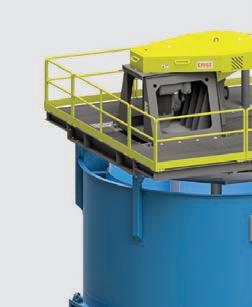

WITH THE DEMAND FOR SKILLS IN THE MINING INDUSTRY EVOLVING, VOCATIONAL TRAINING IS INCREASINGLY VITAL TO KEEPING AUSTRALIA AT THE FOREFRONT OF FUTURE EMPLOYMENT.

The mining industry is going through a skills revolution across all aspects of operations. With autonomous machinery becoming commonplace and technology evolving to provide greater environmental and sustainability benefits, workers of the future will need an even greater ability to work with both machines and people.
With skills shortages present in many vocational occupations across Australia, the fight for empowering excellence is now being fought on two fronts.
Jobs like engineering technologists, miners and fitter-welders are defined by the Federal Government as having shortages at regional and state level, emphasising the need to not only train people but also ensure retention.
Since 1981, WorldSkills Australia has championed excellence in vocational, technological and service-oriented careers, helping more than 100,000 people compete in regional, national and international skill competitions – and the organisation isn’t stopping there in its efforts to future-proof the next generation.
“It’s important that we showcase what’s emerging in industry and what’s changing. We work with industry leaders to make sure that whatever skills we showcase are at the forefront of what industry really wants,” WorldSkills Australia general manager Brigitte Collins told Australian Mining
“At the 2025 National Championships and Skills Show in Brisbane, we had
school children coming back with their parents and many are sometimes apprehensive when it comes to taking up a certain vocation, then they see the robotics and technology that come with many of our skills that we showcase and they’re on board.”
WorldSkills is using changing demands in mining – as well as wider manufacturing and resources industries – to encourage the future workforce to take up vocational training.
“Take electrical control or PLC programming, for example, what we call mechatronics,” Collins said.
“We understand that industries like mining are becoming more autonomous, more technologically focused, and we’ve adapted to that. We then, of course, showcase those more traditional skills like welding and fitting, some of which also showcase new technologies such as AR welding.
“With the push from the Federal Government in the importance of skills and the need for more young people to take up these vocational courses as an alternate pathway to going to university, we’re seeing young people become more actively involved in these skills, as well as parents seeing it as a genuinely viable long-term career.”
One way these skills are showcased is through the world’s largest skills competition, WorldSkills International, which will be held in China in 2026.
“We punch above our weight, which is a testament to the quality of training we have here in Australia,” Collins said.


“Last time, in Lyon in 2024, we came 14th in the world out of 63 members. But it’s not just about winning medals; there are medallions for excellence which show competitors are in the top half of skills excellence worldwide.”
The 48th WorldSkills will be held in Shanghai from September 22–27, 2026. Team Australia features 39 young apprentices, trainees and professionals who will compete against more than 1400 peers from over 60 countries across 35 different skills.
The team even has the backing of Prime Minister Anthony Albanese, who met its members at Parliament House in September, where he spoke with them about their aspirations.
“Meeting the Prime Minister was a great experience for the team and shows that Australia really supports its vocational workers,” Collins said.
“We set a high bar in some of the skills on show at competition, which we’re really proud of.”
The benefits of these events? Showing the world what Australia has to offer the future of industry.
“These competitions are great as a benchmark for where Australian industry is excelling and where we need to improve offerings for the future. If we keep investing, we can stay at the forefront,” Collins said.
“We’re bringing the best athletes in skills together to show who is leading the way. It’s important for us because we can bring that back to see definitively where the gaps are and helps training providers see what we’re doing consistently well and where we need to improve.
“These events celebrate success but also showcase how we can futureready our training and industry to be leaders, much like we are with welding currently.”
With training going well and skills being benchmarked as some of the best in the world, the future of Australia’s mining industry is in good hands. AM





















Read the whitepaper to learn how wear protection technology can maximise equipment uptime.
Scan QR code to read the whitepaper


THE 2026 EDITION OF QME IS SET TO BE ITS MOST COMPREHENSIVE EVER, HIGHLIGHTING THE STRENGTH AND DEPTH OF AUSTRALIA’S MINING INDUSTRY.
The Queensland Mining & Engineering Exhibition (QME) has long been recognised as the largest and most influential regional mining event in the state, and the 2026 edition is shaping up to be the best yet.
Building on the success of 2024, which attracted more than 5000 visitors and featured hundreds of suppliers over three days, QME continues to cement its reputation as the ultimate meeting place for mining professionals in Queensland and beyond.
The event has become synonymous with innovation and excellence, with each edition bringing together an unmatched cross-section of the mining supply chain. For companies seeking to showcase their products, services and expertise, the event provides exposure to mining decision-makers and contractors operating in one of Australia’s most important mining regions.
The exhibition floor will again feature hundreds of exhibitors demonstrating the latest equipment, technologies and solutions tailored to the unique challenges of Queensland’s mining operations. From emerging suppliers to global brands, QME offers a comprehensive picture of the industry’s current and future capabilities.
Beyond the exhibition, QME offers visitors opportunities to learn, share knowledge and stay ahead of industry trends. A highlight of recent editions has been the free-to-attend leadership series, which returns in 2026 to address the pressing needs of the industry. This program delivers insights across a wide range of mining functions, from operational efficiency to workforce development and safety, designed to ensure attendees leave with practical strategies they can implement directly within their businesses.
One of the key features of QME 2026 will be the Mining Pavilion, a dedicated hub for the Queensland industry. This central platform will bring together major miners, contractors and project owners to showcase their latest initiatives and innovations. The pavilion is designed to give suppliers and visitors a direct line of sight into the priorities and opportunities emerging across the sector.

efficiency and meet their environmental and social governance commitments.
The QME experience is about more than just exhibitions and presentations; it’s also about connecting with peers and celebrating industry achievements.
The Opening Party on the first day of the event will set the tone for three days of networking, collaboration and discovery, offering a relaxed environment for attendees to reconnect and form new partnerships.
“It’s where the entire sector – from operators to innovators – comes together to connect, collaborate and showcase what’s next,” Prime Creative Media marketing manager – mining events Rebecca Todesco said.
“There’s a certain energy when the industry gathers in one place for QME that comes from shared challenges, bold ideas and a collective drive to lead the way forward.”
Coinciding with QME is the prestigious Bowen Basin’s Queensland Mining Awards. This gala dinner recognises the innovation, excellence and collaboration driving Queensland’s

competitive mining industry. The evening provides an opportunity to acknowledge outstanding achievements while bringing together leaders from across the state’s mining community.
The strength of QME lies in its close partnership with industry. The event’s current sponsors include Pirtek and Hitachi, while association partners such as the Bowen Basin Mining Club and the Queensland Resources Council ensure the program remains aligned with the priorities of the sector. These collaborations reinforce QME’s role as
a trusted platform for advancing the industry’s collective goals.
With a track record of delivering value to exhibitors and visitors alike, QME has firmly established itself among the premier mining showcases in the country. The 2026 edition will build on this legacy with a program that celebrates the sector’s achievements and also equips it for the future. AM
For more information about exhibiting and to secure your place now, visit queenslandminingexpo.com.au
AUSTRALIA’S BULK HANDLING SECTOR IS GEARING UP AS THE INDUSTRY’S FLAGSHIP EVENT RETURNS WITH RENEWED ENERGY, BROADER SCOPE AND A FOCUS ON THE FUTURE
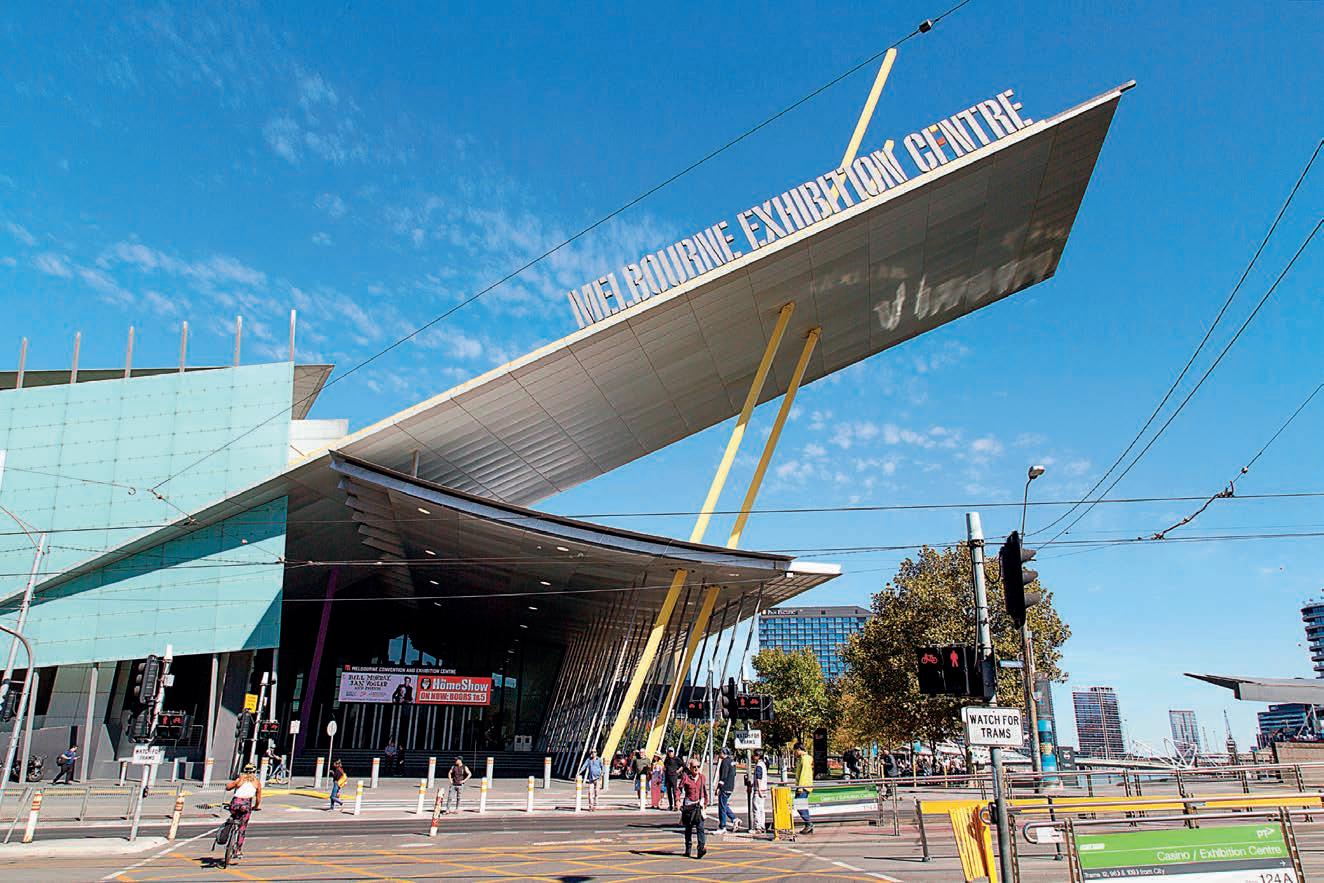
The Bulk Handling Technical Conference and Expo is returning in 2026 with a fresh new format that blends the exhibition floor with a world-class technical conference.
To be held at the Melbourne Convention and Exhibition Centre from September 16–17, 2026, this biennial event will connect leading suppliers with senior decisionmakers, engineers, operators, procurement professionals and contractors from across the country.
The newly added conference is curated by the experts at the Australian Society for Bulk Solids Handling (ASBSH), exploring the latest research, practical case studies and innovations shaping the future of bulk material handling across industries such as mining, agriculture, ports, food processing, construction and manufacturing.
Attendees will be able to learn about everything from bulk solids behaviour and storage design to conveying solutions, dust control and process optimisation.
Bulk 2026 will tackle some of the most significant challenges facing the sector today: supporting food security and agricultural productivity; driving sustainable
operations and emissions reduction; embracing automation and digitalisation; improving infrastructure and supply chain resilience; and fostering skills development and workforce safety.
The conference program will span a diverse range of topics, drawing senior engineers, researchers, consultants and global specialists together under one roof.
The Australian Bulk Handling Awards, the nation’s only awards program dedicated exclusively to bulk solids handling, will also be returning in 2026.
This prestigious evening celebrates innovation, excellence and leadership, offering a relaxed networking environment where industry peers come together to recognise outstanding achievements and set new benchmarks.
Want to stand out?
Sponsoring the awards provides organisations with unparalleled visibility alongside industry leaders and key decision-makers.
Prime Creative Media general manager – events Siobhan Rocks said Bulk 2026 promises to be the mustattend event for the industry.
“Bulk 2026 is all about bringing the industry together, showcasing innovation, sharing knowledge and
WHETHER YOU’RE AN ENGINEER, OPERATOR OR SUPPLIER, BULK 2026 OFFERS INSIGHTS AND CONNECTIONS THAT YOU SIMPLY CAN’T GET ANYWHERE ELSE.”
celebrating the people and projects driving bulk handling forward,” Rocks said.
“Whether you’re an engineer, operator or supplier, Bulk 2026 offers insights and connections that you simply can’t get anywhere else.”
Don’t miss Australia’s premier destination for bulk handling innovation, knowledge exchange, and industry leadership. AM
For more information, visit bulkhandlingexpo.com.au



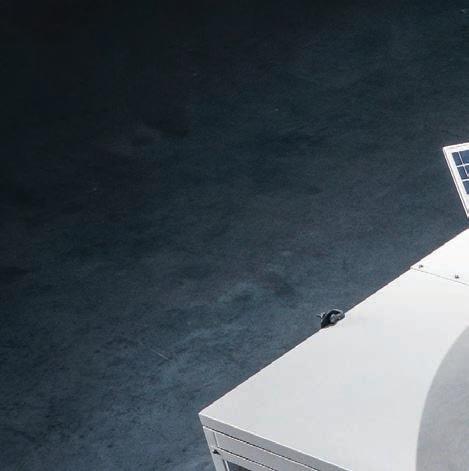






Energy Power Systems Australia (EPSA) sell, rent, engines, generators and power solutions – from individual units to multi-megawatt power stations – to customers in


Energy Power Systems Australia (EPSA) sell, rent, design, engineer and commission Cat® engines, generators and custom-built power solutions – from individual units to multi-megawatt power stations – to customers in every industr y.
Whatever your energy and requires, EP
Whatever your energy and power requires, EPSA’shas the power you need.

CONVEYOR COMPONENTS BUILT A PRODUCT PORTFOLIO THAT ADDRESSES KEY CHALLENGES OF MATERIAL HANDLING.

WITH SIX DECADES OF EXPERIENCE BEHIND IT, CONVEYOR COMPONENTS COMPANY HAS A REPUTATION FOR RELIABILITY IN SOME OF THE HARSHEST MINING ENVIRONMENTS.
When a worker’s wellbeing is at stake, reliability is not negotiable.
That is where Conveyor Components Company has staked its reputation.
Founded in Michigan in 1965, the family-owned business has grown into a global supplier of conveyor monitoring and safety controls, while still manufacturing from its US base.
Over the decades, the company has built a product portfolio that addresses the key challenges of material handling across industries. For the mining sector, that means equipment that can withstand dust, vibration, heavy loads and extreme weather while delivering a rapid response in emergencies.
The company’s core products include safety stop switches, belt alignment controls, pull cord switches, tilt switches, level controls and plugged chute detectors.
Each product is designed with one goal in mind: to protect people, equipment and productivity.
Belt alignment controls, for instance, detect when a conveyor belt begins to run off centre, which can quickly
escalate into costly downtime or catastrophic belt damage.
Pull cord switches, often called safety stop switches, provide workers with an immediate way to shut down a conveyor in an emergency, no matter where they are along the line.
Tilt switches and level controls ensure bulk material is flowing as it should, while plugged chute detectors prevent blockages that can lead to spillage, fire or extended downtime.
Conveyor Components sales manager
John Carlson told Australian Mining that what sets the company apart is not just the breadth of its range, but the rigour of its manufacturing and testing processes.
“We’re ISO 9001-certified, but certification is just the starting point,” Carlson said. “Every single switch we manufacture is tested numerous times

THE COMPANY HAS GROWN INTO A GLOBAL SUPPLIER OF CONVEYOR MONITORING AND SAFETY CONTROLS.

before it leaves our facility. There is no unit that will ever leave our facility that is not tested.”
Unlike assembly operations, Conveyor Components machines most of its parts in-house. Castings, housings and other key components are manufactured and finished in Michigan, ensuring the company controls quality from start to finish.
This approach, Carlson said, has resulted in an almost indescribably low issue rate.
“Because we’re not relying on outsourced parts, we can be confident in the integrity of every single unit,” he said. “Because every device is tested repeatedly, customers can trust that when it is installed on-site it will perform exactly as needed.”
Feedback from the field plays an equally important role in shaping the product line.
“We listen to our distributors and dealer network,” Carlson said.
“If they’re seeing a concern or requesting an improvement, we can adjust on the fly. Our engineering team ensures that any change is a 100 per cent improvement.”
That customer-driven approach has helped the company refine its
products for some of the world’s toughest environments.
Australian mine sites, with their remoteness, abrasive ores and extreme temperatures, are among those environments. The company’s thirdparty certifications serve as another assurance for miners.
“We meet CUL and NEMA-type ratings, which means our devices are tested for specific hazards, whether that is dust, water ingress or explosive atmospheres,” Carlson said.
“Those standards give customers confidence the switches will work when they are needed most.”
In mining, the stakes could not be higher. A malfunctioning switch is not just a matter of downtime, it can be the difference between safety and disaster.
Carlson said that is why quality has always been at the heart of Conveyor Components’ mission.
“At the end of the day, when someone is in a precarious situation, our device has to work,” he said. “That’s why quality is and always will be, the most important part of what we do.”
The company’s longevity also reflects its ability to adapt to customer needs quickly. Unlike manufacturers that build to order, Conveyor Components
produces inventory in advance and ships from stock.
That means, according to Carlson, the company can meet urgent orders much faster.
“Our business model is to build and ship from stock,” he said.
EVERY SINGLE SWITCH WE MANUFACTURE IS TESTED NUMEROUS TIMES BEFORE IT LEAVES OUR FACILITY. THERE IS NO UNIT THAT WILL EVER LEAVE OUR FACILITY THAT IS NOT TESTED.”
“Right now, I’m closing major projects and shipping within five business days.”
That responsiveness is particularly important for mining companies, where downtime is measured in millions of dollars per day.
For Australian miners operating in remote regions, the ability to receive safety-critical equipment in a matter of days rather than weeks can be the
difference between staying on schedule or halting production.
Conveyor Components’ family ownership has also played a role in its steady direction. Founded by an engineer in the mid-1960s, Conveyor Components remains a multi-generational business, with the founder’s son now serving as general manager.
Carlson said that continuity gives the company both deep institutional knowledge and a long-term perspective on customer relationships.
From its beginnings in Michigan to its current global footprint, Conveyor Components has built its reputation on one principle: a product is only as good as its ability to perform when it matters most.
As the resources sector continues to push deeper, faster and harder for the resources the world needs, Conveyor Components Company is positioning itself as the quiet but critical player keeping conveyors safe and reliable.
“Sixty years in, we’re still focused on the same thing we started with, making sure our devices protect people and equipment,” Carlson said.
“That commitment hasn’t changed, and it won’t.” AM
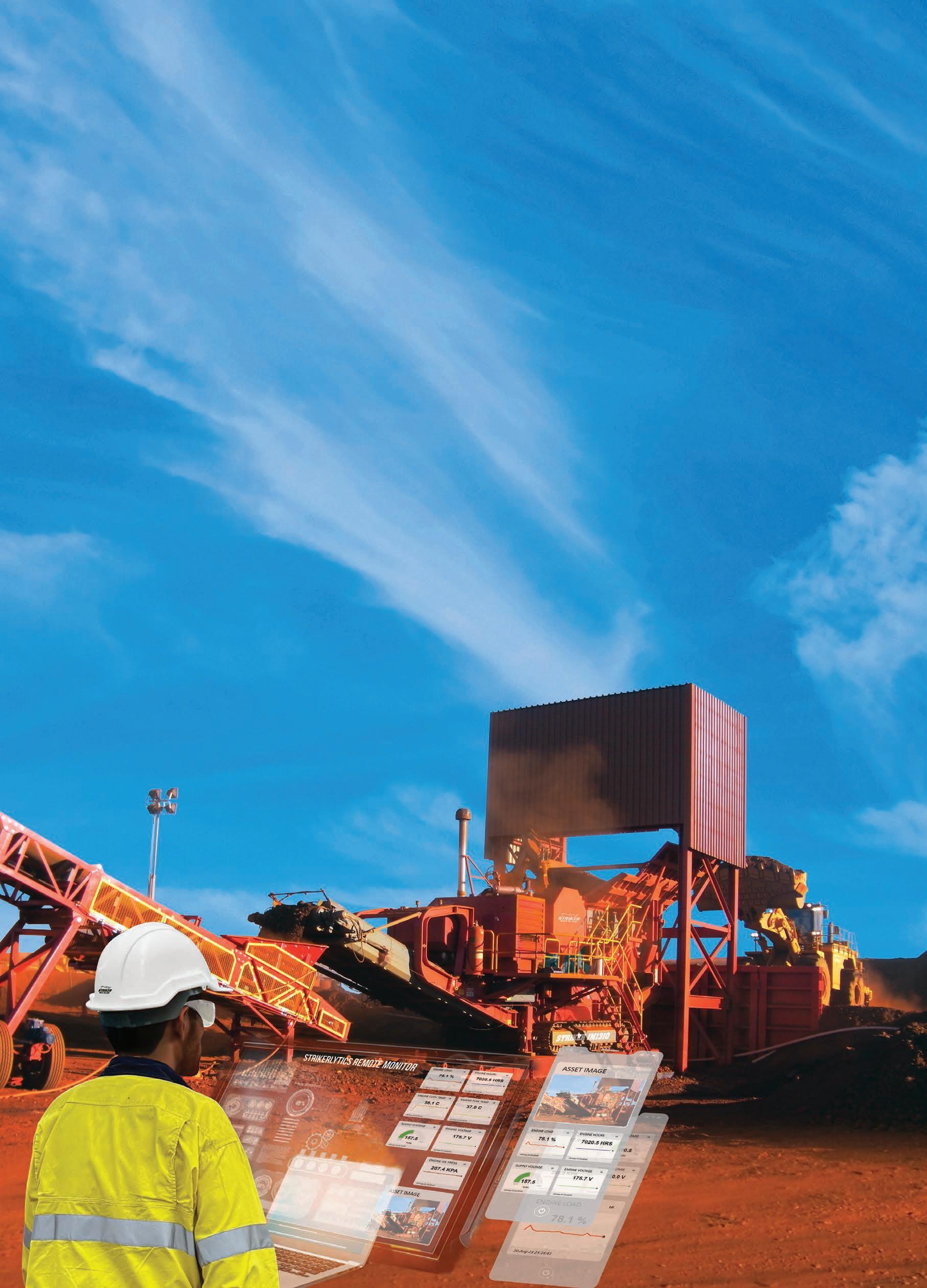

AS ITS WAR AGAINST INCREASINGLY SOPHISTICATED COUNTERFEITS RAMPS UP.
When Australian Border Force officers flag imported shipments of suspected counterfeit engine parts, the contents often look legitimate at first glance. Cummins-branded cylinder liners are well-packed and come complete with official packaging, barcodes and part numbers.
But trained eyes can spot the telltale signs: slightly off colours on the labels, marginally different fonts, and packaging that feels just a fraction too light. These kinds of issues mean the shipment is likely part of the $US500 billion counterfeit parts industry that is affecting manufacturers and buyers alike.
Cummins is working hard to fight the scourge, and one part of its strategy is to work with customs officials around the world. The company has trained more than 300 Australian Border Force personnel across four capital cities to identify fake components from its range. Together with work on technology and customer education, it aims to protect mining operations from the costly consequences of non-genuine parts.
Cummins’ latest global initiative uses holograms to support its wider anti-
counterfeiting efforts. The development of holograms, the effects of which cannot be completely replicated or simulated by normal printing methods, has introduced a new level of brand protection for the manufacturer’s genuine parts.
“Counterfeiters are becoming so sophisticated that their parts look like the original, even down to their labelling, packaging, barcodes and QR codes,” Cummins aftermarket business development manager – mining Kyle Miller said. “Many consumers are misled into thinking they are buying the genuine article.”
To differentiate from counterfeit products, Cummins’ new labels feature a company-specific hologram and a verification website. Customers can scan a QR code on the label to reach the site and confirm authenticity.
The risk of using counterfeit parts in high-horsepower diesel engines recently hit home at a mining operation in Western Australia. An 1800-horsepower Cummins K50 engine failed at only 6000 hours powering an excavator, when it would have been expected to clock up to 16,000 hours after midlife maintenance at 8000 hours.
Teardown of the 50L V16 engine showed destruction inside one cylinder. The reason was clear: counterfeit parts, including the cylinder liners, had been used by a third-party repairer to rebuild the K50 at an early stage in its life.
“At the end of the day, you get what you pay for with quality products,” Miller said.
“If you want to take risks to save a few dollars, you are likely to incur greater losses in business impact through downtime or performance issues.”
The downfall of using an unauthorised Cummins repairer to cut costs was clear to the customer, with the engine requiring complete replacement well before its expected service life.
This is not an isolated incident, as Cummins research has shown.
The company engaged an engineering team to carry out extensive testing of 106 non-genuine parts from the QSK engine series. These parts were put through the same rigorous test procedures Cummins uses to manufacture genuine parts.
The results were stark. Many failed on visual inspection, some failed because the metal was too soft or brittle, and other parts failed for different reasons. Test results confirmed every part category failed in measurement
or material inspection, compared to Cummins standards.
One example of the difference was with connecting rod bushings. For QSK45 and QSK60 engines, Cummins only sells bushings with the connecting rod to ensure quality, durability and a precise fit. Competitors sell the parts separately, ignoring Cummins engineering requirements.
“Cummins high-horsepower genuine parts sourced from the extensive network of Cummins branches in Australia and New Zealand are the only parts approved and warrantied by Cummins,” Miller said.
With counterfeit units increasingly being sold as genuine Cummins parts worldwide, with sophisticated reproductions making it incredibly difficult for even trained eyes to distinguish real from fake, the company’s engagement with Australian Border Force, combined with hologram technology and ongoing customer education, represents a comprehensive approach to protecting the integrity of mining operations across the country. AM


Across Australian mine sites, the push to lift productivity while improving safety and cutting emissions is increasing by the day.
Komatsu’s SmartCare program meets this challenge head-on, combining remote technology, predictive analytics and on-the-ground expertise to help mines from the Pilbara to the Bowen Basin work safer, smarter and more sustainably.
Turning data into action
Komatsu Australia executive general manager for mining Leo Kaloglou told Australian Mining that SmartCare stands out for its focus on turning data into actionable insights, backed by a dedicated team of product managers.
“These experienced experts work in the platform day in and day out, interpreting data outputs – from predictive diagnostics to anomaly detection and machine-learning insights – and turn them into clear, actionable steps that improve site performance and reliability,” Kaloglou said.
“Some of the things we can detect and notify customers about include emerging engine issues before alarms are raised, operator misuse, underperforming hydraulic pumps, or grease systems not
“By working closely with our customers on site, we’ve seen real gains in fleet performance, including savings of up to 1000 operating hours in a year on frontline loading units.”
Mining is high-stakes work and reducing risk is always a priority – this is where SmartCare comes into its own.
“SmartCare plays a safety role by removing the need for manual inspections like hoist or steering system pressure checks, replacing them with real-time machine-captured data that reduces site exposure hours and human error,” Kaloglou said.
Fewer hours spent on repetitive, highrisk tasks means fewer opportunities for accidents and greater confidence that equipment is being monitored accurately around the clock.
Driving ESG and efficiency goals
Safety isn’t the only benefit. SmartCare is also helping mines hit their environmental, social and governance (ESG) targets by optimising machine use and extending component life.
With insights on payload, idle time, utilisation and servicing, SmartCare cuts down on unnecessary maintenance, trims fuel burn and stretches component longevity. That means less waste, fewer emissions and reduced costs.
“As changes for mandatory ESG reporting come into effect, programs
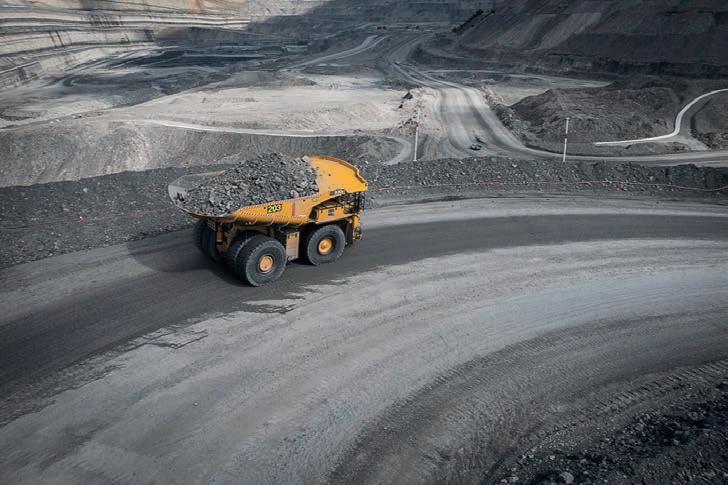
them report, monitor and manage their emissions,” he said.
By improving payload efficiency, reducing unplanned downtime and automating data capture, SmartCare helps operators squeeze more value out of every tonne while minimising environmental impact.
But technology alone cannot solve mining’s challenges. What makes SmartCare powerful is the way it blends digital intelligence with human know-how.
Komatsu’s product performance managers and technical specialists bring context, experience and collaboration to

“We have 16 SmartCare team members overseeing 63 sites and 1300 mining machines across Australia,” Kaloglou said.
“It’s a big job but one that’s delivering real value for our customers.
With insights on payload, idle time, utilisation and servicing, SmartCare cuts down on unnecessary maintenance, trims fuel burn and stretches component longevity. That means less waste, fewer emissions and reduced costs.
SmartCare is already reshaping the way fleets are maintained and monitored, but Komatsu is looking ahead to even more responsive systems.
“While today’s analytics run in the cloud, we’re preparing for the next phase of SmartCare – real-time onboard diagnostics,” Kaloglou said.
This next step will see machines alert operators instantly to harmful behaviours or emerging faults, allowing them to prevent issues before they happen.
Real-time feedback could dramatically cut downtime, extend machine life and keep safety standards at their peak.
“With advanced analytics built into the machine, we can detect emerging issues faster and provide real-time feedback to operators,” Kaloglou said.
“It’s about turning data into digital coaching that helps prevent problems before they happen.”
SmartCare is about more than maintenance; it’s a partnership that helps customers run their operations safer, smarter and more sustainably.
As demand and ESG pressures rise, it shows that productivity and responsibility can work in tandem. AM









LIEBHERR CONTINUES TO LEAD THE WAY IN GIVING MINERS THE EDGE WITH ITS NEW HYDROSTATIC DOZER.
Simple though it sounds, dozers are crucial in the mining industry for their ability to move large volumes of material, assisting in construction, maintenance and clearance.
Alongside trucks and loaders, dozers play a key role on mine sites by taking on much of the grunt work of pushing and excavating valuable material. For this reason, the smallest of innovations in dozer design can make a big difference to the efficiency of a mining operation.
For over 50 years, Liebherr has been manufacturing and designing mining machinery that adds value and can be adapted to specific requirements. The
THE LIEBHERR PR 776 G8 IN ACTION.
company describes its new hydrostatic dozer as the world’s largest.
The PR 776, described as “instrumental in adapting to the Australian climate and mining conditions”, rips, pushes, stockpiles and clears mines across the globe, providing customers with efficiency and constant power.
The advanced design transfers power from hydraulic pumps to motors, and then to the final drives, ensuring constant positive power to the undercarriage and excellent manoeuvrability with the durable heavy-duty design of the main frame, a key advantage in demanding mining environments.




The Generation 8 dozers offer significantly increased performance thanks to operator assistance systems and a hydrostatic transmission that reduces the rate of fuel burn.
Weighing in at 70 tonnes and boasting a blade capacity of between 18.5–22m3, the PR 776 offers fast component replacement, load sensing working hydraulics and long service intervals – up to 8000 hours in some cases – to give operators unrivalled efficiency.
“Fuel efficiency is critically important to help minimise a site’s environmental footprint and carbon emissions, reducing operational costs and minimising downtime for equipment,” Liebherr
national mining sales manager Travis Lloyd told Australian Mining
“In head-to-head trials against competition, we have seen results of over 20 per cent fuel saving in a like-forlike comparison.”
This efficiency is achieved through a 565-kilowatt (kW) engine output, offering 768 horsepower and travel speed of 10.5 kilometres per hour (km/h), as well as intelligent driveline and hydraulic systems to help ensure downtime is kept to a minimum.
The hydrostatic travel drive operates smoothly and automatically adjusts the working speed to the load conditions, with torque kept constant on both tracks
without interruption, allowing for exact and powerful steering.
“The nature of the Liebherr hydrostatic drive train allows the PR 776’s D9512 engine to operate at very stable revolutions per minute powering the hydraulic pumps and motors,” Lloyd said.
“This constant load on the motor allows very fuel-efficient operation. Less fuel burn means reduced carbon emissions, lower operating costs, and improved ESG [environmental, social and governance] outcomes.
“When working in narrow areas, the hydrostatic travel drive offers exceptional manoeuvrability, with the machine’s




ripper able to be positioned precisely to enable it to apply greater power when ripping layers of hard rock.
“The hydrostatic drive delivers smooth ‘stepless’ power and is highly manoeuvrable. This, combined with Liebherr’s assistance system technology, provides operators with a level of control that is unmatched across the 70-tonne dozer market.”
With quality, reliable and innovative technologies backed by years of experience in the field, it’s no surprise Liebherr is leading the way in making mining operations safe and cost effective – even under the toughest of conditions. AM
















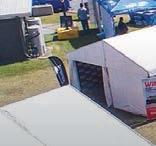













Rio Tinto and its partners are set to inject around $1.11 billion ($US733 million) into the West Angelas Sustaining Project, recently securing the long-term future of one of the Pilbara’s key iron ore hubs.
The project, part of the Robe River Joint Venture (RRJV), has received all necessary state and federal approvals, paving the way for continued production and employment in the region.
Rio Tinto will contribute $588 million under the investment agreement, while venture partners Mitsui and Nippon Steel will provide the remaining funds.
The West Angelas Sustaining Project is designed to develop new iron ore deposits within the existing West Angelas hub, maintaining its total annual production capacity of 35 million tonnes and ensuring mining activity in the region for years to come.
Rio Tinto anticipates that construction will generate approximately 600 jobs, with the operational phase sustaining a workforce of roughly 950 full-time-equivalent roles at the hub.
Rio Tinto Iron Ore chief executive Matthew Holcz emphasised the significance of collaboration in bringing
ensuring environmental and cultural responsibilities are upheld,” Holcz said.
The West Angelas Sustaining Project forms part of Rio Tinto’s suite of replacement projects in the Pilbara, which collectively support a combined production capacity of around 130 million tonnes per annum. These initiatives are designed to sustain the company’s contribution to global iron ore supply while providing long-term employment and economic opportunities in Western Australia.
Beyond West Angelas, Rio Tinto is progressing a pre-feasibility study for Rhodes Ridge, one of the world’s largest undeveloped iron ore deposits. Targeting an initial capacity of up to 40 million tonnes per annum and first ore by 2030, Rhodes Ridge represents a continuation of the company’s strategy to ensure a robust, sustainable presence in the Pilbara for decades to come.
The West Angelas Sustaining Project also illustrates the increasing sophistication of mining operations in the region. Autonomous haulage systems, carefully planned environmental management strategies, and close collaboration with Traditional Owners are now core components of modern Pilbara projects. These factors
helping to ensure that social, cultural and environmental responsibilities are integrated into the mining lifecycle. The project represents a major economic boost for the Pilbara region. The combination of construction jobs, long-term operational roles, and local supply chain engagement will support communities while reinforcing the area’s status as a global iron ore powerhouse.
With the West Angelas Sustaining Project now officially greenlit, Rio Tinto and its partners are poised to continue delivering high-quality iron ore while maintaining commitments to sustainability, community, and cultural heritage. The project is a signal that the Pilbara remains at the heart of Australia’s mining industry, and longterm investment in the region continues to underpin global supply chains. AM
RIO TINTO IRON ORE CHIEF EXECUTIVE MATTHEW HOLCZ SAID WEST ANGELAS HAS BEEN INTEGRAL TO THE COMPANY SINCE 2002.



EVENT SUBMISSIONS CAN BE EMAILED TO PAUL.HAYES@PRIMECREATIVE.COM.AU
Global Resources Innovation Expo Perth | May 5–7, 2026
The Global Resources Innovation Expo (GRX) is an industry-led conference and exhibition hosted by Austmine in partnership with AusIMM. It represents an exciting evolution from past Austmine conferences, with GRX26 building off the successful running of GRX25 in May, which connected attendees with global leaders, allowing them to discover cutting-edge solutions and engage in insightful discussions. GRX26 will feature some of the most influential voices in technology, emerging industries, mining and resources.
• grx.au
Critical Minerals Australia Conference and Exhibition Perth | May 20–21, 2026
The Critical Minerals Australia Conference and Exhibition is Australia’s longest running international critical minerals, investments, clean energy and technologies show, bringing the entire mineral resources value chain together in Perth.
The event will examine all aspects of mining exploration opportunities, financing options, development of new technologies, security of sustainable supply chains, First Nations and
community engagement, ESG practices, processing, recycling and batteries, and more.
• criticalmineralsaustralia.com
PNG Industrial and Mining Resources Exhibition and Conference
Port Moresby | July 1–2, 2026
The PNG Industrial & Mining Resources Exhibition (PNG Expo) delivered a record-breaking edition in 2025, attracting more attendees than ever before.
The event saw more than 80 local, national and international manufacturers and suppliers showcase the latest innovations for the industrial, mining, and oil and gas sectors.
The exhibition will return again in 2026, providing the perfect meeting place to connect and network with thousands of industry decisionmakers across a broad industry reach, including senior management, procurement, government personnel, engineers, contractors and trade technicians.
With extensive support from key stakeholders in government, associations and industry, PNG Expo is a premier meeting place for industry trade and a forum for establishing high-quality customer contacts and conducting business.
• pngexpo.com
Queensland Mining & Engineering Exhibition Mackay | July 21–23, 2026
With a legacy spanning over 30 years, the Queensland Mining & Engineering Exhibition (QME) is Australia’s largest regional mining event.
Following a record-breaking 2024 edition, QME returns to Mackay from July 21–23, 2026, promising even more exhibitors, expanded content, and new networking opportunities. Featuring live demonstrations, a free leadership series, and hundreds of suppliers, QME is a vital hub for innovation, industry connection and regional growth.
QME 2026 is shaping up to be the most impactful edition yet, with many suppliers already signed up to participate after a strong rebooking phase.
• queenslandminingexpo.com.au
August 3–5, 2026
The Diggers & Dealers Mining Forum returns in 2026, combining corporate presentations by listed mining and exploration companies alongside a large exhibition area housing more than 150 exhibitors from the sector. Delegates include miners, explorers, brokers, bankers, investors, financiers and mining service industries from around the world.
Attendance for the 2025 event was 2600.
The event provides a unique opportunity for industry professionals to meet and network, visit regional mine sites, engage with media, raise finance, invest in projects and generally engage with the resources sector at an executive level in a mining community setting, Kalgoorlie, the unofficial gold mining capital of Australia.
• diggersndealers.com.au
Critical Minerals and Energy Transition Conference and Exhibition Sydney | August 11, 2026
Critical Minerals and Energy Transition Conference and Exhibition is Australia’s international renewable energy, critical minerals, green steel, hydrogen and technologies event, bringing together the whole energy and mineral resources value chain to Sydney. Critical minerals are essential to country’s security and economic prosperity and are key building elements of all advanced technologies
The event will showcase mining and energy companies, technology providers, downstream manufacturers, renewable energy, battery hubs and universities.
• australiaenergytransition.com







16-17 September 2026


EXHIBIT IN 2026. BE SEEN. BE HEARD. BE CHOSEN.










